
AGILE SOFTWARE
DEVELOPMENT
DHS Has Made
Significant Progress in
Implementing Leading
Practices, but Needs
to Take Additional
Actions
Report to Congressional Requesters
June 2020
GAO-20-213
United States Government Accountability Office
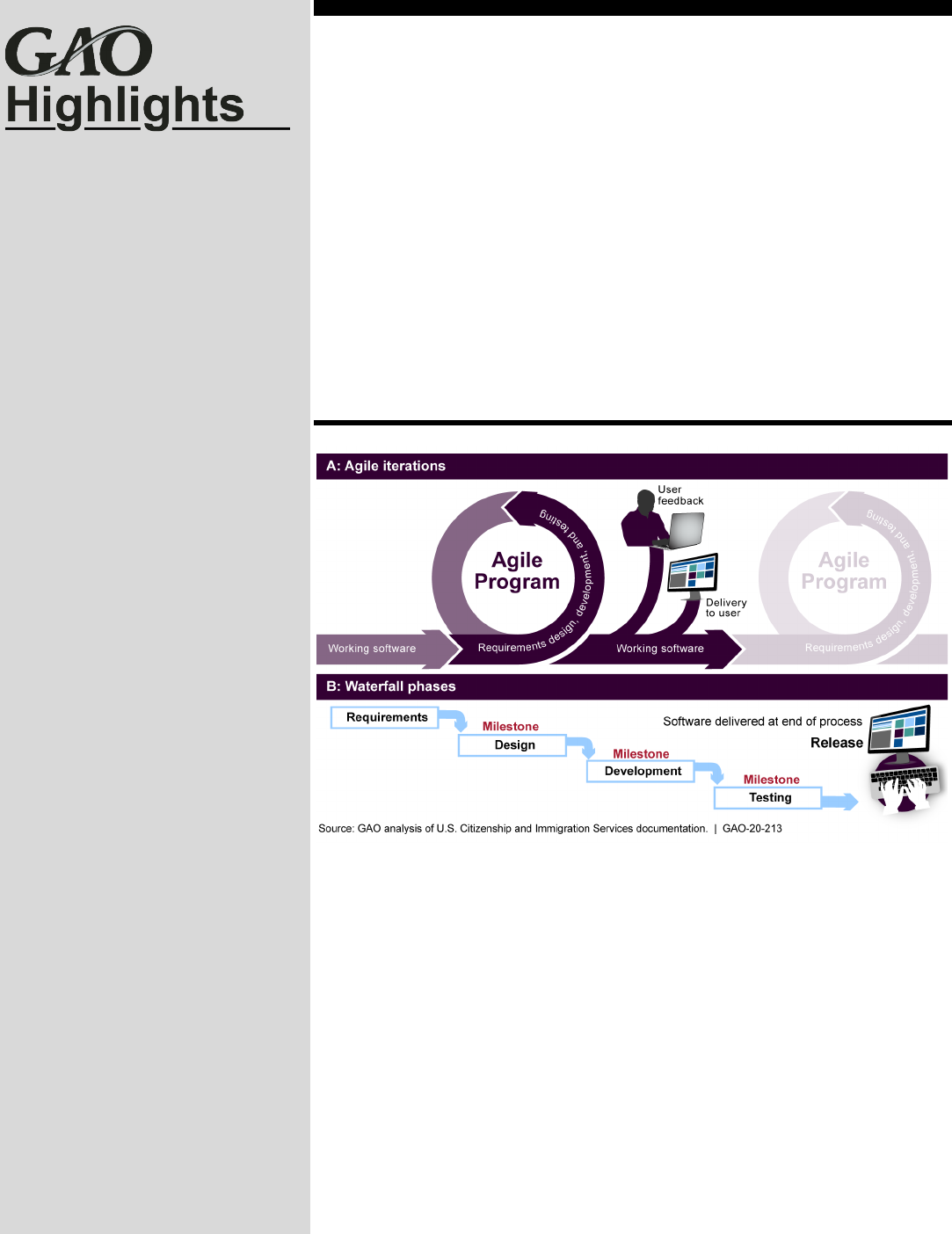
______________________________________ United States Government Accountability Office
June 2020
AGILE SOFTWARE DEVELOPMENT
DHS Has Made
Significant Progress in Implementing
Leading Practices, but
Needs to Take Additional
Action
s
What GAO Found
The Department of Homeland Security (DHS) has taken steps to implement
selected leading practices in its transition from waterfall, an approach that
historically delivered useable software years after program initiation, to Agile
software development, which is focused on incremental and rapid delivery of
working software in small segments. As shown below, this quick, iterative
approach is to deliver results faster and collect user feedback continuously.
Comparison of Agile and Waterfall Methods for Developing Software
DHS has fully addressed one of three leading practice areas for organization
change management and partially addressed the other two. Collectively, these
practices advise an organization to plan for, implement, and measure the impact
when undertaking a significant change. The department has fully defined plans
for transitioning to Agile development. DHS has partially addressed
implementation—the department completed 134 activities but deferred roughly
34 percent of planned activities to a later date. These deferred activities are in
progress or have not been started. With respect to the third practice, DHS
clarified expected outcomes for the transition, such as reduced risk of large,
expensive IT failures. However, these outcomes are not tied to target measures.
Without these, DHS will not know if the transition is achieving its desired results.
DHS has also addressed four of the nine leading practices for adopting Agile
software development. For example, the department has modified its acquisition
policies to support Agile development methods. However, it needs to take
additional steps to, among other things, ensure all staff are appropriately trained
and establish expectations for tracking software code quality. By fully addressing
leading practices, DHS can reduce the risk of continued problems in developing
and acquiring current, as well as, future IT systems.
Why GAO Did This Study
Many of DHS’s major IT acquisition
programs have taken longer than
expected to develop or failed to deliver
the desired value. In April 2016, to help
improve the department’s IT acquisition
and management, DHS identified Agile
software development as the preferred
approach for all of its IT programs and
projects.
GAO was asked to examine DHS’s
adoption of Agile software development.
The objective of this review was to
assess the extent to which DHS has
addressed selected leading practices for
its transition to the use of Agile software
development.
GAO identified leading practices for
planning, implementing, and measuring
organizational change that apply to
DHS’s transition to Agile through its
review of guidance published by the
Project Management Institute and GAO.
GAO also reviewed work it performed to
develop leading practices for Agile
software development adoption. GAO
analyzed DHS documentation, such as
policies, guidance, plans, and working
group artifacts and assessed them
against the selected leading practices.
GAO also reviewed the implementation
of selected practices within individual IT
projects. Finally, GAO interviewed DHS
officials to discuss any practices that
were not fully implemented.
What GAO Recommends
GAO is making 10 recommendations to
DHS to implement selected leading
practices for its transition to Agile
software development. DHS agreed with
GAO’s recommendations and described
actions taken and planned to address
them.
View GAO-20-213. For more information,
contact
Carol C. Harris at (202) 512-4456 or
harriscc
@gao.gov.
Highlights of GAO-20-213, a report to
congressional requesters

Page i GAO-20-213 Agile Software Development
Letter 1
Background 4
DHS Has Made Progress in Implementing Leading Practices, but
Has Not Fully Addressed Others 13
Conclusions 26
Recommendations for Executive Action 27
Agency Comments and Our Evaluation 28
Appendix I Objective, Scope, and Methodology 32
Appendix II DHS Agile Action Plans 39
Appendix III Leading Practices for Adopting Agile Development—Agency
Environment 50
Appendix IV Leading Practices for Adopting Agile Development—Program
Processes 67
Appendix V Leading Practices for Adopting Agile Development—Team
Activities and Dynamics 84
Appendix VI Comments from the Department of Homeland Security 103
Appendix VII GAO Contact and Staff Acknowledgments 107
Tables
Table 1: The Department of Homeland Security (DHS) Roles and
Responsibilities for Agile Development 10
Contents

Page ii GAO-20-213 Agile Software Development
Table 2: Levels of Agile Adoption and Leading Practices
Associated with Each Level 20
Table 3: DHS Agile Action Plan Title, Goal, Lead Organizations,
Level of Difficulty and Impact, and Executive Priority 40
Table 4: DHS Agile Action Plan Problem Statements and
Recommendations 43
Figures
Figure 1: Comparison of Agile and Waterfall Methods for
Developing Software 8
Figure 2: DHS Acquisition Life Cycle Framework (ALF) and
Systems Engineering Life Cycle (SELC) for Major
Acquisition Programs 52
Figure 3: Optional Tailoring of the DHS Acquisition Life Cycle
Framework (ALF) and Systems Engineering Life Cycle
(SELC) for Agile Major Acquisition Program 54
Abbreviations
ALF acquisition life cycle framework
BEE Biometric Entry Exit
C4ISR Command, Control, Communications, and Computers,
Intelligence, Surveillance and Reconnaissance
CBP U.S. Customs and Border Protection
CDR critical design review
CIO chief information officer
DHS Department of Homeland Security
EA enterprise architecture
EAB Enterprise Architecture Board
FITARA Federal Information Technology Acquisition Reform Act
ICE U.S. Immigration and Customs Enforcement
IRR integration readiness review
IT information technology
ITPM COE IT Program Management Center of Excellence
ITR initial technical review
JRC Joint Requirements Council
OCIO Office of the Chief Information Officer
OCTO Office of the Chief Technology Officer

Page iii GAO-20-213 Agile Software Development
ORR operational readiness review
OTRR operational test readiness review
PARM Office of Program Accountability and Risk Management
PDR preliminary design review
PIR post implementation review
PPR project planning review
PRR production readiness review
RCR release cycle review
RPR release planning review
SAR solution analysis review
SDR system definition review
SELC systems engineering life cycle
SEVIS Student and Exchange Visitor Information System
SPDR software preliminary design review
SPR study plan review
STM Strategic Technology Management
USCG U.S. Coast Guard
This is a work of the U.S. government and is not subject to copyright protection in the
United States. The published product may be reproduced and distributed in its entirety
without further permission from GAO. However, because this work may contain
copyrighted images or other material, permission from the copyright holder may be
necessary if you wish to reproduce this material separately.
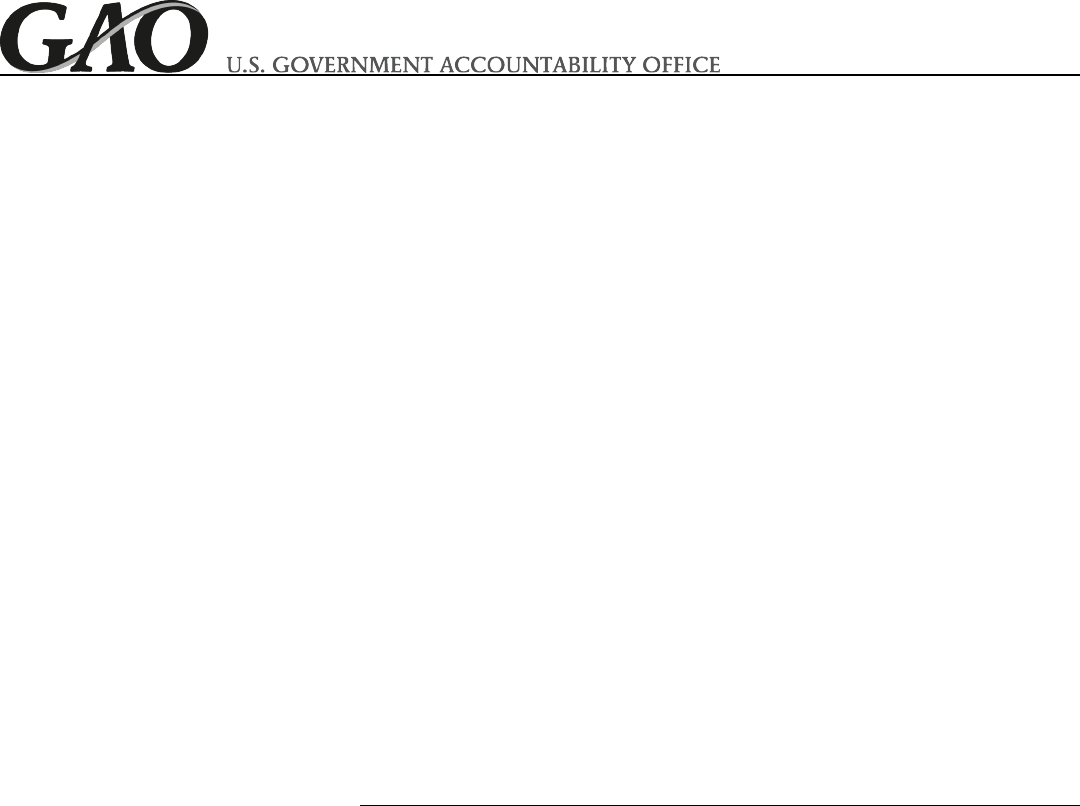
Page 1 GAO-20-213 Agile Software Development
441 G St. N.W.
Washington, DC 20548
June 1, 2020
Congressional Requesters
The Department of Homeland Security (DHS) and its components invest
billions of dollars each year to acquire information technology (IT) and
other capabilities to support the department’s critical functions. However,
as we have previously reported, many of the department’s major IT
acquisition programs have taken longer than expected to develop and
implement, or have failed to deliver the desired value to mission
operations.
1
As part of an effort to improve its IT acquisition and
management, in April 2016, the department identified Agile software
development as its preferred approach for all DHS IT programs and
projects. Such an approach—one form of incremental development—calls
for the rapid delivery of software in small, short increments.
You asked us to examine the department’s adoption of Agile software
development. Our specific objective was to assess the extent to which
DHS has addressed selected leading practices for its transition to the use
of Agile software development. To accomplish this objective, we
assessed the extent to which the department adhered to leading practices
1
See, for example, Homeland Security Acquisitions: Outcomes Have Improved but
Actions Needed to Enhance Oversight of Schedule Goals, GAO-20-170SP (Washington,
D.C.: Dec. 19, 2019); FEMA Grants Modernization: Improvements Needed to Strengthen
Program Management and Cybersecurity, GAO-19-164 (Washington, D.C.: Apr. 9, 2019);
U.S. Secret Service: Action Needed to Address Gaps in IT Workforce Planning and
Management Practices, GAO-19-60 (Washington, D.C.: Nov. 15, 2018); TSA
Modernization: Use of Sound Program Management and Oversight Practices Is Needed to
Avoid Repeating Past Problems, GAO-18-46 (Washington, D.C.: Oct. 17, 2017);
Homeland Security: Progress Made to Implement IT Reform, but Additional Chief
Information Officer Involvement Needed, GAO-17-284 (Washington, D.C.: May 18, 2017);
Immigration Benefits System: U.S. Citizenship and Immigration Services Can Improve
Program Management, GAO-16-467 (Washington, D.C.: July 7, 2016); Information
Technology: FEMA Needs to Address Management Weaknesses to Improve Its Systems,
GAO-16-306 (Washington, D.C.: Apr. 5, 2016); Homeland Security: Oversight of
Neglected Human Resources Information Technology Investment Is Needed,
GAO-16-253 (Washington, D.C.: Feb. 11, 2016); Immigration Benefits System: Better
Informed Decision Making Needed on Transformation Program, GAO-15-415
(Washington, D.C.: May 18, 2015); Border Security: DHS’s Efforts to Modernize Key
Enforcement Systems Could be Strengthened, GAO-14-62 (Washington, D.C.: Dec. 5,
2013); Information Technology: DHS Needs to Enhance Management of Major
Investments, GAO-13-478T (Washington, D.C.: Mar. 19, 2013); Information Technology:
DHS Needs to Enhance Management of Cost and Schedule for Major Investments,
GAO-12-904 (Washington, D.C.: Sept. 26, 2012).
Letter

Page 2 GAO-20-213 Agile Software Development
in two specific areas: organizational change management and Agile
software development adoption.
With regard to organizational change management, we reviewed leading
practices published by the Project Management Institute and GAO on
organizational change management.
2
Based on this review, we identified
fifteen leading practices. We then grouped these 15 practices into three
broad organizational change management areas: planning, implementing,
and measuring change.
To determine the extent to which DHS addressed leading practice areas
for organizational change management in its transition to Agile
development, we assessed DHS policies, procedures, guidance, plans,
and other working group artifacts and compared them against the leading
practices in the three areas. Our review also included analyzing DHS’s IT
Program Management Center of Excellence (ITPM COE) meeting
minutes, presentation slides, and status update charts. Further, we
interviewed officials from DHS headquarters lines of business to discuss
any practices in the three areas that were not fully addressed.
3
Specifically, we interviewed officials from the offices of the Chief
Procurement Officer, Chief Readiness Support Officer, Chief Financial
Officer, Chief Human Capital Officer, Chief Security Officer, the Chief
Information Officer (OCIO), Systems Engineer, and Test and Evaluation,
and the Joint Requirements Council.
With regard to leading practices for Agile software development adoption,
we reviewed work performed by GAO to develop generally accepted
leading practices. In developing these leading practices, GAO reviewed
information from a variety of sources related to Agile adoption and
compiled a draft of leading practices commonly mentioned across these
2
Project Management Institute, Inc., Managing Change in Organizations: A Practice
Guide, (Newtown Square, PA: 2013); GAO, Government Reorganization: Key Questions
to Assess Agency Reform Efforts, GAO-18-427 (Washington, D.C.: Jul 13, 2018); IT
Workforce: Key Practices Help Ensure Strong Integrated Program Teams; Selected
Departments Need to Assess Skill Gaps, GAO-17-8 (Washington, D.C.: Nov. 30, 2016);
Standards for Internal Control in the Federal Government, GAO-14-704G (Washington,
D.C.: Sept. 10, 2014).
3
Department of Homeland Security, Instruction 102-01-004. DHS defines the line of
business chiefs as officers at the department level with a set of one or more highly related
services (administrative, financial management, human resources, information technology,
procurement, and security), which include the Chief Procurement Officer, Chief Readiness
Support Officer, Chief Financial Officer, Chief Human Capital Officer, Chief Security
Officer, and the Chief Information Officer.

Page 3 GAO-20-213 Agile Software Development
different sources. We then convened a working group of experts from the
public and private sectors and academia. This working group met three
times a year between August 2016 and August 2019 to review and
discuss these leading practices. More than 200 experts participated in the
meetings, including more than 20 officials from DHS. GAO received
comments from many of these experts both during these meetings and by
email after the meetings.
Based on this work, GAO developed a set of nine leading practices for
Agile adoption. The leading practices were described by a series of core
elements and core element expectations that, collectively, can be used to
assess the status of an agency’s implementation.
To determine the extent to which the department had addressed the
leading practices for the adoption of Agile development, we obtained and
assessed DHS policies, procedures, guidance, plans, and other
documentation such as systems engineering life cycle (SELC) technical
review completion letters, and compared them against the nine leading
practices. This included supplementary Agile documentation, such as
training materials prepared by the Homeland Security Acquisition Institute
for acquisition workforce certifications and webinars offered by the
Procurement Innovation Lab. We also interviewed department officials
responsible for the associated policies, procedures, guidance, plans, and
other documentation to discuss any practices that were not fully
implemented.
To supplement our assessment of the extent to which the department
addressed program process, and team activity and dynamics-level
leading practices, we also assessed selected projects’ implementation of
these practices. We selected only the projects supporting programs on
the Major Acquisition Oversight List because DHS expects these
programs to comply with its Agile instruction and acquisition management
policy. We then further limited the scope of projects to those within
components where GAO had not previously assessed a program using
Agile methods or was not in the process of assessing such a program.
4
We further refined our selection based on the following criteria: software
development life cycle methodology (iterative development only) and
project completion date (in-progress only).
4
This excluded the U.S. Citizenship and Immigration Services, Federal Emergency
Management Agency, Transportation Security Administration, and U.S. Secret Service.

Page 4 GAO-20-213 Agile Software Development
We then selected a random sample of three projects, with no more than
one project selected from a component. The three case study projects we
selected were the 1) U.S. Coast Guard (USCG) Command, Control,
Communications, and Computers, Intelligence, Surveillance and
Reconnaissance (C4ISR) program New Asset Acquisition Offshore Patrol
Cutter project, with particular attention to the SeaWatch portion of this
project; 2) the U.S. Customs and Border Protection (CBP) Biometric Entry
Exit (BEE) program Air Exit project, with particular attention to the
Traveler Verification Services portion of this project; and 3) the U.S.
Immigration and Customs Enforcement (ICE) Student and Exchange
Visitor Information System (SEVIS) program 8001 project, with particular
attention to the SEVIS modernization portion of this effort.
To evaluate case studies’ implementation of selected leading practices,
we reviewed artifacts from the selected projects. In particular, we
reviewed artifacts demonstrating a project’s use of Agile including testing
metrics, evidence of Agile meetings, the existence of user stories and a
backlog, and the availability of Agile coaching and training. We then
interviewed officials responsible for program and project management
and representatives of groups responsible for software development for
the three selected case study projects to discuss gaps we identified. See
appendix I for a more detailed discussion of our objective, scope, and
methodology.
We conducted this performance audit from December 2017 to April 2020
in accordance with generally accepted government auditing standards.
Those standards require that we plan and perform the audit to obtain
sufficient, appropriate evidence to provide a reasonable basis for our
findings and conclusions based on our audit objectives. We believe that
the evidence obtained provides a reasonable basis for our findings and
conclusions based on our audit objectives.
DHS and its components invest billions of dollars each year to acquire IT
and other capabilities to support the department’s critical functions. The
Background

Page 5 GAO-20-213 Agile Software Development
department plans to spend approximately $2.3 billion on major IT
investments in fiscal year 2020.
5
However, DHS has faced long-standing challenges in acquiring and
managing IT.
6
We have highlighted the department’s IT management
issues on our high-risk list since 2003 and have made numerous
recommendations to improve its IT management practices.
7
For example,
in 2013, we testified that, out of 68 major IT investments that the
department had in development, 21 had one or more subsidiary projects
that were not meeting cost and/or schedule commitments due to technical
issues in the development phase, changes in agency priorities, or a lack
of understanding of user requirements, among other things.
8
Many federal agencies, including DHS, are accustomed to using a
waterfall software development model. This type of model typically
consists of long, sequential phases, resulting in product delivery years
after program initiation. With many federal IT investments in a
development phase, it is important to ensure that agencies are making
5
According to data that DHS reported to the Office of Management and Budget’s Federal
IT Dashboard in June 2019, the department planned to spend approximately $2.3 billion
across 40 major IT investments in fiscal year 2020. (A major program is defined by DHS
as one with a life cycle estimate of $300 million or more.) This included costs associated
with developing, modernizing, enhancing, and operating and maintaining IT investments.
According to Office of Management and Budget guidance, an IT investment may include a
project or projects for the development, modernization, enhancement, or maintenance of a
single IT asset or group of IT assets with related functionality, and the subsequent
operation of those assets in a production environment.
6
GAO, Information Technology: Customs Automated Commercial Environment Program
Progressing, but Need for Management Improvements Continues, GAO-05-267
(Washington, D.C.: Mar. 14, 2005), Border Security: US-VISIT Program Faces Strategic,
Operational, and Technological Challenges at Land Ports of Entry, GAO-07-248
(Washington, D.C.: Dec. 6, 2006), Secure Border Initiative: DHS Needs to Address
Significant Risks in Delivering Key Technology Investment, GAO-08-1086 (Washington,
D.C.: Sept. 22, 2008), Department of Homeland Security, Transportation Security
Administration: Secure Flight Program, GAO-09-169R (Washington, D.C.: Nov. 10, 2008),
Border Security: DHS’s Efforts to Modernize Key Enforcement Systems Could be
Strengthened, GAO-14-62 (Washington, D.C.: Dec. 5, 2013), Homeland Security:
Oversight of Neglected Human Resources Information Technology Investment Is Needed,
GAO-16-253 (Washington, D.C.: Feb. 11, 2016).
7
See, for example, GAO, High-Risk Series: An Update, GAO-03-119 (Washington, D.C.:
Jan. 1, 2003) and High-Risk Series: Substantial Efforts Needed to Achieve Greater
Progress on High-Risk Areas, GAO-19-157SP (Washington, D.C.: Mar. 6, 2019).
8
GAO, Information Technology: DHS Needs to Enhance Management of Major
Investments, GAO-13-478T (Washington, D.C.: Mar. 19, 2013).
Overview of Incremental
and Agile Software
Development

Page 6 GAO-20-213 Agile Software Development
the most efficient use of their financial resources through effective
management practices. However, as we have previously reported and
testified, historically federal IT projects often fail—that is, even after
exceeding their budgets by millions of dollars and delaying the schedules
by years—and the results do not meet requirements.
9
Recognizing the severity of challenges related to the government-wide
management of IT, in December 2014, federal IT acquisition reform
provisions (commonly referred to as FITARA) were enacted as a part of
the Carl Levin and Howard P. ”Buck” McKeon National Defense
Authorization Act for Fiscal Year 2015.
10
One of the provisions requires
that the Office of Management and Budget (OMB) require in its annual IT
capital planning guidance that each covered agency’s chief information
officer (CIO) certify that IT investments are adequately implementing
incremental development,
11
as defined in capital planning guidance
issued by OMB.
12
Agile software development—one form of incremental development—
calls for the rapid delivery of software. Probably the most well-known
feature of Agile software development is iterative product development
and delivery; that is, development of software in segments that are
continuously evaluated against requirements. This method is well suited
for programs in which the final product is to include distinct features,
some of which may be discovered during the process rather than planned
at the beginning. These frequent iterations can effectively measure
progress and allow developers to respond quickly to feedback from
customers, thus reducing technical and programmatic risk. With its
9
GAO, Information Technology: Implementation of IT Reform Law and Related Initiatives
Can Help Improve Acquisitions, GAO-17-494T (Washington, D.C.: Mar. 28, 2017) and
Information Technology: Additional Actions and Oversight Urgently Needed to Reduce
Waste and Improve Performance in Acquisitions and Operations, GAO-15-675T
(Washington, D.C.: June 10, 2015).
10
Carl Levin and Howard P. ”Buck” McKeon National Defense Authorization Act for Fiscal
Year 2015, Pub. L. No. 113-291, division A, title VIII, subtitle D, 128 Stat. 3292, 3438-50
(Dec. 19, 2014).
11
Incremental or modular development is where an investment may be broken down into
discrete projects, increments, or useful segments, each of which are undertaken to
develop and implement the products and capabilities that the larger investment must
deliver. Dividing investments into smaller parts helps to reduce investment risk, deliver
capabilities more rapidly, and permit easier adoption of newer and emerging technologies.
12
Pub. L. No. 113-291, § 831 as codified at 40 U.S.C. § 11319(b)(1)(B)(ii).

Page 7 GAO-20-213 Agile Software Development
emphasis on early and continuous delivery of working software, Agile can
be a valuable tool for agencies in mitigating schedule and budget risks.
Figure 1 compares requirements, design, development, and testing using
Agile software methods versus a traditional waterfall approach; illustrating
how requirements, design, development, and testing are performed
concurrently in smaller time-boxed iterations for Agile and sequentially in
waterfall development. As a result, using an Agile framework should
result in producing high-quality software with frequent reviews and
customer feedback to ensure that the highest value requirements are
being met. The figure assumes that planning for both Agile and waterfall
development has already occurred.
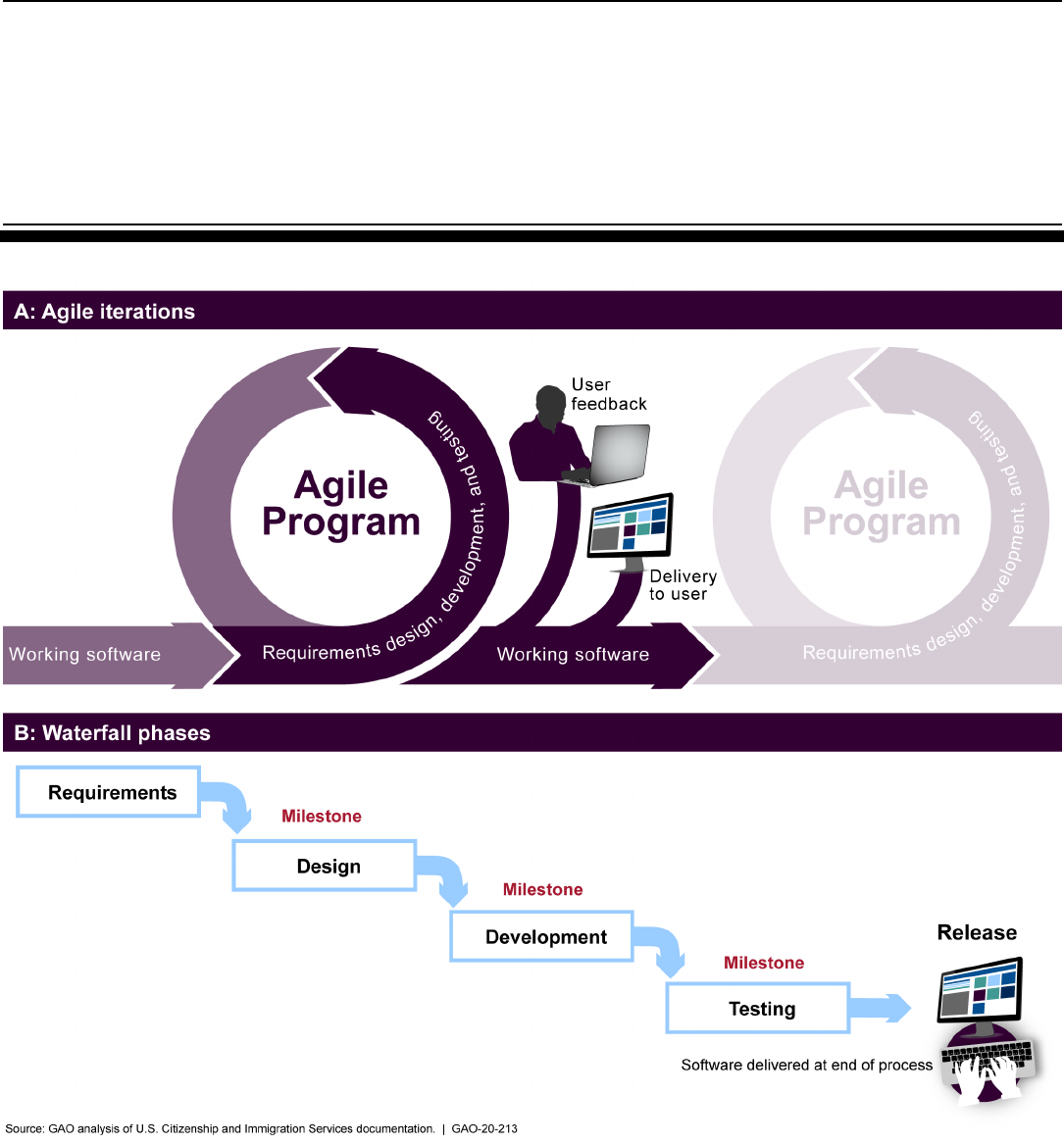
Page 8 GAO-20-213 Agile Software Development
Figure 1: Comparison of Agile and Waterfall Methods for Developing Software

Page 9 GAO-20-213 Agile Software Development
In February 2016, the DHS Under Secretary for Management announced
an effort to pilot the use of Agile development methodologies to improve
the department’s execution and oversight of IT acquisitions.
13
This
resulted in five Agile pilot programs. Each pilot program was overseen by
a component integrated program team. Collectively, the first pilot
programs were also overseen and supported by a DHS integrated
program team. In April 2016, the department issued an Agile instruction,
which identified Agile software development as the preferred approach for
all DHS programs and projects that are to deliver an IT, or embedded-IT,
capability.
14
The department also set an expectation for its component
CIOs to develop plans to increase the use of Agile development and
justify any major IT programs that did not intend to use Agile development
practices. Many DHS programs were already using Agile or similar
incremental development methods before the department identified it as
the preferred approach.
The DHS CIO, as the individual delegated departmentwide responsibility
for approving, managing, and overseeing all of the department’s IT
programs, sets the policies and procedures to help ensure Agile practices
meet the department’s goals and comply with acquisition management
policy. The DHS CIO is supported in this effort by the heads of other
major DHS lines of business, such as the Chief Procurement Officer.
15
13
Department of Homeland Security, Acquisition Decision Memorandum: Information
Technology Acquisitions Agile Pilots (Feb. 18, 2016). The memorandum signed by the
DHS Under Secretary for Management identifies practices, such as Lean and Agile
incremental development, as the preferred methods for acquiring and delivering DHS IT
capabilities. For the purposes of this report, we refer to Lean and Agile incremental
development as Agile development.
14
DHS defines a program as a group of related projects managed in a coordinated way to
obtain benefits and control not available from managing them individually. A project is
defined as a planned undertaking of something to be accomplished or produced, or an
undertaking having a finite beginning and finite end. A project is a temporary endeavor
undertaken to create a unique product, service, or result; it involves the definition,
acquisition, and fielding of a unique product, service, or result in accordance with specified
resources and requirements. For the purposes of this report, we will use the term
“program” to refer to a program or a project.
15
DHS defines a line of business chief as an “officer” at the department level with a set of
one or more highly related services (administrative, financial management, human
resources, information technology, procurement, and security). The lines of business
chiefs include the Chief Procurement Officer, Chief Readiness Support Officer, Chief
Financial Officer, Chief Human Capital Officer, Chief Security Officer, and the Chief
Information Officer.
DHS Adopted Agile
Software Development to
Address IT Challenges
Roles and Responsibilities
for Agile Programs

Page 10 GAO-20-213 Agile Software Development
Table 1 describes the roles and responsibilities that support Agile
development within the department.
Table 1: The Department of Homeland Security (DHS) Roles and Responsibilities for Agile Development
Role
a
Responsibility
Chief Information
Officer (CIO)
Sets the policies and procedures to ensure Agile development best practices are leveraged to meet the
department’s goals and are consistent with acquisition policy established by Directive 102-01.
Certifies that Department of Homeland Security (DHS) IT programs and projects are appropriately
implementing incremental software development.
Reviews IT investments to ensure they are appropriately tailoring and executing Agile methodologies within
the context of the specific programs and domains.
With the Chief Procurement Officer; Component Acquisition Executives; Science & Technology Directorate’s
Director, Office of Test and Evaluation; and component CIO, sets Agile outcomes and target measures;
monitors the progress of DHS in achieving Agile outcomes; and reports (as required) to Office of Management
and Budget and GAO on DHS attainment of outcome metrics and associated benefits.
Supported by the Chief Procurement Officer; Component Acquisition Executives; Science & Technology
Directorate’s Director, Office of Test and Evaluation, and the Office of Program Accountability and Risk
Management (PARM), provides guidance, training, and mentoring for the adoption and execution of Agile
development.
Chief Procurement
Officer
Supports DHS contracting organizations in implementing Office of Management and Budget guidance on
modular contracting.
Supported by the CIO, Component Acquisition Executives, and PARM, provides guidance, training, and
mentoring for adopting and executing modular contracting in support of modular development
programs/projects.
Supported by the CIO, sets modular contracting implementation metrics and reporting requirements.
Supported by the CIO, Component Acquisition Executives, and PARM, assesses training opportunities and
identifies appropriate Agile methodology training for acquisition professionals, including program/project
managers, test and evaluation personnel, system engineers, contracting officers, and logisticians.
Chief Financial Officer
As necessary, tailors Office of Management and Budget guidance regarding flexible budget and funding
models that support Agile development of IT acquisitions and distributes it to applicable parties within DHS.
Director, Office of
Test and Evaluation,
Science &
Technology
Directorate
Provides independent test and evaluation oversight for major acquisition programs, procurements, or capital
investments using approved development methodologies based on authority and responsibility as directed in
DHS Directive 026-06 and Delegation 10003.
Works with acquisition programs using Agile methodologies to develop integrated test and evaluation
strategies tailored to support Agile development in accordance with DHS test and evaluation policy.
Provides test and evaluation consultation to non-oversight acquisition programs dependent on available
Science & Technology Directorate’s Director, Office of Test and Evaluation staff resources.
Executive Director,
PARM
Supports the Chief Acquisition Officer in managing DHS-wide acquisition program policy, governance, and
oversight in accordance with Directive 102-01.
Source: Agile Development and Delivery for Information Technology | GAO-20-213
a
The Agile instruction also defines roles and responsibilities at the component level, including
component CIOs, chief financial officers, component acquisition executives, lead business and
technical authorities, and program and project managers.

Page 11 GAO-20-213 Agile Software Development
Additionally, DHS established a headquarters-level team—the ITPM
COE—to collaborate across the department on improvements to policy,
governance, and acquisition guidance. In April 2017, the ITPM COE
assumed responsibilities for the department’s transition to Agile
development. The Office of the Chief Technology Officer (OCTO)
Strategic Technology Management (STM) division within the OCIO
facilitates the ITPM COE and serves as the official liaison between other
OCIO divisions, other partner headquarters directorate and management
offices, and operational components as needed.
We have reported on various programmatic and technical challenges that
were limiting DHS’ efforts on Agile programs. For example,
• In 2016, we reported that the U.S. Citizenship and Immigration
Services Transformation program, which was using Agile software
development to modernize citizenship and immigration benefits
processing, needed to improve testing of its software code and ensure
its approaches to interoperability and end user testing met leading
practices.
16
We made 12 recommendations to improve
Transformation program management, including ensuring alignment
among policy, guidance, and leading practices in areas such as Agile
software development and systems integration and testing. DHS
concurred with the recommendations and has thus far implemented
eight of them.
• We reported in October 2017 that the Transportation Security
Administration Technology Infrastructure Modernization program had
not defined key roles and responsibilities, prioritized system
requirements, or implemented automated capabilities that were
essential to ensuring effective adoption of Agile.
17
We made 14
recommendations including that DHS should prioritize requirements
and obtain leadership consensus on oversight and governance
changes. DHS concurred with the recommendations and to date has
implemented 13 of them.
• In November 2018, we reported that the U.S. Secret Service OCIO
did not fully measure post-deployment user satisfaction with one
16
GAO, Immigration Benefits System: U.S. Citizenship and Immigration Services Can
Improve Program Management, GAO-16-467 (Washington, D.C.: July 7, 2016).
17
GAO, TSA Modernization: Use of Sound Program Management and Oversight Practices
Is Needed to Avoid Repeating Past Problems, GAO-18-46 (Washington, D.C.: Oct. 17,
2017).
GAO Previously Reported
on Challenges in DHS’
Management of Agile
Programs

Page 12 GAO-20-213 Agile Software Development
project supporting the Information Integration and Technology
Transformation investment.
18
We made 13 recommendations to the
U.S. Secret Service including that the Secret Service establish a
process that ensures the CIO reviews all IT contracts, as appropriate;
and identify the skills needed for its IT workforce. DHS concurred with
the recommendations but has not yet implemented them.
• We reported in April 2019 that the Federal Emergency Management
Agency Grants Management Modernization program had not yet fully
established plans for implementing new business processes or
established completed traceability of IT requirements.
19
We made
eight recommendations to implement leading practices related to
reengineering processes, managing requirements, scheduling, and
implementing cybersecurity. DHS concurred with the
recommendations and has thus far implemented two of them.
According to the Project Management Institute, the practice of change
management is a comprehensive, cyclic, structured approach for
transitioning individuals, groups, and organizations from a current state to
a future state with intended business benefits.
20
It helps organizations to
integrate and align people, processes, structures, culture, and strategy.
The Project Management Institute and GAO have both described leading
practices for effective organizational change management.
21
18
GAO, U.S. Secret Service: Action Needed to Address Gaps in IT Workforce Planning
and Management Practices, GAO-19-60 (Washington, D.C.: Nov. 15, 2018).
19
GAO, FEMA Grants Modernization: Improvements Needed to Strengthen Program
Management and Cybersecurity, GAO-19-164 (Washington, D.C.: Apr. 9, 2019).
20
Project Management Institute, Inc., Managing Change in Organizations: A Practice
Guide, (Newtown, Square, PA: 2013).
21
Project Management Institute, Managing Change in Organizations: A Practice Guide;
GAO, Government Reorganization: Key Questions to Assess Agency Reform Efforts,
GAO-18-427 (Washington, D.C.: Jul 13, 2018); IT Workforce: Key Practices Help Ensure
Strong Integrated Program Teams; Selected Departments Need to Assess Skill Gaps,
GAO-17-8 (Washington, D.C.: Nov. 30, 2017); Standards for Internal Control in the
Federal Government, GAO-14-704G (Washington, D.C.: Sept. 10, 2014).
Organizational Change
Management

Page 13 GAO-20-213 Agile Software Development
Leading practices in organizational change management advise an
agency to (1) plan for, (2) implement, and (3) measure the impact when
undertaking a significant change, such as a transition from one software
development approach to another.
22
Since DHS committed to its
transition to Agile software development in policy in April 2016, the
department has fully developed plans to facilitate the transition. However,
DHS has not fully implemented these plans and has experienced
challenges in measuring progress against its intended goals. In addition,
many of the plans are part of a larger effort to improve overall IT
acquisitions rather than specific to a transition to Agile development, an
approach that may delay DHS’s execution of these plans.
Leading practices for Agile software development adoption advise an
agency to focus on three organizational levels of adoption: (1) agency
environment, (2) program processes, and (3) team activities and
dynamics. DHS has partially adopted practices at all three organizational
levels. For example, the agency activities fully supported Agile methods
through actions such as developing policies and procedures that called
for the alignment of software, program goals, and agency goals.
However, the department’s culture can better support Agile methods by,
among other things, demonstrating an incentives and rewards structure to
incentivize Agile teams.
Planning for organizational change involves defining the activities that the
agency will need to undertake that integrate the planned changes with
business operations, identify areas where specific support is required,
and socialize practices to enable employees to make sense of what is
happening during the change. DHS fully implemented this practice area.
• Defining activities for integrating the planned changes with
business operations. DHS defined activities for integrating Agile
software development with business operations. Specifically, the
department began by compiling lessons learned based on Agile pilot
programs to inform its approach to adopting Agile development across
all of DHS. In June 2017, after completing the pilot effort, the Acting
Under Secretary for Management approved a set of 18 Agile action
plans to guide the transition to Agile software development.
23
Within
these actions plans, the department planned to update acquisition
22
Project Management Institute, Managing Change in Organizations: A Practice Guide;
GAO, GAO-18-427, GAO-17-8, GAO-14-704G.
23
The action plans are described further in appendix II.
DHS Has Made
Progress in
Implementing
Leading Practices,
but Has Not Fully
Addressed Others
DHS Fully Defined Planning
Activities for Transitioning to
Agile Development

Page 14 GAO-20-213 Agile Software Development
policy and guidance to ensure alignment with Agile software
development and supplement the updates with a series of artifacts
and templates.
• Defining activities for identifying areas where specific support is
required. DHS defined activities for identifying areas where specific
support is required. Within the Agile action plans, DHS planned to
meet with programs to determine their maturity levels and create an
Agile baseline for the department and develop and document a
strategy for prioritizing programs to receive support. Moreover, one
responsibility of the ITPM COE is to establish and institutionalize a
holistic IT program support intake function for identified risks and
issues to determine when assistance is warranted.
• Defining activities for socializing practices to enable employees
to make sense of what is happening during the change. DHS
defined activities for socializing practices to enable employees to
make sense of what is happening during the change. Within the Agile
action plans, the department intended to develop a generic
communications standard operating procedure for how information will
be socialized, shared, stored and received. DHS also planned to
socialize and post all templates and artifacts where components and
programs could access them.
Implementing organizational change involves executing the planned
activities and developing a human resource management plan based on
the skills, size, and availability of staff resources. DHS partially
implemented this practice area.
• Implementing the planned activities. DHS partially implemented the
planned activities for its transition to Agile software development.
According to officials from OCTO STM, contractor support staff
maintain a spreadsheet to track the status of each planned activity. As
of September 2019, of the 202 activities associated with the 18 Agile
action plans, 134 (approximately 66%) were complete, 30
(approximately 15%) were in progress, and 38 (approximately 19%)
had not been started.
ITPM COE officials stated that the activities of the ITPM COE, such as
completing the outstanding activities associated with the Agile action
plans, were sometimes delayed because the group’s activities were
not its members’ primary duties. This was reinforced in the fiscal year
2019 planning session, which identified the need for more of an
obligation from stakeholder engagement to ensure members attend
and assign themselves deliverables.
DHS Did Not Implement All of
the Defined Activities for
Transitioning to Agile
Development

Page 15 GAO-20-213 Agile Software Development
Nevertheless, DHS closed all of its aforementioned 18 Agile action
plans as implemented based on the near-term definition of done, as
agreed to by the Deputy Under Secretary for Management. As a result
of this decision, some of the activities were deferred until a later date.
According to the Director of STM, the Deputy Under Secretary for
Management concurred with this proposal, although DHS did not
provide supporting documentation to substantiate this statement.
The outstanding activities remain important to a successful transition
to Agile software development. For example, one Agile action plan
originally called for the department to publish updates to Agile policy,
procedures, and guidance. This included completing activities such as
updating the Agile instruction manual, as well as SELC guidance.
DHS closed this action plan as implemented because the department
had completed updating the acquisition management instruction and
associated instruction manual and sent it for executive approval.
However, according to the Director of STM and officials from PARM,
as of September 2019, these updates were not complete. Such
updates could help to further integrate Agile development with
business operations.
Until the department implements its planned activities for transitioning
to Agile, DHS risks increasing the chance that it will face challenges
that could adversely affect the transition to Agile.
• Developing a human resource management plan based on the
skills, size, and availability of staff resources. DHS initially
prepared a human resource management plan for completing the
Agile action plans. Following approval of the 18 action plans, the
Under Secretary for Management tasked a working group with
developing a schedule for executing the action plans. This included
estimating the number of staff required to complete each action plan,
how those staff positions would be filled, the time required to complete
each action plan, and any delays in other DHS initiatives that might
result from reprioritization. The working group determined that it would
need 88 full-time staff to complete the action plans as intended and
estimated completing all 18 action plans by October 2018. According
to the Director of STM, the Under Secretary for Management did not
approve the request for 88 full-time staff.
However, DHS did update the human resource management plan to
reflect ongoing fiscal year planning sessions and completing the
remaining Agile action plan activities. In September 2018, the ITPM
COE held a planning session to identify priorities for fiscal year 2019.
These priorities included completing some of the outstanding action
plan activities along with some new activities identified by members of

Page 16 GAO-20-213 Agile Software Development
the group. However, DHS did not demonstrate that the ongoing
planning sessions and the subsequent schedule for the upcoming
fiscal year were based on an assessment of the skills, team size, and
availability of the ITPM COE or other working groups supporting the
transition to Agile.
By assessing whether the upcoming plans for the ITPM COE are
realistic based on the skills needed to complete its planned
responsibilities associated with the transition to Agile and the
available resources, DHS can improve the likelihood of completing the
actions necessary to finish the transition of the department to Agile
development methods.
Measuring the impact of organizational change involves establishing the
need for the change, clarifying expected outcomes of the change that are
tied to target measures, measuring adoption rate, and measuring results
through its impact on the agency. DHS partially implemented this practice
area.
• Establishing the need for the change. DHS established the need
for its transition to Agile development. In the February 2016
Acquisition Decision Memorandum that approved five Agile pilots, the
DHS Under Secretary for Management stated that the department
needed the pilot programs because the department’s IT programs
were taking too long to develop and implement or were failing to
deliver the desired value to mission operations.
• Clarifying expected outcomes of the change that are tied to
target measures. The DHS Agile instruction required the DHS CIO
to, among other things, set Agile outcomes and target measures.
Consistent with leading practices and this requirement, DHS clarified
the expected outcomes of the transition to Agile development. In the
February 2016 Acquisition Decision Memorandum, the Under
Secretary for Management set a goal for the pilot programs to
improve the execution and oversight of DHS IT acquisitions using
industry best practices. In a white paper on streamlining DHS
acquisition and establishing a foundation for Agile program delivery,
DHS expanded on this goal and defined five outcomes for the
transition to Agile development:
1. Increased customer value: Deliver capabilities that are better
aligned with mission and user needs.
2. Reduced risk: Reduce probability of large, expensive failures.
DHS Could Not Measure the
Benefits of the Transition to
Agile

Page 17 GAO-20-213 Agile Software Development
3. Faster time-to-market: Deliver capabilities as quickly as possible
without sacrificing quality.
4. Increased accountability and oversight: Provide detailed,
continuous insight to progress and risks.
5. Economic value: Deliver capabilities as inexpensively as possible
without sacrificing quality.
However, the expected outcomes were not tied to target measures, as
required by the Agile instruction. The Director of STM stated that the
department did not initially define target measures for outcomes of its
transition because DHS was initially focused on adoption and
anticipated the need to refine the metrics over time based on lessons
learned. The Director added that there were challenges for some
programs in adopting Agile and target measures could have dis-
incentivized programs. The Director stated that this has been a
learning process and the department is now more comfortable
associating targets with the metrics, but did not provide a date for
doing so. By identifying target measures tied to its expected
outcomes, the department will be able to better determine whether the
transition is achieving its desired outcomes.
• Measuring adoption rate. DHS did not initially measure the Agile
adoption rate because it had not specifically identified projects that
were using Agile development. In 2018, the OCTO STM was focused
on measuring the adoption of incremental development in order to
comply with the requirements of the federal IT reform provisions
(commonly known as FITARA).
24
This effort included OCTO STM
working with programs to ensure they were accurately identifying
software projects and separating that effort from other projects
supporting the program. The office also focused on ensuring that
programs accurately reported the delivery times of those software
projects to headquarters via the Investment Evaluation, Submission, &
24
One of the provisions required the Chief Information Officer to certify whether an IT
investment is adequately implementing incremental development, as defined in capital
planning guidance issued by the Office of Management and Budget. Pub. L. No. 113-291,
§ 831 as codified at 40 U.S.C. § 11319(b)(1)(B)(ii). In June 2015, the Office of
Management and Budget released guidance (Management and Oversight of Federal
Information Technology, Memorandum M-15-14) describing how agencies are to
implement FITARA. Although Office of Management and Budget guidance and FITARA
only prescribed the use of incremental, and not specifically Agile, development, DHS uses
Agile development as a mechanism for complying with the requirements for incremental
development.

Page 18 GAO-20-213 Agile Software Development
Tracking system.
25
The delivery time impacts the agency rating on the
Federal Information Technology Acquisition Reform Act scorecard.
26
According to the Director of the OCTO STM, DHS has been validating
data reported to the Investment Evaluation, Submission, & Tracking
system to comply with capital planning and investment control
requirements from the Office of Management and Budget. The
Director stated that the fields in the Investment Evaluation,
Submission, & Tracking system were incorrect at first, but, through
interaction with the Office of Management and Budget, DHS was able
to change the fields through which Agile adoption is measured.
In March 2019, the department provided an updated dashboard for
measuring programs that included identifying programs adopting Agile
development or another form of incremental development.
27
In May
2017, the department published an initial set of Agile core metrics.
The purpose of these metrics was to provide DHS component IT
programs with direction on the core software delivery metrics that
DHS headquarters would subsequently require programs to collect
and report. DHS also intended for these core metrics to inform the
department on program or software delivery health, maturation, and
stability in delivering their intended capabilities and outcomes. Among
other things, the updated dashboard identified Agile programs based
on those that completed and submitted the Agile core metrics to their
department.
25
The Investment Evaluation, Submission, & Tracking system is a central repository for
data on DHS acquisitions and investments, such as budget, schedule, and performance
information. Data in this system are used to oversee both major and non-major
acquisitions and to satisfy internal and external reporting requirements.
26
Beginning in November 2015, the House of Representatives Committee on Oversight
and Government Reform released its first Federal Information Technology Acquisition
Reform Act (FITARA) scorecard that assigned letter grades to federal agencies on their
implementation of FITARA. See GAO, Information Technology: Effective Practices Have
Improved Agencies’ FITARA Implementation, GAO-19-131 (Washington, D.C.: Apr. 29,
2019) for additional information.
27
The DHS OCIO Agile Certification Report for March 2019 tracked two categories: 1) the
current Federal IT Acquisition Reform Act score and 2) the current CIO certification score.
The Federal IT Acquisition Reform Act score tracks the percentage of IT programs that
report using an iterative, incremental, Spiral, or Agile software development methodology
and report “yes” to releasing to production every six months in the Investment Evaluation,
Submission, & Tracking system. The CIO certification score tracks the percentage of IT
programs that meet the requirements for the Federal IT Acquisition Reform Act score and
also report a last delivery date within six months, that the program is in the ‘obtain’ phase,
and that the Agile core metrics is completed. As of March 2019, the Agile certification
report included a current CIO certification score of 29%.

Page 19 GAO-20-213 Agile Software Development
However, the Agile core metrics that DHS relied on to measure the
Agile adoption rate were not consistently reported to the Investment
Evaluation, Submission, & Tracking system as required. According to
the Director of STM, the department was still working with programs
and capital planning and investment control administrators to increase
compliance with reporting the core metrics. Until DHS can ensure that
all Agile programs are consistently reporting the core metrics, the list
of Agile programs will be incomplete. In addition, until DHS can
identify Agile programs and begin to measure results, it risks not
being appropriately informed about whether its efforts are having a
positive impact on product and performance results.
• Measuring results through its impact on the agency. The
department did not measure the results associated with the transition
to Agile development or the success of the transition based on its
impact on the department. According to the Director of STM, the
department had intended to measure results no later than April 2019
as part of a particular action plan. This plan was to pursue text and
business analytics solutions and leverage automation capabilities to
increase effectiveness of program analysis, planning, and oversight
reporting. However, the department closed this action plan in April
2019 without demonstrating the value of the transition to Agile.
In written comments, the Director of STM stated that the action plan
was closed based on completing an experiment to show that analytics
could lead to measuring success of incremental acquisition
techniques. According to the Director, the department is now pursuing
tools and techniques to put the results of this action plan into practice.
The Director added that further investment will likely be required to
fully meet this anticipated outcome.
By measuring and communicating the results of the transition to Agile
development, DHS can determine whether Agile is achieving its
desired results and if Agile programs are performing better or worse
than programs performed prior to the transition to Agile development.
The department may also increase the acceptance and adoption of
Agile among people throughout the department because they may
better understand the associated results.

Page 20 GAO-20-213 Agile Software Development
Leading practices that we developed for Agile software development
adoption are organized into three areas, called organizational levels:
agency environment, program processes, and team activities and
dynamics.
28
The organizational levels are further divided into nine leading
practices. Table 2 identifies the three organizational levels and nine
leading practices associated with these levels (three practices within each
area). A detailed assessment of DHS’s implementation of each of the
nine leading practices can be found in appendixes III, IV, and V.
Table 2: Levels of Agile Adoption and Leading Practices Associated with Each Level
Practice level
Leading practice
Leading practice description
Agency
Environment
Agency activities support Agile methods
The agency should establish appropriate life cycle activities and
ensure that goals and objectives are clearly aligned.
Agency culture supports Agile methods
The agency’s sponsorship for Agile development should cascade
throughout the agency and sponsors should understand Agile
development. The agency should also establish an environment
supportive of Agile development. Incentives and rewards should be
aligned to Agile development methods.
Agency acquisition policy and procedure
support Agile methods
Agency guidance should be appropriate for Agile acquisition
strategies
Program
Processes
Staff are appropriately trained in Agile
methods
Agency policy or guidance should ensure that all program staff are
trained in Agile methods and call for Agile teams to have the
appropriate technical expertise needed to perform their roles.
Technical environments enable Agile
development
Agency policy or guidance should call for technical and project tools
being available to support Agile development. In addition, policy or
guidance should call for system design that will support iterative
delivery.
Project planning controls are compatible
with Agile development
Agency policy or guidance should call for teams to maintain a
sustainable development pace and track and monitor that
development pace. In addition, policy or guidance should call for non-
functional requirements and critical features to be defined and
incorporated in development.
Team Activities
and Dynamics
Team composition supports Agile
methods
Agency policy or guidance should call for self-organizing Agile teams
and define the role of a product owner to support Agile methods.
Work is prioritized to maximize value for
the customer
Agency policy or guidance should call for Agile teams to use user
stories to define work, requirements to be prioritized in a backlog
based on value, including tracking and monitoring the value of work
accomplished, and for Agile teams to estimate the relative complexity
of user stories.
28
See appendix I for more information regarding the process for compiling the leading
practices.
DHS Has Made Progress
in Implementing Nine
Leading Practices for Agile
Software Development
Adoption, but Has Not
Fully Implemented All

Page 21 GAO-20-213 Agile Software Development
Practice level
Leading practice
Leading practice description
Repeatable processes are in place
Agency policy or guidance should call for Agile teams to meet daily to
review progress and discuss impediments, and observe end-iteration
demonstrations and end-iteration retrospectives. In addition, agency
policy or guidance should call for Agile projects to employ continuous
integration and confirm mechanisms are in place to ensure the quality
of code being developed. This includes setting expectations for
automated testing and code quality and tracking and monitoring
against these expectations.
Source: GAO analysis of DHS documentation. | GAO-20-213
We refer to the leading practices related to an agency’s processes,
culture, and acquisition strategies as agency environment practices. For
an agency to successfully transition from an agency that supports
traditional development methods, it should ensure that its activities,
culture, and acquisition policy and procedures support Agile methods.
DHS partially implemented the agency environment practice level by fully
implementing two leading practices and partially implementing the
remaining one. A more detailed assessment of DHS’s agency
environment leading practices can be found in appendix III.
• Agency activities support Agile methods–fully implemented. DHS
established appropriate life cycle activities to support Agile methods.
For example, the department has outlined its policies, procedures,
and guidance in several documents to assist its components in the
acquisition and implementation of Agile software development. The
department also developed policies and procedures that called for the
alignment of software, program goals, and agency goals.
• Agency culture supports Agile methods–partially implemented.
DHS established an environment that supported Agile development,
and senior stakeholders supported its development throughout the
agency. However, DHS did not take sufficient steps to ensure that
senior stakeholders serving as executive sponsors understood Agile
development, as called for by leading practices that are described in
further detail in appendix III. The Director of STM stated that Agile
sponsors were considered to be chief executive officers (e.g.
Executive Director of PARM and the Deputy Under Secretary for
Management). These parties oversaw the actions of the ITPM COE
and approved the Agile action plans in June 2017.
In addition, the department did not require training for senior
stakeholders serving as executive sponsors, as called for by leading
practices. In a written response, the Office of the Chief Human Capital
Officer said that there were no Agile training requirements for officials
at this level. By training executive-level sponsors in Agile
DHS partially implemented
practices at the agency
environment level

Page 22 GAO-20-213 Agile Software Development
development, the department can mitigate the risk of setting
expectations for programs and projects that do not align with the
values and principles of Agile software development.
DHS also did not demonstrate that it established an incentives and
rewards structure to incentivize Agile teams, as called for by leading
practices. Officials from the Office of the Chief Human Capital Officer
stated that the department’s existing rewards structure allowed for
incentivizing team and individual performance even though it was not
focused specifically on Agile methods. These officials stated that they
did not believe that additional policy, guidance, or modifications to
their existing policy were necessary. The Director of STM within OCIO
stated that rewarding Agile teams was not a topic the ITPM COE was
currently considering, but that OCIO might be interested in pursuing
the topic after completing existing, higher-priority activities. By
considering modifications to policy and guidance governing the
incentives and rewards structure to promote team performance, DHS
could improve team productivity and output.
• Agency acquisition policies and procedures support Agile
methods–fully implemented. DHS guidance for acquisition
strategies supported the unique needs of Agile programs. For
example, DHS offered guidance for preparing acquisition strategies
through its Procurement Innovation Lab and published Agile guidance
that discussed contracting and acquisition strategies.
29
Program processes involve staff being appropriately trained in Agile
methods, technical environments enabling Agile development, and project
planning controls being compatible with Agile development. DHS partially
implemented the program processes practice level by fully implementing
one leading practice and partially implementing the remaining two. A
more detailed assessment of DHS program process leading practices can
be found in appendix IV.
• Staff are appropriately trained in Agile methods–partially
implemented. DHS training policy and guidance called for some of
the acquisition management program staff to be trained in Agile
methods. DHS has also taken steps to incorporate Agile concepts into
required training for members of the acquisitions workforce. In
addition, DHS offered elective training covering Agile methods and
29
The Department of Homeland Security Procurement Innovation Lab, Office of the Chief
Procurement Officer, experiments with innovative techniques for increasing efficiencies in
the procurement process and institutionalizing best practices.
DHS partially implemented
practices at the program
process level

Page 23 GAO-20-213 Agile Software Development
guidance for Agile teams, including contractors, to have the
appropriate technical expertise needed to perform their role.
The department also took steps to identify the necessary
competencies for Agile teams and individuals. In April 2019, the
Strategic Workforce Planning team within OCIO published a white
paper identifying 27 competencies necessary for teams and
individuals to use and training courses associated with the
competencies. The white paper also made recommendations to help
DHS address challenges in implementing Agile methods, such as
establishing communities of practice for Agile practitioners to identify
best practices and provide workshops. According to a written
response by OCIO, the Strategic Workforce Planning team will create
an implementation and communication plan for any deliverables
associated with the white paper.
However, the department did not provide policy or guidance to ensure
that all program staff were trained in Agile methods, as called for by
leading practices described in further detail in appendix IV. Existing
Agile training requirements covered only the acquisitions workforce.
DHS did not establish training requirements for program staff outside
of the acquisitions workforce—such as a product owner or other
staff—who may be assigned to an Agile program. As a result,
individual programs must independently decide on and enforce
training requirements if they want to ensure that all staff receive the
needed training.
DHS officials stated that the department focuses on key acquisition
career fields in part because those career fields are defined in policy
and procedures.
30
According to the Director of STM, the department
also encourages programs to independently find coaching and
training because the components are more likely to have funding. By
providing policy or guidance to ensure that all personnel staffed to an
Agile program or project receive appropriate training, the department
can better prepare program staff to plan and execute appropriately,
and increase the likelihood of achieving the expected outcomes of the
transition to Agile.
• Technical environments enable Agile development–fully
implemented. DHS guidance called for technical and project tools to
be available to support Agile development. For example, DHS test
30
Department of Homeland Security, Directive 064-04, Acquisition Professional Career
Information, Revision 00 (Oct. 30, 2008).

Page 24 GAO-20-213 Agile Software Development
and evaluation guidance stated that automated testing should be
implemented where practical.
In addition, DHS guidance called for system designs that will support
iterative delivery. For example, DHS enterprise architecture guidance
and supplementary design considerations for acquisition programs
discussed loose coupling and different methods for establishing a
modular system.
• Project planning controls are compatible with Agile
development–partially implemented. DHS guidance called for
defining and incorporating non-functional requirements and critical
features throughout development. In addition, DHS provided guidance
for establishing a sustainable development pace. For example, the
Agile instruction manual identified the benefits of monitoring the
amount of work completed by Agile teams across each iteration in
order to monitor ongoing team progress.
However, DHS was not tracking and monitoring the pace of Agile
team development as called for by DHS guidance and described
further in appendix IV. According to the Director of STM, programs
were not consistently reporting the Agile core metrics associated with
development team pace as required. The Director of STM stated that
the department was taking steps to begin tracking and monitoring the
pace of Agile teams. In addition, the Director stated that he allocated
staff to assist programs with consistently reporting the Agile core
metrics.
According to the Director of STM, the department was in the process
of updating the core metrics and intended to publish a new version of
them in the future, which would include tracking the pace.
Nevertheless, DHS did not provide assurance that the metrics
associated with development pace would be included in this revised
set of metrics or that programs would consistently report that
information in order for the department to track and monitor the pace
of Agile teams. Until the department consistently tracks and monitors
Agile programs and projects, it will not have the information needed to
help ensure the development pace is maintained.
Practices at the team activities and dynamics level include team
composition supporting Agile methods, work being prioritized to maximize
value for the customer, and repeatable processes being in place. DHS
partially implemented the team activities and dynamics practice level by
fully implementing one leading practice and partially implementing the
remaining two. A more detailed assessment of DHS team activity and
dynamics leading practices can be found in appendix V.
DHS partially implemented
practices at the team activity
and dynamics level

Page 25 GAO-20-213 Agile Software Development
• Team composition supports Agile methods—fully implemented.
DHS established guidance that called for self-organizing teams and
defined the role of a product owner. For example, the Agile instruction
and Agile instruction manual both explain that collaborative, self-
organizing, and cross-functional teams help achieve the flexibility
needed for the iterative development that characterizes Agile
development methods. In addition, the Agile instruction manual states
that the product owner is responsible for representing stakeholders
and should be available to the development team throughout the
iteration to answer questions and clarify requirements on behalf of the
stakeholders.
• Work is prioritized to maximize value for the customer—partially
implemented. DHS guidance called for Agile teams to craft user
stories to define work. The guidance also called for user stories to be
prioritized in a backlog based on value.
However, the guidance did not describe how Agile teams can
estimate the relative complexity of the user stories as called for by
leading practices and described in further detail in appendix V. The
Director of STM stated that relative estimation is a basic exercise and
that guidance on this topic can be found in a number of sources
outside of DHS. However, without providing guidance or directing
Agile teams to external sources for additional information on relative
estimation, OCIO risks that teams supporting Agile projects will not
appropriately estimate user stories relative to each other.
By providing guidance on estimating the relative complexity of user
stories, the department can help Agile teams to effectively commit to
an appropriate amount of work during a given iteration.
• Repeatable processes are in place—partially implemented. DHS
guidance addressed holding daily meetings to review progress and
discuss impediments, using a demonstration for the acceptance of a
user story and conducting a retrospective to evaluate progress. In
addition, the department’s guidance called for Agile programs to
employ continuous integration and emphasized the need for
mechanisms to help ensure code quality.
However, DHS did not set expectations for automated testing and
code quality, as called for by DHS guidance and described further in
appendix V. DHS’s Agile core metrics included a series of metrics that
addressed automated testing and code quality. The core metrics
included targets but the targets were notional and, therefore, not
expectations that DHS required a program to meet. According to the
Director of STM, the initial core metrics were intended to assess the

Page 26 GAO-20-213 Agile Software Development
level of DHS team achievement without imposing artificial industry-
based target measures for each. The Director stated that, on receiving
the metrics for a period of time, the department would then adjust the
core metrics and begin to include target measures based on the
results achieved. According to the Director, this effort is currently
underway and an updated set of core metrics will be distributed in
early fiscal year 2020.
Moreover, the department did not track and monitor automated testing
or code quality against expectations. As discussed under project
planning controls, DHS intended to track and monitor Agile practices,
such as automated testing and code quality, through the Agile core
metrics. However, according to the Director of STM, programs and
projects were not consistently reporting these core metrics and those
that were reporting did not collect data or report on particular metrics.
By setting expectations for automated testing and code quality and
beginning to track and monitor project performance against these
expectations, DHS can increase the likelihood that Agile programs
and projects are delivered within cost, schedule, and performance
estimates.
DHS has taken many positive steps in its transition to Agile software
development. It has implemented activities and artifacts that support all
levels of adoption, from the department and component offices to Agile
programs, projects, and teams. These activities and artifacts include
providing opportunities for Agile programs and projects to streamline
acquisition and life cycle processes to allow for iterative delivery and
exhibiting senior support for the transition to Agile.
The department successfully planned for the transition to Agile software
development and completed many of its intended implementation
activities. However, because DHS did not assess the skills and resources
needed to complete deferred activities, it risks continued delays in
completing these. In addition, without identifying target measures tied to
expected outcomes, the department is limited in determining whether the
transition is achieving its desired outcomes. Moreover, until DHS can
ensure that all programs are consistently reporting on Agile core metrics,
the department will not be able to track programs’ development
techniques. Further measuring and communicating the benefits of the
transition can enable the department to know whether Agile programs are
performing better than those used prior to the transition.
Conclusions

Page 27 GAO-20-213 Agile Software Development
DHS has demonstrated significant progress in implementing leading Agile
practices. The department can further improve its performance through
full execution of the remaining partially implemented practices. At the
agency environment level, DHS can mitigate risk and improve productivity
through executive level training and modifications to policy to incentivize
Agile teams. For program level practices, addressing training
requirements for all necessary staff and tracking and monitoring the pace
of Agile team development can help ensure teams’ success.
With respect to team-level practices, DHS has not established guidance
for estimating the relative complexity of user stories. As a result, Agile
teams are hampered in effectively committing to an appropriate amount of
work during a given period of time. Finally, because DHS has not set
expectations for performance metrics for monitoring and tracking the use
of automated testing and code quality, DHS is at a greater risk for
programs breaching their cost and schedule expectations.
We are making the following 10 recommendations to the Secretary of the
Department of Homeland Security (DHS).
The Secretary should ensure that the Director of Strategic Technology
Management (STM), in collaboration with other members of the
Information Technology Program Management Center of Excellence
(ITPM COE), identifies the skills and resources needed to complete the
work intended for the upcoming fiscal year, including the availability of
supplementary staff, such as subject matter experts. (Recommendation
1)
The Secretary should ensure that the Executive Steering Committee
overseeing the activities of the ITPM COE establishes target measures
for the department’s desired outcomes of its transition to Agile
development. (Recommendation 2)
The Secretary should ensure that the DHS Chief Information Officer (CIO)
defines a process and associated set of controls to ensure that Agile
programs and projects are reporting a set of core required performance
metrics for monitoring and measuring Agile adoption. (Recommendation
3)
The Secretary should ensure that the ITPM COE, in coordination with the
CIO, begins measuring results associated with the transition to Agile and
the success of the transition based on its impact on the department.
(Recommendation 4)
Recommendations for
Executive Action

Page 28 GAO-20-213 Agile Software Development
The Secretary should ensure that the CIO, in collaboration with the Chief
Procurement Officer, through the Homeland Security Acquisition Institute,
establish Agile training requirements for senior stakeholders.
(Recommendation 5)
The Secretary should ensure that the Chief Human Capital Officer, in
collaboration with the CIO, consider modifications to the current employee
recognition and performance management governance to ensure that
teamwork and team performance of Agile programs and projects are
incentivized. (Recommendation 6)
The Secretary should ensure that the CIO, in collaboration with the Chief
Procurement Officer, through the Homeland Security Acquisition Institute,
establish Agile training requirements for staff outside of the acquisition
workforce but assigned to Agile programs. (Recommendation 7)
The Secretary should ensure that the CIO, upon establishing a set of core
performance metrics, tracks and monitors the pace of Agile team
development. (Recommendation 8)
The Secretary should ensure that the CIO, in collaboration with the
Executive Director of the Office of Program Accountability and Risk
Management (PARM), update or develop new guidance on Agile
methodologies to describe how Agile teams can estimate the relative
complexity of user stories. (Recommendation 9)
The Secretary should ensure that the CIO, upon establishing a set of core
performance metrics, sets expectations for automated testing and code
quality, and tracks and monitors against those expectations.
(Recommendation 10)
DHS provided written comments on a draft of this report. In its comments
(reproduced in Appendix VI), the department agreed with our 10
recommendations and described actions that it had completed and
planned to address them.
Based on the actions DHS said it had taken, the department requested
that we close the first three recommendations as implemented. For
example, the department described steps it had taken to address our
recommendation that it identify the skills and resources needed to
complete the work intended for the upcoming fiscal year, including the
availability of supplementary staff such as subject matter experts. In
addition, the department stated that it had addressed our
Agency Comments
and Our Evaluation

Page 29 GAO-20-213 Agile Software Development
recommendation to define a process and controls to ensure that Agile
programs and projects are reporting a set of core required performance
metrics for monitoring and measuring Agile adoption. We plan to follow up
with DHS to assess the sufficiency of its actions to address our
recommendations.
The department also described actions that it plans to take to address the
other seven recommendations. For example, DHS stated that it will use
the results of its Agile core metrics and Agile Software Delivery Maturity
Model to measure the success of the transition to Agile and its impact on
the department. According to the department, it expects this action to be
completed by June 30, 2021.
Further, DHS stated that it will identify Agile training requirements for staff
in Agile programs, and will use that to establish Agile training
requirements for staff outside of the acquisition workforce but assigned to
Agile programs. Specifically, DHS stated that the DHS OCIO will gather
requirements from components via its IT workforce planning integrated
project team to identify training resources available across the
department that also address the skill sets needed for Agile programs.
The department added that the DHS OCIO will utilize information from the
April 2019 white paper, titled “OCIO Agile White Paper” to inform
proposed Agile program training requirements. The department estimated
that these actions are to be completed by September 30, 2020.
DHS also provided technical comments, which we have incorporated as
appropriate.
We are sending copies of this report to the Acting Secretary of Homeland
Security and interested congressional committees. In addition, the report
will be available at no charge on the GAO website at http://www.gao.gov.
If you or your staff have any questions about this report, please contact
me at (202) 512-4456 or [email protected]. Contact points for our Offices
of Congressional Relations and Public Affairs may be found on the last
page of this report. GAO staff who made key contributions to this report

Page 31 GAO-20-213 Agile Software Development
List of Requesters
The Honorable Xochitl Torres Small
Chairwoman
Subcommittee on Oversight, Management, and Accountability
Committee on Homeland Security
House of Representatives
The Honorable J. Luis Correa
House of Representatives
The Honorable Scott Perry
House of Representatives

Appendix I: Objective, Scope, and
Methodology
Page 32 GAO-20-213 Agile Software Development
Our objective was to assess the extent to which the Department of
Homeland Security (DHS) addressed selected leading practices for its
transition to the use of Agile software development. To accomplish this
objective, we assessed the extent to which the department adhered to
leading practices in two specific areas: organizational change
management and Agile software development adoption.
With regard to organizational change management, we reviewed leading
practices published by the Project Management Institute and GAO.
1
Based on this review, we identified 15 leading practices. We then
grouped these 15 practices in three broad organizational change
management areas: planning, implementing, and measuring change.
To determine the extent to which DHS addressed leading practices for
organizational change management in its transition to Agile development,
we assessed DHS policies, procedures, guidance, plans, and other
working group artifacts and compared them against leading practices. In
particular, we reviewed working group charters for the DHS headquarters
Agile Acquisition Integrated Program Team and IT Program Management
Center of Excellence (ITPM COE), and any plans developed by these
working groups, including the DHS Agile Action Plans and associated
implementation plans. We then reviewed working group meeting minutes,
presentation slides, and status update charts to assess the progress of
the transition to Agile, identified artifacts prepared to support the transition
to Agile, and assessed the status of plans for the transition to Agile. We
reviewed all Agile artifacts prepared by or supporting the Agile working
groups, such as a preliminary software development maturity model, the
DHS Agile Acquisition Software Delivery Core Metrics (Agile core
metrics), and an updated test and evaluation master plan template for
Agile, among other artifacts.
2
We also interviewed officials from DHS headquarters line of business
representatives explicitly identified in the Agile Development and Delivery
1
Project Management Institute, Inc., Managing Change in Organizations: A Practice
Guide, 2013. GAO, Government Reorganization: Key Questions to Assess Agency
Reform Efforts, GAO-18-427 (Washington, D.C.: Jul 13, 2018); IT Workforce: Key
Practices Help Ensure Strong Integrated Program Teams; Selected Departments Need to
Assess Skill Gaps, GAO-17-8 (Washington, D.C.: Nov. 30, 2016); Standards for Internal
Control in the Federal Government, GAO-14-704G (Washington, D.C.: Sept. 2014).
2
Department of Homeland Security, Agile Acquisition Software Delivery Core Metrics,
Version 1.0 (May 23, 2017).
Appendix I: Objective, Scope, and
Methodology

Appendix I: Objective, Scope, and
Methodology
Page 33 GAO-20-213 Agile Software Development
for Information Technology instruction (Agile instruction).
3
This included
officials from the Office of the Chief Procurement Officer, Office of the
Chief Financial Officer, Office of the Chief Information Officer (OCIO),
Office of Program Accountability and Risk Management (PARM), and the
Science and Technology Directorate, and offices of Test and Evaluation
and Systems Engineering. Within OCIO, we interviewed officials from the
Office of the Chief Technology Officer (OCTO) within the Strategic
Technology Management (STM) division, among others, as STM is the
entity tasked with facilitating the ITPM COE and serves as the official
liaison between other OCIO divisions, other partner headquarters
directorate and management offices, and operational components. We
also interviewed representatives from groups participating in ITPM COE
activities but not explicitly called out in the Agile instruction, including the
Privacy Office and Joint Requirements Council. In addition, we
interviewed representatives from other groups not represented on the
ITPM COE but potentially impacted by the transition to Agile. This
included officials from the Office of the Chief Readiness Support Officer
and Office of the Chief Human Capital Officer.
With regard to leading practices for Agile software development adoption,
we reviewed work performed by GAO to develop generally accepted
leading practices. In developing these leading practices, GAO reviewed
information from a variety of sources related to Agile adoption and
compiled a draft of leading practices commonly mentioned across these
different sources.
4
We then convened a working group of experts from the
public and private sectors and academia. This working group met three
times a year between August 2016 and August 2019 to review and
discuss these leading practices. More than 200 experts participated in the
3
Department of Homeland Security, Instruction 102-01-004; Instruction Manual 102-01-
004-01. DHS defines the line of business chiefs as officers at the department level with a
set of one or more highly related services (administrative, financial management, human
resources, information technology, procurement, and security), which include the Chief
Procurement Officer, Chief Readiness Support Officer, Chief Financial Officer, Chief
Human Capital Officer, Chief Security Officer, and the Chief Information Officer.
4
See, for example, Booz Allen Hamilton, Agile Playbook, Version 2.0 (Washington, D.C.:
June 2016); California Department of Technology, California Project Management Office,
Understanding Agile, Version 1.0 (California: Dec. 5, 2016); National Association of State
Chief Information Officers and Accenture, Agile IT Delivery: Imperatives for Government
Success (Washington, D.C.: 2017); Office of Management and Budget, U.S. Digital
Services, Playbook (version pulled on Dec. 22, 2017); TechFAR: Handbook for Procuring
Digital Services Using Agile Processes (version pulled on Mar. 8, 2018); Project
Management Institute, Inc., Agile Practice Guide (Newtown Square, PA: 2017); Software
Engineering Institute. The Readiness & Fit Analysis: Is Your Organization Ready for
Agile? (Pittsburgh, PA: Apr. 2014).

Appendix I: Objective, Scope, and
Methodology
Page 34 GAO-20-213 Agile Software Development
meetings, including more than 20 officials from DHS. GAO received
comments from some of these experts both during these meetings and by
email after the meetings.
Based on this work, GAO developed a set of nine leading practices for
Agile adoption. GAO grouped these leading practices into three
organizational levels: (1) agency environment, (2) program processes,
and (3) team activities and dynamics. The leading practices were further
described by a series of core elements and core element expectations
that, collectively, can be used to assess the status of an agency’s
implementation.
To determine the extent to which the department had implemented the
leading practices for the adoption of Agile development, we obtained and
assessed DHS policies, procedures, guidance, plans, and other
documentation and compared them against the nine leading practices. In
particular, we reviewed department acquisition policy, procedures, and
guidance, such as acquisition management directive 102-01; software
engineering life cycle policy, procedures, and guidance, such as those
published in the software engineering life cycle guidebook; requirements
policy, procedures, and guidance, such as the Joint Requirements
Integration and Management System and Requirements Engineering
User’s Guide; testing policy, procedures, and guidance, such as the Test
and Evaluation Master Plan template and Test and Evaluation
Management Guide; technical assessment and enterprise architecture
policy, procedures, and guidance; program health assessment policy,
procedures, and guidance such as the Acquisition Program Health
Assessment instruction and CIO Program Health Assessment Scoring
Guideline; and Agile-specific policy, procedures, and guidance, such as
the Agile instruction and the Agile Development and Delivery for
Information Technology Instruction Manual (Agile instruction manual),
among other policy, procedures, and guidance.
5
In addition to reviewing the department policy, procedures, and guidance,
we obtained and assessed supplementary Agile documentation. In
particular, we reviewed training materials prepared by the Homeland
Security Acquisition Institute for acquisition workforce certifications and
webinars offered by the Procurement Innovation Lab; ITPM COE Agile
artifacts discussed under our assessment of the implementation of
5
Department of Homeland Security, Instruction Manual 102-01-004-01, Agile
Development and Delivery for Information Technology Instruction Manual, Revision 00
(Jul. 15, 2016).

Appendix I: Objective, Scope, and
Methodology
Page 35 GAO-20-213 Agile Software Development
organizational change management leading practices, such as the Agile
core metrics; and Agile-specific technical review completion letters, such
as the release planning review.
We also interviewed officials from the components responsible for the
associated policy, procedures, and guidance and those specifically cited
in the Agile instruction. This included officials from the Office of the Chief
Procurement Officer, Office of the Chief Financial Officer, OCIO, PARM,
Science and Technology Directorate, offices of Test and Evaluation and
Systems Engineering, the Joint Requirements Council, Office of the Chief
Readiness Support Officer, and Office of the Chief Human Capital Officer.
As with our assessment of DHS implementation of organizational change
management practices, within OCIO, we interviewed officials from the
OCTO STM division, among others.
We assessed a core element as being “met” if the department provided
supporting documentation that demonstrated it met all of the expectations
associated with the core elements. We assessed a core element as being
“partially met” if the department provided supporting documentation that
demonstrated some, but not all, aspects of the underlying expectations.
We assessed a core element as “not met” if the officials did not provide
any supporting documentation for the core element, or if the
documentation provided did not demonstrate any aspect of the underlying
expectations. The expectations associated with each core element are
described more fully in appendixes III, IV, and V.
We assessed each leading practice and practice level as being “fully
implemented” if DHS provided evidence that it had met all of the core
elements. We assessed each leading practice and practice level as being
“not implemented” if DHS did not provide evidence that it had met or
partially met any of the core elements. We assessed each leading
practice and practice level as being “partially implemented” if DHS
provided evidence that it had not met all core elements and partially met
at least one core element.
To supplement our assessment of the department’s implementation of the
leading practices for adopting Agile development, we also assessed
selected projects’ implementation of selected program process and team
activity and dynamics leading practices. We updated the core element
test plans to include general control objectives, associated controls, and
associated test steps in order to reach a determination on the extent to
which these projects implemented a particular aspect of a leading
practice.

Appendix I: Objective, Scope, and
Methodology
Page 36 GAO-20-213 Agile Software Development
We identified potential case study projects based on data provided by
DHS from the Investment Evaluation, Submission, & Tracking system.
We determined that the data in the Investment Evaluation, Submission, &
Tracking system was sufficiently reliable for our use in selecting projects
for our case studies. We selected case study projects, rather than
programs, because, according to DHS officials from OCIO, programs
report software development life cycle data to the Investment Evaluation,
Submission, & Tracking system at the project level only.
We selected only the projects supporting programs on the Major
Acquisition Oversight List because these programs are expected to
comply with the Agile instruction and acquisition management policy. We
then further limited the scope of projects to those within components
where GAO has not previously assessed a program using Agile methods
or was not in the process of assessing such a program. This excluded the
U.S. Citizenship and Immigration Services, Federal Emergency
Management Agency, Transportation Security Administration, and U.S.
Secret Service.
6
We then further refined our selection based on the following criteria:
• Software development life cycle methodology (iterative development
only)
• Project completion date (in-progress only)
• DHS component (selection of only one project per component)
We then selected a random sample of three projects, with no more than
one project selected from a component. The three case study projects we
selected were the U.S. Coast Guard (USCG) Command, Control,
Communications, and Computers, Intelligence, Surveillance and
Reconnaissance (C4ISR) program New Asset Acquisition Offshore Patrol
Cutter project, with particular attention to the SeaWatch portion of this
6
GAO, Immigration Benefits System: U.S. Citizenship and Immigration Services Can
Improve Program Management, GAO-16-467 (Washington, D.C.: July 7, 2016); TSA
Modernization: Use of Sound Program Management and Oversight Practices Is Needed to
Avoid Repeating Past Problems, GAO-18-46 (Washington, D.C.: Oct. 17, 2017); U.S.
Secret Service: Action Needed to Address Gaps in IT Workforce Planning and
Management Practices, GAO-19-60 (Washington, D.C.: Nov. 15, 2018); FEMA Grants
Modernization: Improvements Needed to Strengthen Program Management and
Cybersecurity, GAO-19-164 (Washington, D.C.: Apr. 9, 2019).

Appendix I: Objective, Scope, and
Methodology
Page 37 GAO-20-213 Agile Software Development
project;
7
the U.S. Customs and Border Protection (CBP) Biometric Entry
Exit (BEE) program Air Exit project, with particular attention to the
Traveler Verification Services portion of this project;
8
and the U.S.
Immigration and Customs Enforcement (ICE) Student and Exchange
Visitor Information System (SEVIS) program 8001 project, with particular
attention to the SEVIS modernization portion of this effort.
9
In preliminary
interviews, we confirmed that these projects were applying Agile practices
in order to validate data reported to the Investment Evaluation,
Submission, and Tracking system.
These case studies were used to supplement our findings from our
program process and team activity and dynamics-level evaluations of the
department’s implementation of leading practices for adopting Agile
development. To evaluate case studies’ implementation of these leading
practices, we reviewed artifacts from the selected projects. In particular,
we reviewed artifacts demonstrating a project’s use of Agile including
testing metrics, evidence of Agile ceremonies, the existence of user
stories and a backlog, and the availability of Agile coaching and training.
We then interviewed officials responsible for program and project
management and representatives of groups responsible for software
development for the three selected case study projects to discuss gaps
we identified. We shared our initial assessment with DHS, USCG, CBP,
and ICE and obtained feedback and additional supporting documentation.
Regarding our analysis of project implementation of the program process
and team activity and dynamics core elements, we followed the
aforementioned process in assessing a core element as being “met”,
“partially met”, or “not met”. These assessments were used to gain insight
into the extent to which DHS policy, procedures, and guidance prepared
7
We initially selected the U.S. Coast Guard Command, Control, Communications,
Computers, Intelligence, Surveillance and Reconnaissance Program National Security
Cutter project; however, in an interview, U.S. Coast Guard officials stated that this project
was not implementing Agile practices and, therefore, would not be suitable for our
purposes. Officials suggested looking at the SeaWatch project, a non-major project
supporting the Offshore Patrol Cutter project, which does support a larger program on the
Major Acquisition Oversight List, or a logistics management system project that supported
a non-major program.
8
GAO has previously reported on the Biometric Entry Exit program. However, these
reports have not assessed Agile practices within the program or underlying projects.
9
There is only one project associated with the larger program in the Investment
Evaluation, Submission, & Tracking system.

Appendix I: Objective, Scope, and
Methodology
Page 38 GAO-20-213 Agile Software Development
programs and projects for the successful adoption of Agile leading
practices. We did not evaluate the projects in order to make specific
recommendations to the individual projects.
We conducted this performance audit from December 2017 through April
2020, in accordance with generally accepted government auditing
standards. Those standards require that we plan and perform the audit to
obtain sufficient, appropriate evidence to provide a reasonable basis for
our findings and conclusions based on our audit objectives. We believe
that the evidence obtained provides a reasonable basis for our findings
and conclusions based on our audit objectives.

Appendix II: DHS Agile Action Plans
Page 39 GAO-20-213 Agile Software Development
In June 2017, Department of Homeland Security (DHS) senior
stakeholders endorsed Recommendations Action Plans: Agile Acquisition
Pilots, developed by the Agile Acquisitions Working Group. These
recommendations were an effort to sustain the success of the information
technology (IT) acquisition and delivery pilot program.
1
The action plans
were developed in response to the February 18, 2016, Acquisition
Decision Memorandum from the Under Secretary for Management, which
recognized the expressed need for both components and headquarters
directorates to continue driving organizational change and process
improvement to DHS IT acquisitions and delivery. The action plans were
intended to codify lessons learned and recommendations based on
independent interviews and retrospective meetings with those who
participated in the five acquisition pilots. These plans were organized by
priority: 12 critical, three high, and three moderate. The recommendations
were weighted against one another based on impact, level of difficulty,
and alignment with the original five goals of the Agile acquisition pilot
program charter: reduce risk, increase customer value, faster time to
market, economic value, and increased accountability and oversight.
Table 3 describes the DHS Agile action plans, including the associated
goal, primary organization(s), level of difficulty, impact, and executive
priority.
1
Senior stakeholder endorsement refers to the commitment of their office and staff’s
support to the higher level goal of improving acquisitions for IT programs throughout the
department. This endorsement does not refer to the appointment of any one office the
responsibility for the execution of some or all of the recommendations.
Appendix II: DHS Agile Action Plans

Appendix II: DHS Agile Action Plans
Page 40 GAO-20-213 Agile Software Development
Table 3: DHS Agile Action Plan Title, Goal, Lead Organizations, Level of Difficulty and Impact, and Executive Priority
Action
plan
number
Action plan title Goal
Primary
organization
Level of
difficulty
Impact
Executive
priority
1
Improve the process for acquisition
document review, adjudication, and
approval, enabled by workflow
management and process automation
technology solutions
Faster time to
market
Office of Program
Accountability and
Risk Management
(PARM)
Office of the Chief
Information Officer
(OCIO)
8
10
Critical
2
Establish a unified authority to govern,
institutionalize, and manage the
implementation of Agile Acquisitions
Working Group action plans and enable
continuous improvement of IT
acquisitions and delivery
Increased
accountability
and oversight
OCIO
PARM
4
8
Critical
3
Establish a scalable future operating
model for support of level 1 and 2
acquisition and IT programs
Reduce Risk
PARM
OCIO
Science and
Technology
Directorate
5
9
Critical
4
Define roles and responsibilities for
each step or phase of the acquisition life
cycle framework (ALF) and systems
engineering life cycle (SELC)
Increased
accountability
and oversight
PARM
OCIO
Science and
Technology
Directorate
3
7
Critical
5
Incorporate Agile governance and
review models to increase transparency
and feedback throughout the obtain
phase and operations and maintenance
Reduce risk
PARM
OCIO
Science and
Technology
Directorate
Office of the Chief
Financial Officer
8
6
Critical
6
Modify principle acquisition decision
points and production reviews, including
Acquisition Decision Events 2A and 2B,
initial operating capability, full
operational capability, and production
readiness reviews
Reduce risk
PARM
OCIO
Joint Requirements
Council
10
7
Critical
7
Review DHS acquisition guidance,
policy, and practices for the
identification and management of
requirements through the Joint
Requirements Council
Increase
customer value
PARM
OCIO
Joint Requirements
Council
Science and
Technology
Directorate
8
5
Critical

Appendix II: DHS Agile Action Plans
Page 41 GAO-20-213 Agile Software Development
Action
plan
number
Action plan title Goal
Primary
organization
Level of
difficulty
Impact
Executive
priority
8
Update DHS acquisition guidance,
policy, and practices for testing and
evaluation to enable modern best
practices in automated testing and
continuous integration
Economic
value
PARM
OCIO
Science and
Technology
Directorate
5
7
Critical
9
Update the DHS acquisition guidance,
policy, and practices for evaluation of
technical solutions and vendors,
including a lean Analysis of Alternatives
Faster time to
market
PARM
OCIO
Science and
Technology
Directorate
4
7
Critical
10
Update the DHS acquisition guidance,
policy, and practices for initial cost
estimation and lifecycle cost estimate
reviews for multiyear IT programs
Economic
value
Office of the Chief
Financial Officer
PARM
OCIO
8
8
Critical
11
Update the DHS acquisition guidance,
policy, and practices for cybersecurity
considerations for IT acquisitions
Increase
accountability
and oversight
OCIO
Components
Science and
Technology
Directorate
PARM
Joint Requirements
Council
Office of Intelligence
and Analysis
7
10
Critical
12
Map current, future, and ideal state
process relationships across the entire
ALF/SELC to identify continuous
improvement opportunities
Increase
accountability
and oversight
PARM
OCIO
Science and
Technology
Directorate
9
5
Critical
13
Remove redundant requirements for
program documentation and provide
clarifying expectations for Agile tailored
ALF artifacts
Faster time to
market
PARM
OCIO
Office of the Chief
Procurement Officer
Science and
Technology
Directorate
Office of the Chief
Financial Officer
Joint Requirements
Council
6
6
High

Appendix II: DHS Agile Action Plans
Page 42 GAO-20-213 Agile Software Development
Action
plan
number
Action plan title Goal
Primary
organization
Level of
difficulty
Impact
Executive
priority
14
Establish performance-based delivery
metrics and measures to monitor
program delivery health
Increase
accountability
and oversight
PARM
OCIO
Office of the Chief
Financial Officer
2
3
High
15
Enforce IT enterprise architecture
touchpoints within Management
Directive-103-02, ALF, and SELC
ensuring enterprise architecture
practices are embedded
Reduce risk
Science and
Technology
Directorate
OCIO
PARM
5
5
High
16
Develop strategic sourcing strategy for
Operational Test Agent vendors
Faster time to
market
Science and
Technology
Directorate
Office of the Chief
Procurement Officer
10
6
Moderate
17
Codify, implement, and apply the
software delivery maturity model, Agile
maturity model, in program health
assessments for DHS component
organizations and programs
Reduce risk
PARM
OCIO
3
5
Moderate
18
Pursue text and business analytics tools
leveraging automation capabilities to
increase effectiveness of program
analysis
Faster time to
market
PARM
Office of the Chief
Procurement Officer
Science and
Technology
Directorate
Joint Requirements
Council
7
4
Moderate
Source: DHS Recommendations Action Plans: Agile Acquisition Pilots | GAO-20-213

Appendix II: DHS Agile Action Plans
Page 43 GAO-20-213 Agile Software Development
Each DHS action plan included a problem statement and
recommendation, as detailed in table 4.
Table 4: DHS Agile Action Plan Problem Statements and Recommendations
Action plan
number
Problem statement Recommendation
1
The document review process lacks transparency
and is extensively manual, disjointed, and inefficient,
which poses a challenge for both programs and for
oversight bodies. Stakeholders are uncertain about
who should review, when reviews are completed,
and how comments were adjudicated and tracked.
Ambiguity in workflow management results in
process delays.
Baseline, re-engineer, and codify the review, adjudication, and
approval processes for acquisition life cycle framework (ALF)
and systems engineering life cycle (SELC) artifacts. Evaluate,
select, and implement a technology solution to enable
visualization of the workflow, tracking of completed reviews,
and tracking of comments and adjudicated decisions. The
selected solution must enable collaborative document reviews,
workflow management and notifications, and performance
monitoring based on the re-engineered process.
2
Without an overarching Value Stream Champion to
remove impediments, approve process
modifications, and drive action, implementing
process improvements that cross components and
headquarters directorates will be challenging. A
unified authority is necessary to govern,
institutionalize, and manage the changes needed;
otherwise, improvements may become stalled or
isolated within a component or stakeholder
organization.
Use the newly-established Transformation Executive Council
authority defined in Department of Homeland Security (DHS)
Management Directive-262-10 “DHS Digital Transformation.”
Leverage the role of S2 and the Under Secretary for
Management to establish a subordinate authoritative body that
includes Office of the Chief Procurement Officer, Office of the
Chief Financial Officer, Office of the Chief Technology Officer
(OCIO)/Chief Information Security Officer, Office of Program
Accountability and Risk Management (PARM), and as
necessary, component acquisition executives and component
chief information officers (CIOs) to enforce this unified authority.
This Unified Authority will be responsible for consolidating
efforts of PARM, OCIO/Office of the Chief Technology Officer
(OCTO)/Enterprise Architecture, Science and Technology
Directorate, Joint Requirements Council, and broader program
transformation activities, ensuring that investment, acquisition,
Joint Requirements Council, program, and delivery governance
are fully integrated.
3
The current framework and scope of the Agile
Acquisitions Working Group is not sustainable and
cannot be scaled across DHS. Agile Acquisitions
Working Group oversight bodies are strained due to
the level of effort required to establish and support
each of the component integrated project teams.
However, component programs have expressed the
need for continued support in managing and meeting
ALF and SELC requirements in a manner that
promotes modern best practices, process efficiency,
reduced risk, and program success.
Expand the existing DHS OCTO IT Project Management Center
of Excellence (ITPM COE) structure to more directly engage
PARM, Science and Technology Directorate, and other
oversight groups to establish a sustainable support model to
support components developing and acquiring IT solutions. The
support model should:
Define intake and exit criteria
Define service offerings and levels of support
Evaluate support needs of the component program to be
provided by headquarters
Align Component needs with provided offerings and skill sets
Enable “Just in time” support
Provide a dedicated project manager as staffing allows
This model also must place a limit on the number of programs
receiving support based on staffing bandwidth, and prioritize
requests in a headquarters Agile Acquisition Assistance queue.

Appendix II: DHS Agile Action Plans
Page 44 GAO-20-213 Agile Software Development
Action plan
number Problem statement Recommendation
4
Headquarters lines of business and component
programs do not have a clear understanding of the
roles, responsibilities, and equities of engaged
oversight bodies throughout the ALF and SELC
processes. Additionally, a lack of consistent
empowerment among integrated project team
members, sometimes without present and engaged
product owners and stakeholders, often resulted in
delays, rework, and inconsistent guidance to
programs during the Agile pilots.
Assess, revise, and communicate organizational roles and
responsibilities to Lines of Business and Components in
alignment with existing DHS policy. Develop recommendations
for enforcing lines of business boundaries, mitigate conflicting
responsibilities, and resolving cross-organization disputes.
Within program integrated project teams, validate that the
correct members and stakeholders are invited, engaged, and
empowered. Update the current ITPM COE charter, develop a
responsibility assignment matrix for each phase of the ALF and
SELC (and at the beginning of each new program support
engagement), and establish team rules for clear communication
channels. Use the forthcoming workflow tool to facilitate action,
roles enforcement, and communication.
5
In the transition to Agile development, traditional
approaches toward program oversight and
governance (along with related requirements placed
on programs) are often disconnected from the way in
which programs plan, develop, deploy, and
implement functionality. As a result, governance and
oversight bodies risk creating additional work for
programs and/or being disconnected from the work
being performed, solutions being developed, and
value being provided. This limits the effectiveness of
oversight groups in performing support functions as
a part of their governance role, potentially inhibiting
the overall intended mission of risk mitigation, value
creation, and enabling transparency.
Develop a revised governance approach that aligns with the
iterative nature of Agile and enables programs to establish
continuous integration continuous delivery pipelines and
emphasize communication of program planning, processes,
issues, and risks through naturally occurring artifacts.
Implement Agile governance and review models to increase
transparency and feedback throughout the obtain phase and
operations and maintenance. The updated DHS governance
and review models should account for portfolio, program, and
project level considerations. This will improve the value of
headquarters support as well as provide transparency in
program management and delivery.
6
For IT programs, the principle acquisition decision
points occur prematurely relative to the maturity of
the program and proposed technical designs. By
forcing premature decisions, programs and oversight
groups rely on assumptions of capabilities,
development plans, and risks. Additionally, existing
DHS policy definitions of initial operating capability
and full operational capability, and their alignment to
decision events, is not sufficiently defined for Agile IT
programs.
For IT programs, the Acquisition Decision Event 2A and 2B
decision points and related requirements should be adjusted in
relation to the SELC to ensure programs have adequate
information to support acquisitions. Programs must be enabled
to complete acquisition processes faster and with an
understanding that detailed engineering requirements will not
be determined up front. DHS policy and instruction should be
modified to adjust the decision points and related requirements
for IT software programs and clarify definitions of initial
operating capability and full operational capability for Agile
programs.

Appendix II: DHS Agile Action Plans
Page 45 GAO-20-213 Agile Software Development
Action plan
number Problem statement Recommendation
7
Traditional strategies for acquisition planning and
requirements generation across DHS and its
components have focused on large, upfront planning
with emphasis on a specific investment or technical
solution as opposed to focusing on the required
mission-based capabilities. This approach promotes
inefficient allocation of funding to specific IT
programs at the expense of desired capabilities;
overlap or redundant requirements within and across
the department; delays in requirement verification;
rigidity in development cycles; constraints on
development approaches and technical strategies;
and an inability to adequately plan, allocate, and re-
allocate resources to enable strategic investment
against evolving operational requirements. Current
expectations and requirements for upfront solution
definition and planning prevent programs from using
modern development strategies.
The implementation of the Joint Requirements Council and the
Joint Requirements Integration Management System reflects an
on-going change management process that continues to
mature. Components are designating Chief requirements
executives, establishing component-level requirements
structures and processes, and putting in place the necessary
human capital with competencies and capacity to fully support
the Joint Requirements Council and Joint Requirements
Integration Management System. DHS directives (071-02 and
107-01) and the Joint Requirements Integration Management
System Instruction Manual (107-01-001- 01) are the
authoritative guidance for the DHS requirements process.
Within the existing structure of the ALF, drive early artifacts to
focus on operational outcomes, gaps, needs and operational
level requirements, and not solution-specific details. Prevent or
discourage programs from defining functional requirements
within their early capability documentation (capability analysis
report, concept of operations, mission needs statement) to
enable solution flexibility. Programs and DHS Oversight groups
must use Acquisition Decision Event 1 and 2A documentation
to state the specific capability gaps, needs, and operating
concept gaps or improvements that will be derived from a given
investment, what critical decisions must be made through the
Analyze/Select Phase, what measurable outcomes will be
achieved, and define the epics and stories the program will
deliver.
In alignment with Enterprise Architecture (EA), support the Joint
Requirements Council in its efforts to assist Components and
programs in the upfront assessment of emerging operational
requirements. Focus early assessments on the desired impact
of reducing duplication of capabilities across the department
and within Components. Increase the role of EA in the early
requirements processes to ensure alignment to DHS IT
Strategy and awareness of existing IT assets through Portfolio
Teams, including Enterprise Management Portfolio Team, and
approaches. For artifacts other than the Capability Analysis
Report, Mission Needs Statement, Concept of Operations and
Operational Requirements Document, rely on the Science and
Technology Directorate Office of Systems Engineer, OCIO, EA,
and other subject matter experts within headquarters to ensure
sufficient oversight and program planning has occurred. Review
and propose updates and improvements to the Joint
Requirements Integration Management System process to
ensure it is executing as efficiently as possible.

Appendix II: DHS Agile Action Plans
Page 46 GAO-20-213 Agile Software Development
Action plan
number Problem statement Recommendation
8
Current DHS programs inconsistently implement
testing and evaluation. Guidance and policies do not
effectively support modern best practices in
automated testing and continuous integration.
Testing documentation including the Testing and
Evaluation Master Plan, Operational Test Agent, and
Authority to Operate are developed at different times,
resulting in outdated or misaligned criteria. Testing
requirements and procedures are not fully integrated
into the development pipeline and program
documentation must be continuously updated to
reflect changes. These conditions result in increased
audit risk and administrative workload, as well as
delays in releases of functionality.
Review and modify Management Directive-026 Test and
Evaluation Master Plan requirements to explicitly enable
programs to pursue the integration of test and evaluation
processes into the development pipeline. Support programs in
the adoption of modern best practices for automated testing
and continuous integration by developing a DHS wide strategic
view of integrated testing practices and case examples of
successful programs. Engage Components in the establishment
of approved processes to provide programs the ability to utilize
a continuous or ongoing Authority to Operate for iterative
development and releases.
9
The analysis of alternatives solutions is cumbersome
and unnecessarily delays the time to market for
required capabilities. Current requirements for
Analysis of Alternatives should be scalable based on
the needs and resource requirements of the
program.
Develop department level best practices and supporting
strategies for engaging with industry to build market intelligence
to gain insight into private sector capabilities and practices.
Update the DHS acquisition guidance and policy to streamline
the processes for evaluation of technical solutions and vendors
to include opportunities for programs to utilize a lean Analysis of
Alternatives. Provide clear and consistent guidance to programs
developing an Analysis of Alternatives, including opportunities
to tailor document and process requirements, conduct a lean
Analysis of Alternatives, or perform an Alternatives Analysis.
10
Currently, all Major Acquisition Oversight List
programs require an Acquisition Decision Event 2A
decision to establish the overall Acquisition Program
Baseline cost, schedule, and performance
parameters. This Acquisition Review Board decision
precedes the program’s development, testing, and
evaluation of their selected alternative solution to
meet the gap in the business capability. A total
program life-cycle cost estimate is required at this
decision to support the Acquisition Program
Baseline. Agile programs seek to make incremental
solutions towards a business capability without an
overall program solution defined years in advance.
If Agile programs had a modified agile governance
process and if the principal acquisition decision
points were modified to better align decisions with
the agile incremental approach, then the life-cycle
cost estimate can be scoped to address these
incremental decisions needs and the effort to
develop a life-cycle cost estimate would be reduced.
Following the efforts and accomplishments of Action Plan 5 and
6, Office of the Chief Financial Officer and OCIO will coordinate
adjustments to the cost estimating processes to align to the
adjusted governance process. The life-cycle cost estimate will
need to continue to support department budget decisions and
acquisition decisions for agile programs. The acquisition
decisions are expected to focus on incremental updates that
deliver a standalone business capability. The budget decisions
require estimated costs for the program to address the Future
Year Homeland Security Program.

Appendix II: DHS Agile Action Plans
Page 47 GAO-20-213 Agile Software Development
Action plan
number Problem statement Recommendation
11
Existing DHS guidance and polices do not include
proper requirements or instructions for programs at
various stages of ALF to properly incorporate DHS
cybersecurity policies within the required acquisition
artifacts. It has been shown that programs,
especially in early ALF stages, would benefit from
properly refined and repeatable instruction/guidance
on how to incorporate the policies when formulating
the program’s artifacts (e.g., Preliminary Mission
Needs Statement, Mission Needs Statement,
Capability Development Plan, Operational
Requirements Document, Analysis of Alternatives,
Concept of Operations).
Establish a working group incorporating all stakeholders with
the stated goal of reforming the existing DHS cybersecurity
policies in order to provide instructions and guidance on how
programs properly apply cybersecurity policies during the
acquisition artifact development process. A full mapping, value
stream analysis, and review of the ALF documents overlaying
cybersecurity activities as mandated in DHS policy. It is critical
for this working group to be enabled with proper authority.
12
Without a clear picture of how the entire ALF and
SELC process currently operates and should operate
in the future, it is difficult to identify the projects that
will close the gap.
Capture and map the ALF and SELC value stream. The power
of value stream mapping lies in looking at an entire business
process. It is critical to have this overall perspective for
selecting what projects to tackle. Value stream mapping not
only includes defining the current state, but also includes
defining the ideal and future state and the gaps between them.
By defining the overarching goal for the ALF and SELC
process, IT programs can guide and drive the design.
13
Multiple documents within the DHS ALF and SELC
contain overlapping or duplicative information and do
not align with Agile methodologies. Requirements
placed on programs to repackage or recollect
information into new artifacts for department level
oversight bodies forces rework for programs,
increases administrative burdens, and risks delays to
Acquisition Decision Events. Providing Agile clarity
around all ALF and SELC artifact requirements and
development would increase first pass approval.
Review and modify all ALF and SELC required documents and
artifacts. Create templates and have ‘best in show’ examples
where possible to provide clarity on the critical thinking, base
content, and format for Acquisition documentation.
Allow for greater flexibility in program documentation, including
the requirements for recollecting and repackaging existing
program documentation for select artifacts by consolidating into
core artifacts. Review each document with the appropriate
document owner(s) to ensure it contains the minimal actionable
information required to make an informed go/no go decision for
the Acquisition Review Board (or other appropriate decision
event), enabling programs to focus on solution development as
opposed to comprehensive documentation.
14
Programs are required to develop key performance
parameters as part of their Operational
Requirements Document, but the key performance
parameters are often unclear or difficult to track.
Additionally, while programs each track their own
metrics, there is not a set of core metrics to help
oversight bodies gauge the performance of the IT
development.
Provide additional guidance on how to develop metrics.
Develop a set of core metrics needs to be collected and enable
improved tracking of Agile IT development.

Appendix II: DHS Agile Action Plans
Page 48 GAO-20-213 Agile Software Development
Action plan
number Problem statement Recommendation
15
Currently, there are no IT EA touchpoints within
existing policies such as Management Directive-103-
02. There is also a lack of enterprise and component
target architecture plans and diagrams illustrating
DHS-wide enterprise architecture and system inter-
dependencies to support programs as they integrate
with the mission and one another.
Create an enforcement mechanism for IT EA touchpoints within
existing policies such as Management Directive-103-02.
Establish DHS target architectures, and require each program
to articulate their target architecture, so that as programs
implement Agile, the critical program materials and artifacts can
be reviewed at a higher level, ensuring EA practices and
principles are embedded. Develop an Enterprise wide blueprint
depicting the interrelationship of systems and critical
dependencies.
16
Programs struggle to identify, source, and select
suitable Operational Test Agent vendors in an
efficient manner that delivers the appropriate level of
support within the cost, schedule, and technical
requirements of the program. Programs face delays
due to Component acquisition processes and
required involvement of Science and Technology
Directorate Director of the Office of Testing and
Evaluation review of Operational Test Agents
through the vendor selection and award process.
Clarity around Operational Test Agent vendors would
eliminate the need for rework or re-contracting.
Programs also face difficulty in utilizing Operational
Test Agents and test and evaluation processes in a
manner that supports continuous development and
delivery.
DHS’s Science and Technology Directorate Director of the
Office of Testing and Evaluation should collaborate with the
Office of the Chief Procurement Officer Strategic Sourcing
Program Office to establish strategic sourcing vehicles to
provide accelerated access for programs to pre-approved
Operational Test Agent vendors and services. Offering use of
multi-award Blanket Purchase Agreements Indefinite Delivery
Indefinite Quantity contracts for Operational Test Agent
services will provide rapid access to Operational Test Agent
vendors aligned to Science and Technology Directorate
objectives, drive cost efficiency through consolidated
procurement vehicles, and increase visibility into Operational
Test Agent related spending at the department level. Direct
programs to engage the Science and Technology Directorate
early in the Analyze/Select Phase and involve the Operational
Test Agent / test and evaluation subject matter experts in
development of Operational Requirements Document and Test
and Evaluation Master Plan documentation.
17
Headquarters organizations, components, and
programs lack a defined method to deliver
consistency in the way products are developed and
delivered, the extent to which Agile best practices
have been adopted across the organization, and the
general health of their programs. These groups also
lack a common framework to measure their abilities
in these areas, to strategically request support for a
given deficiency, and to develop action plans
targeted towards addressing the specific gaps.
Uniformity is also needed in providing program
evaluations against the Office of Management and
Budget CIO Evaluation requirements described in
the Annual Budget-Capital Planning Guidance and to
support DHS CIO in meeting Federal IT Acquisition
Reform Act (FITARA) requirements.
Codify, implement, and apply the software delivery maturity
model, Agile maturity model, and Integrated program health
assessments to DHS component organizations and programs.
By establishing DHS-level maturity models for organizations
and programs in these areas, the agency and its components
will have common insight into process and delivery maturity
capabilities across the enterprise. Implemented maturity models
will also support intake processes for future Agile program
support, provide a logical road map towards capability
improvements in software development and agile adoption, and
facilitate DHS Digital Transformation. The maturity models also
will improve the capacities and capabilities of DHS OCIO to
conduct program health assessments of all major IT and special
interest investments.

Appendix II: DHS Agile Action Plans
Page 49 GAO-20-213 Agile Software Development
Action plan
number Problem statement Recommendation
18
Current processes for analyzing requirements
against existing IT capabilities within the DHS space
or in evaluating program requirements traceability to
mission needs or enterprise standards is highly
dependent on manual review and analysis.
Performance of manual program screening and
document review is time intensive and poses risks
associated with manual processing. Oversight
bodies are also limited in their ability to focus on
high-value analysis due to resource constraints in
data collection, document screening, and preliminary
reviews. Additionally, the review process does not
produce reusable products to inform future analysis
or determination. Oversight groups are also hindered
by incomplete or low fidelity data residing in reporting
systems (for example: the Investment Evaluation,
Submission, & Tracking system). Lack of visibility
into capabilities and requirements across the
department also restricts the ability of the
department and its components to pursue portfolio
level management against mission needs and
available resources and to make assumptions of risk,
complexity, and cost of future programs based on
historical insights.
OCIO (OCTO/EA) should pursue text and business analytics
solutions and leverage automation capabilities to increase
effectiveness of program analysis, planning, and oversight
reporting. The ideal state of operations would enable analysts
and decision makers to have comprehensive, data based
insight into existing capability gaps, mission needs, existing
solutions, and program profiles that utilizes visualizations and
reporting to inform decisions, identify dependencies across
programs and mission spaces, and monitor incoming
requirements for completeness, overlap, and alignment to
department and component objectives. The data solution
should account for existing DHS systems of record, program
health and maturity assessments, and ingestion of ALF and
SELC document text and meta-data.
Source: DHS Recommendations Action Plans: Agile Acquisition Pilots | GAO-20-213

Appendix III: Leading Practices for Adopting
Agile Development—Agency Environment
Page 50 GAO-20-213 Agile Software Development
This appendix describes in detail our evaluation of the three leading
practices for agency environment when adopting Agile development,
including a further explanation of expectations for each practice as well as
some of the findings associated with each practice. We do not present
any additional recommendations from these findings; this information is
intended to assist the Department of Homeland Security (DHS) in
implementing the recommendations described in our report.
Agency environment refers to leading practices related to an agency’s
processes, culture, and acquisition strategies. For an agency to
successfully transition from an environment that supports traditional
development methods, it should ensure that the
• activities support Agile methods by
• establishing appropriate life cycle activities
• clearly align goals and objectives
• culture supports Agile methods through
• cascading sponsorship for Agile software development
• sponsorship understanding of Agile software development
• establishing an environment supportive of Agile development
• aligning incentives and rewards to Agile methods
• acquisition policy and procedures support Agile methods
Establish appropriate life cycle activities
Agency activities should support Agile methods by allowing for
incremental and iterative software delivery that is tailored to the cadence
of Agile software development and by incorporating technical reviews that
occur throughout the development process. These activities and
supporting policy and guidance should allow for requirements to be
changed during development and the requirements change approval
process should not impede the cadence of iterative and incremental
development. Life cycle activities should also be user-focused and call for
collaboration between the development team and users.
To manage its multi-billion dollar investments, DHS has established
policies, procedures, and guidance for IT program management. These
publications govern the complete life cycle of a system, from technology
Appendix III: Leading Practices for Adopting
Agile Development—Agency Environment
Agency activities support Agile
methods

Appendix III: Leading Practices for Adopting
Agile Development—Agency Environment
Page 51 GAO-20-213 Agile Software Development
development through integration and testing and, finally, implementation
and operations and maintenance.
DHS has outlined its policies, procedures, and guidance in several
documents to assist its components in the acquisition and implementation
of software development. Policies for managing its major acquisition
programs are primarily set forth in a directive and supporting instruction.
1
These policies outline an acquisition life cycle framework (ALF) that
includes a series of predetermined milestones—known as acquisition
decision events—at which the Acquisition Decision Authority reviews a
program to assess whether it is ready to proceed to the next phase of the
ALF. DHS’s Under Secretary for Management serves as the Acquisition
Decision Authority for the department’s major acquisition programs.
A separate DHS instruction and associated guidebook outline a
framework of major systems engineering activities and technical reviews,
collectively considered the systems engineering life cycle (SELC), which
should be conducted by all DHS programs, both major and non-major.
2
The SELC helps to ensure that appropriate systems engineering activities
are planned and implemented and that a program’s development effort is
meeting business needs. The SELC consists of major activities and a set
of related technical reviews and artifacts that fit within the acquisition life
cycle.
Figure 2 depicts the acquisition life cycle and associated technical
reviews established in DHS acquisition management policy.
1
DHS issued the initial versions of the directive and instruction in November 2008 and has
subsequently issued multiple updates—the current version of the directive in February
2019 and the current version of the instruction in May 2019. Combined, these documents
are intended to provide a framework for consistent and efficient management of DHS’s
major acquisition programs. However, they also provide the Acquisition Decision Authority
the flexibility to tailor the framework for programs as needed.
2
Department of Homeland Security, Instruction 102-01-103, Systems Engineering Life
Cycle, Revision 00 (Nov. 5, 2015); Guidebook number 102-01-103-01, Systems
Engineering Life Cycle Guidebook, Revision 00 (Apr. 18, 2016).

Appendix III: Leading Practices for Adopting
Agile Development—Agency Environment
Page 52 GAO-20-213 Agile Software Development
Figure 2: DHS Acquisition Life Cycle Framework (ALF) and Systems Engineering Life Cycle (SELC) for Major Acquisition
Programs
DHS provided programs with flexibility in their SELC technical reviews.
Within the ALF, Agile processes are applied primarily within the obtain
phase, where design, development, testing, and implementation of a
system takes place. Prior to entering the obtain phase, a program selects
its software development approach, such as Agile. The agreed-upon
approach is then codified in an SELC Tailoring Plan, which is approved at
acquisition decision event 2A. The SELC Tailoring Plan identifies the
technical reviews and artifacts that the program is responsible for
completing based on its unique characteristics (e.g., scope, complexity,
and risk).
To assist in tailoring efforts and further guide the implementation of Agile,
DHS published an Agile instruction that includes the scope, definitions,

Appendix III: Leading Practices for Adopting
Agile Development—Agency Environment
Page 53 GAO-20-213 Agile Software Development
roles and responsibilities, and procedures for establishing an Agile
framework for developing all DHS IT acquisitions.
3
DHS supplemented
this instruction with an Agile instruction manual and provided a template
that Agile programs can follow to tailor their activities.
4
For example,
instead of holding a system definition review, an Agile program is
encouraged to conduct a release planning review (which encompasses
the development and release of a segment of software). This optional
approach to tailoring a technical review is depicted in figure 3.
3
Department of Homeland Security, Instruction 102-01-004, Agile Development and
Delivery for Information Technology, Revision 01 (Apr. 16, 2018).
4
Department of Homeland Security, Instruction Manual 102-01-004-01, Agile
Development and Delivery for Information Technology Instruction Manual, Revision 00
(Jul. 15, 2016) and Systems Engineering Center of Excellence, SELC Tailoring Examples
for Selected Types of DHS Acquisition Programs, Version 2.0 (Nov. 2016).
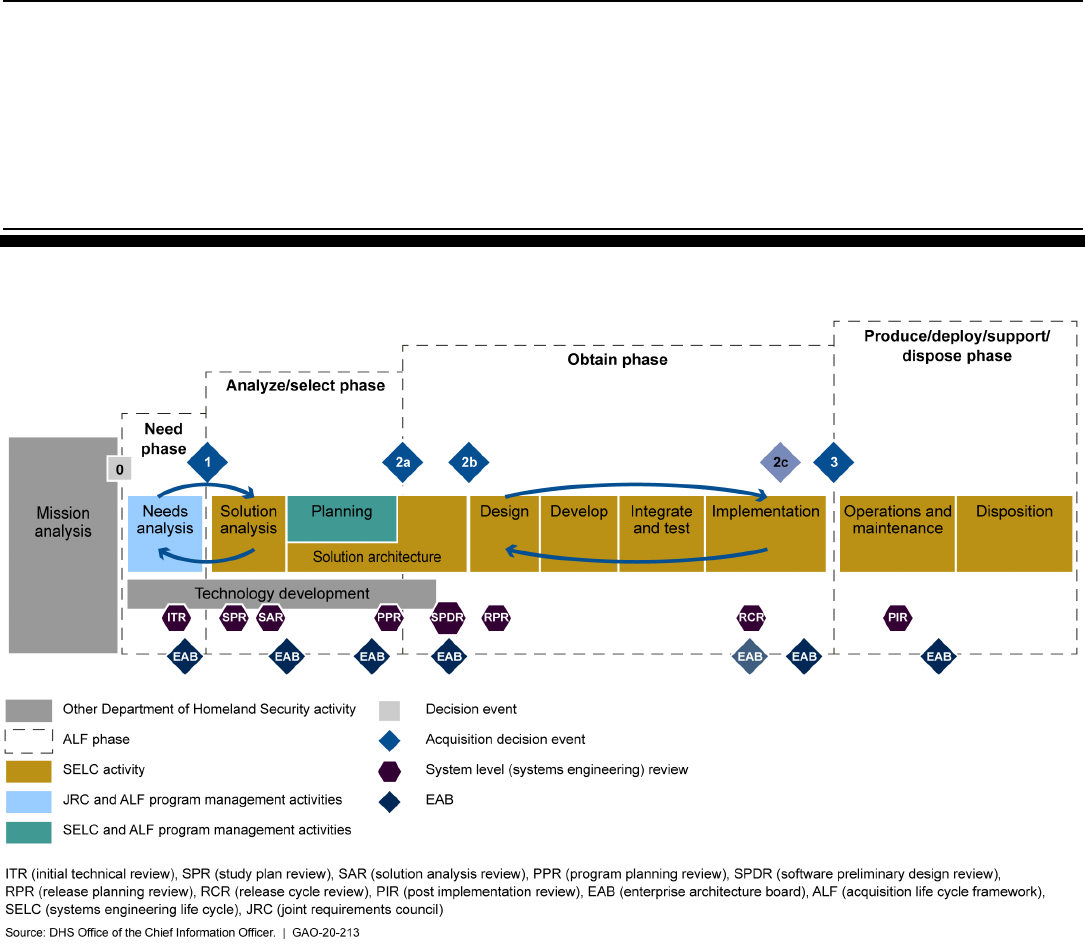
Appendix III: Leading Practices for Adopting
Agile Development—Agency Environment
Page 54 GAO-20-213 Agile Software Development
Figure 3: Optional Tailoring of the DHS Acquisition Life Cycle Framework (ALF) and Systems Engineering Life Cycle (SELC)
for Agile Major Acquisition Program
Outside of technical reviews, DHS updated acquisition policy in February
2019 and associated guidance in May 2019 to allow programs greater
flexibility in the larger ALF. The Director of Strategic Technology
Management (STM) stated that, under the previous acquisition policy and
guidance, IT programs were using in-house expertise due to limited
funding to prepare for the 2B decision, when full program funding was
received. He noted that, by the time a contract was awarded for
development following a 2B decision, the contractor might or might not
have been using planning artifacts developed by the program and instead
might have recreated them, thereby rendering 2 to 3 years of work
useless. The Director stated that programs were unable to fully flesh out
the program architecture and other key aspects of the program because
programs did not receive funding until the 2B decision and in-house
expertise was limited. For example, if a program had not proven out its

Appendix III: Leading Practices for Adopting
Agile Development—Agency Environment
Page 55 GAO-20-213 Agile Software Development
architecture prior to a 2B decision, it could continue to refine and modify
the architecture during the course of development, thereby impacting
productivity and quality. DHS updated acquisition management policy and
guidance to modify the requirements for the acquisition decision events
and addressed a related GAO recommendation.
5
DHS policy and guidance also allowed for programs to modify
requirements over the course of development. The traditional process for
requirements may be modified as part of tailoring the SELC in order to
allow for increased flexibility. The DHS Requirements Engineering User’s
Guide detailed requirements engineering steps, activities, and methods
for performing those steps.
DHS developed this user guide to supplement SELC policy and guidance.
One section of this guide focused on Agile development. According to the
guide, requirements are broken down over the course of the ALF and
commitments are made at different levels of specificity. Fundamental
capability gaps are defined in the mission needs statement presented at
acquisition decision event 1. Subsequently, the analyze/select phase
would ultimately define the high-level features and functions of each
required capability, define the fundamental performance of those high-
level features and functions, and establish the business case to support
approving the acquisition at an acquisition decision event 2A. Often, a
preliminary concept of operations is developed and delivered with the
mission needs statement.
The guide also states that the activities to evaluate these potential
alternatives will ultimately result in a preferred solution with defined
business practices, methods, and processes that allow the development
of business epics and associated architecture epics. Business epic is an
Agile term that defines the high-level “stories” that describe a capability,
or what the new system is required to perform. Architectural epic is an
Agile term that defines the architecture the system will be incorporated
into. In addition, the preferred solution would have defined high-level
5
GAO, Homeland Security Acquisitions: Earlier Requirements Definition and Clear
Documentation of Key Decisions Could Facilitate Ongoing Progress, GAO-17-346SP
(Washington, D.C.: Apr. 6, 2017). In this report, GAO recommended that the Secretary of
Homeland Security direct the Undersecretary for Management to require that major
acquisition programs’ technical requirements be well defined and key technical reviews be
conducted prior to approving programs to initiate product development and establishing
acquisition program baselines, in accordance with acquisition best practices. This
recommendation was intended to mitigate the risk of poor acquisition outcomes and
strengthen the department’s investment decisions.

Appendix III: Leading Practices for Adopting
Agile Development—Agency Environment
Page 56 GAO-20-213 Agile Software Development
performance requirements (stated from the operational perspective) in
terms of how well the solution must perform to be operationally effective
and suitable. Key constraints such as security, Section 508 compliance,
privacy, reliability, etc., should also be identified. These top-level
requirements will be documented in the operational requirements
document.
According to the guide, Agile teams capture the capabilities and
constraints (essentially the functional and non-functional requirements
that reflect the business epic level of performance) in an artifact called the
capabilities and constraints document. Requirements statements in this
document should follow the standard “shall statement” format for ease of
translation between the operational requirements document and the
capabilities and constraints document. The capabilities and constraints
document and its contents mature over time and, as the document
matures, business and architectural epics decompose to
features/functions or themes, and ultimately to user stories that reflect the
specific tasks that users will perform. Officials within the DHS Joint
Requirements Council noted that headquarters involvement occurred at
this level to approve the high-level operating requirements.
After headquarters oversight and approval, the program may then
decompose requirements as part of planning for and executing technical
reviews. If tailored into an Agile program, the capabilities and constraints
document should drive the development of a backlog. The backlog is a
list of all the user stories that describe what the system needs to do. The
backlog should become more refined as the program decomposes the
high-level features (a service that fulfills a user need) and functions down
to specific stories that an individual software developer will code and test
during a specific iteration.
To prevent the backlog from becoming unmanageable, DHS guidance
stated that backlogs may be established at different levels. For example,
the business and architectural epics along with the associated operating
requirements would constitute the “program backlog.” Sub-epics are
usually broken down into “high-level features” with business epics broken
down into business features and architectural epics broken down into
architectural features. Features or functions are decomposed into detailed
stories that are then allocated to a “release”. The list of user stories in a
specific release constitutes the release backlog. This process of
decomposing stories continues to the iteration backlog.

Appendix III: Leading Practices for Adopting
Agile Development—Agency Environment
Page 57 GAO-20-213 Agile Software Development
DHS guidance places an emphasis on end user needs. The
Requirements Engineering User’s Guide raised the importance of
identifying stakeholders, including system users, and capturing the needs
of those users via requirements or, in the case of Agile, user stories. The
Agile instruction manual placed an emphasis on the importance of users
to a program and articulated that the product owner represent the user
community and was expected to continually seek ongoing feedback and
elicit requirements from users. The Agile core metrics also strongly
recommended the use of a net promoter score. This score was one
mechanism for measuring customer satisfaction through asking users to
rank how likely they would be to recommend the system or application to
a friend or colleague, based on a score of 1 to 10.
Clearly align goals and objectives
Program goals should clearly reflect stakeholder needs and concerns
based on input from stakeholders and stakeholder review and approval.
Program goals should align with strategic IT objectives. Software-related
goals should be defined and clearly aligned with program goals. The
agency should collect objective measures that are well defined to track
progress towards achieving software goals so the agency knows which
features and capabilities have been achieved.
The Requirements Engineering User’s Guide described program
expectations for tracing from mission needs to operating and functional
requirements, or user stories. The guide recognized that, as a program
progressed through the ALF and SELC, it was important to trace
requirements from the top-level mission needs or capabilities and/or
business requirements down to the system/sub-system, component, or
configuration item level that enabled those requirements to be met. This
helped ensure continuity across various DHS artifacts, such as the
program’s mission need statement, concept of operations, and
operational requirements document, to vendor specifications (or
applicable equivalent artifacts). Although an Agile program will modify the
SELC to accommodate its needs, generally programs were expected to
follow the same conceptual approach to the requirements of planning,
development, and management.
The user’s guide stated that collaboration among the various
stakeholders was important and the program requirements team must
continuously work to establish partnerships and networks. To do so, the
guide stated that the program team must identify all individuals and
organizations that may be impacted by their program and ensure those

Appendix III: Leading Practices for Adopting
Agile Development—Agency Environment
Page 58 GAO-20-213 Agile Software Development
stakeholders were engaged throughout development to facilitate
understanding of their perspectives and needs. The first step was to
identify applicable stakeholders, which would include end users, program
sponsors, developers, maintainers, trainers, and other affected individuals
or organizations. The program requirements team then solicited input
from these stakeholders to understand their needs, policies, processes,
and operations to begin the requirements definition effort. It identified
some ways a team might begin the process of eliciting requirements from
the stakeholders.
After collaborating with stakeholders, the stakeholder needs must be
translated into the program requirements, or goals. The guide stated that
the program requirements team should take the inputs from the various
stakeholders and decompose, prioritize, de-conflict, and validate the
needs identified. It clarified that a “good” requirement was achievable,
testable, clear, concise, technology-independent, feasible, and able to
stand alone.
The guide grounded all of the requirements elicitation and development
process in the overall contribution to the agency mission, recognizing the
need for general strategic alignment. In particular, the guide noted that
requirements were “mission need” driven as opposed to “solution” driven.
Requirements were developed throughout the life of a program, with the
first formal requirements being the operating requirements documented in
the operational requirements document.
To ensure that DHS’s mission or strategic goals were key inputs for
decision making, DHS relied, in part, on its enterprise architecture
process. DHS policy for enterprise architecture stated that the enterprise
architecture program provided a vehicle to tie the strategic mission goals
and objectives of DHS to the business processes, information resources,
and technology investments necessary to reach key performance
outcomes. This methodology was intended to integrate IT into the mission
and strategic priorities of DHS, which provided the core foundation for all
subsequent processes. DHS capital planning and investment control
guidance reinforced this fact, stating that the Federal Acquisition
Streamlining Act of 1994 required capital investments to align with
mission and strategic goals. This included the framework within which the
department formulated, managed, and maintained its portfolio of
investments as critical assets for achieving success in the DHS mission
and alignment to the DHS IT Strategic Plan and the DHS Strategic Plan.

Appendix III: Leading Practices for Adopting
Agile Development—Agency Environment
Page 59 GAO-20-213 Agile Software Development
Cascading sponsorship for Agile software development
Senior stakeholders should support and model the use of Agile, along
with its values and principles, through explicit policy or guidance
impacting the business and should take steps to complete responsibilities
defined in agency Agile policy or guidance. Agile should also be
supported in all relevant areas of the business impacting a software
development project through the use of Agile sponsors. These sponsors
should represent the lines of business in key agency decisions on Agile.
Senior stakeholders at DHS demonstrated support for Agile through the
publication of policy and guidance that established Agile development as
the department’s preferred approach for software development. As
discussed previously, the department published Instruction 102-01-004
Agile Development and Delivery for Information Technology (Agile
instruction), which provided the scope, definitions, roles and
responsibilities, and procedures to establish an Agile framework for the
development of IT acquisitions at DHS.
6
Specifically, the Agile instruction
established responsibilities for the CIO, the Chief Procurement Officer,
the Chief Financial Officer, the Director, Office of Test and Evaluation
within the Science & Technology Directorate, and the Executive Director
of PARM.
Each of these five stakeholders and their associated components
demonstrated their support for Agile development by taking steps to
complete their responsibilities defined in the Agile instruction. For
example, the Office of the Chief Information Officer (OCIO), the Office of
the Chief Procurement Officer, and the Director, Office of Test and
Evaluation within the Science and Technology Directorate all had
responsibilities related to providing guidance for the implementation of
Agile within their specific area of expertise. All three components had
taken steps to execute these responsibilities, such as by publishing the
Agile instruction manual, providing supplementary guidance for test and
evaluation in an Agile environment, and offering elective training on
contracting strategies for Agile services.
Representatives from offices with a role in software development also
supported Agile via membership in the IT Program Management Center
of Excellence (ITPM COE). In addition to the stakeholder organizations
6
Department of Homeland Security, Instruction 102-01-004, Agile Development and
Delivery for Information Technology, Revision 01 (Washington D.C.: Apr. 16, 2018).
Agency culture supports Agile
methods

Appendix III: Leading Practices for Adopting
Agile Development—Agency Environment
Page 60 GAO-20-213 Agile Software Development
identified in the Agile instruction, the ITPM COE membership included
representatives from the Joint Requirements Council
7
and the Chief
Privacy Officer.
8
According to the ITPM COE charter, the ITPM COE
served as a cross-functional team to identify and promote best practices,
provide tools, and coordinate assistance for programs and projects to
maximize the successful management of DHS IT investments. This
included making progress towards the 18 Agile action plans that resulted
from the Agile acquisition pilots.
The ITPM COE membership requirements called for representatives of
the member organizations to be involved in key decisions regarding Agile.
According to the Director of STM within OCTO, ITPM COE members
were selected and approved by their organization’s executives. The ITPM
COE charter stated that these representatives must be authorized to
represent or make decisions on behalf of their officers or organizations.
9
Officials from all ITPM COE member organizations expressed support for
the ITPM COE and confirmed that their component was appropriately
represented in decision making. This was represented, in part, by the fact
that at least one representative for each ITPM COE member group
attended at least half of the meetings. For example, at least one
representative from the Science and Technology Directorate attended
approximately 95% of the meetings.
7
According to Directive 102-01, Acquisition Management, the Joint Requirements Council
provides oversight of the DHS requirements generation process, harmonizes efforts
across the department and makes prioritized recommendations to the Deputy’s
Management Action Group for those validated requirements. The Deputy’s Management
Action Group provides recommendations to the Deputy Secretary for consideration in the
annual program and budget review, which reflects DHS’s investment priorities. The
Deputy’s Management Action Group reviews Joint Requirements Council-validated
capability needs and recommendations; provides direction and guidance to the Joint
Requirements Council, and endorses or directs related follow-on Joint Requirements
Council activities.
8
According to Instruction 102-01-001, Acquisition Management, the DHS Chief Privacy
Officer is responsible for, among other things, reviewing and approving privacy
compliance documentation for DHS acquisitions and ensuring that the department follows
DHS privacy policy, applicable privacy laws, and government-wide privacy policies for
collecting, using, maintaining, disclosing, deleting, or destroying personally identifiable
information.
9
Department of Homeland Security, Charter Information Technology Program
Management Center of Excellence (ITPM COE), Version 2.1 (Washington D.C.: May 15,
2018).

Appendix III: Leading Practices for Adopting
Agile Development—Agency Environment
Page 61 GAO-20-213 Agile Software Development
Sponsor understanding of Agile software development
Sponsors should understand and communicate changes resulting from
Agile development. Sponsors should attend training or receive coaching
on Agile and the agency’s framework, the agency should monitor
completion of training, and sponsors should transmit learning from
training to staff. Sponsors should also commit to achieving those intended
results and sponsor performance should be tied to achieving those
intended results.
The Director of STM stated that Agile sponsors were considered to be
chief executive officers (e.g. Executive Director of PARM and the Deputy
Under Secretary for Management). They oversaw the actions of the ITPM
COE and approved the Agile action plans in June 2017.
DHS did not ensure that Agile sponsors attended training or received
coaching in Agile development. The department made training available
for Agile, including courses such as those required for acquisition
professionals. However, in a written response, the Office of the Chief
Human Capital Officer stated, and the Director of STM confirmed, that the
department did not administer mandatory training on Agile for Agile
sponsors.
The department also did not monitor the completion of sponsor training in
Agile. Although DHS employees leveraged the Federal Acquisition
Institute Training Application System to track their training and
certifications, the department was not using this system to monitor
sponsor training in Agile. According to a written response from the Office
of the Chief Human Capital Officer, the department did not keep a record
of whether sponsors completed training in Agile because the department
did not require Agile training specifically for sponsors.
DHS Agile sponsors exhibited support for achieving the intended results
from the transition to Agile. Agile sponsors committed to achieving these
results through an endorsement of the 18 Agile action plans and the
associated implementation plans.
However, DHS did not demonstrate that Agile sponsor performance was
tied to achieving the intended results of the transition to Agile. According
to a written response from the Office of the Chief Human Capital Officer,
the department’s employee performance management policy did not
specifically address Agile. This written response further stated that
addressing Agile in these policies was unnecessary because the Office of

Appendix III: Leading Practices for Adopting
Agile Development—Agency Environment
Page 62 GAO-20-213 Agile Software Development
the Chief Human Capital Officer incorporated goals derived from project
plans in individual performance plans. DHS policy and guidance for
performance management identified individual performance goals as a
component of employee performance, but the department did not provide
evidence that specific performance plans for the sponsors were linked to
such goals.
Establish an environment supportive of Agile software development
Team dynamics should be facilitated through access to common team
rooms and/or modern communication and social media methods and
headquarters infrastructure operations should allow for communal spaces
and co-location in program offices. A headquarters technical environment
should allow access to tools by programs to foster distributed
communication, and there should be a process for continuous feedback
on the Agile environment and modifications to that process (e.g.
communities of practice, routine working group sessions). Agency
governance bodies should allow programs greater autonomy and
flexibility within existing acquisition processes through the modification of
gate reviews and other touchpoints in the acquisition process for Agile
projects and increased transparency for governance bodies into project
operations when necessary.
DHS policy and guidance allowed for team dynamics to be facilitated
through access to common team rooms and modern communication
methods. In addition, department policy promoted and allowed program
offices to support team dynamics through the use of communal spaces
and co-location. Specifically, the Director of Systems and Information
Integration within the Chief Readiness Support Office confirmed that DHS
had modified policy related to infrastructure operations to allow any office
to reorganize their space, citing the USCIS Transformation program as an
example of this reorganization. The Director of Systems and Information
Integration also noted that he was not aware of any restrictions to this
practice in policy. With respect to facilitating access to modern methods
of communication, DHS offered programs the option of using a suite of
tools that included those for distributed communication.
DHS took multiple steps to establish a process for continuous feedback
related to the department’s Agile environment and process modifications.
According to the Director of STM, OCIO built support for Agile through the
Centers of Excellence, communities of interest, brown bag lunches, and
public speaking engagements. The Director added that these sessions
facilitated the discussion of Agile and could be used to compile feedback.

Appendix III: Leading Practices for Adopting
Agile Development—Agency Environment
Page 63 GAO-20-213 Agile Software Development
The Director of STM explained that, as this feedback came in, it was
either addressed immediately or put into a backlog. Efforts to further
streamline the acquisition process were tracked via Agile action plan 6.
The department’s governance bodies also increased transparency into
project operations when necessary. The Agile Development and Delivery
for Information Technology Instruction Manual (Agile instruction manual)
stated that the program or project manager should coordinate with the
various oversight bodies that govern IT development. These bodies
varied depending on the level of investment, but, for major programs,
executive steering committees were often established to oversee all
aspects of program planning and execution between major acquisition
decision events. In addition, PARM officials stated that DHS increased
the frequency of acquisition review board reviews and modified the
content presented at the reviews to allow it to be more actively involved
with projects earlier in the acquisition life cycle. Specifically, PARM
updated the Acquisition Review Board slide templates and informed us of
its intent to update acquisition management policy to require Agile
projects to hold Acquisition Review Board reviews once every six months,
as opposed to once every 12 months.
Align incentives and rewards to Agile methods
The agency should establish an incentive and reward structure promoting
team successes and the value of individuals within those teams.
Management should establish agency goals to align incentives and
rewards with Agile methods. Goals for incentives and rewards should
align with the agency’s goal(s) and focus on team success. The agency
should allocate incentives and rewards based on team success.
DHS did not establish an incentives and rewards structure that promoted
team successes and did not demonstrate that management had
established agency goal(s) to align incentives and rewards with Agile
methods. Furthermore, the department did not demonstrate that human
resources and others were actively involved in setting goals for incentives
and rewards alignment.
DHS guidance specifically discussed contract incentives for Agile
projects. For example, the Agile instruction manual suggested that
consideration be given to address the duration of the base term and
options, scalability, deliverables, and pricing with a mindset that
contractors need appropriate incentives to encourage them to perform

Appendix III: Leading Practices for Adopting
Agile Development—Agency Environment
Page 64 GAO-20-213 Agile Software Development
well. The manual also stated that contract award terms could provide a
greater incentive for contractors working on longer-term Agile projects.
Although the department made efforts to adapt incentives and rewards for
contractors supporting Agile projects, it acknowledged that it did not
update existing incentives and rewards for federal employees working on
Agile projects. Officials within the Office of the Chief Human Capital
Officer stated that existing human capital and performance plan policy
allowed for rewarding and incentivizing Agile teams as well as individuals.
These officials further noted that DHS had numerous opportunities to
recognize and reward team or individual performance, regardless of the
development methodology a program relied on. Specifically, these
officials clarified that the Office of the Chief Human Capital Officer used
project plans to set goals and included those goals in employee
performance plans. As these officials felt the existing performance plan
policy was sufficient, they did not believe additional guidance or
modifications to existing policy were necessary.
Guidance is appropriate for Agile acquisition strategies
Agency acquisition policy and guidance should support awarding
contracts for the unique needs of an Agile program. Acquisition strategies
should recognize the need for interim delivery of software, allow for close
coordination between the contracting office and program office staff, and
allow for changing requirements and contract oversight mechanisms to be
tailored to support Agile development methods.
DHS offered guidance for preparing acquisition strategies through its
Procurement Innovation Lab.
10
Webinars offered by the Procurement
Innovation Lab on acquisition strategies for Agile programs discussed the
need for interim delivery of software, close coordination between
contractors and program office staff, contract oversight mechanisms that
were tailored to support Agile development, and changing requirements.
For example, the “Transportation Security Administration Agile Services
Procurement” webinar discussed planning, executing, and de-briefing
technical demonstrations used to select the contract recipient, paying
particular attention to the value of transparency and modifying contract
oversight mechanisms. Officials from the Office of the Chief Procurement
10
The Department of Homeland Security Procurement Innovation Lab, Office of the Chief
Procurement Officer, experiments with innovative techniques for increasing efficiencies in
the procurement process and institutionalizing best practices.
Agency acquisition policies and
procedures support Agile
methods

Appendix III: Leading Practices for Adopting
Agile Development—Agency Environment
Page 65 GAO-20-213 Agile Software Development
Officer clarified that the webinars were available as needed and were not
required training.
DHS also published Agile guidance that discussed contracting and
acquisition strategies. From an oversight perspective, according to the
Agile instruction manual, DHS executive steering committees oversee all
aspects of program planning and execution between acquisition decision
events. This authority extends to assisting programs in developing
acquisition strategies where appropriate. The manual included a section
that specifically called out Agile contracting considerations that pointed
back to Office of Management and Budget Contracting Guidance to
Support Modular Development, the TechFAR handbook, the Digital
Services playbook, and innovative contracting case studies.
Among other useful information in the Agile instruction manual were key
contracting considerations for an Agile program or project manager.
These considerations included, among other things, frequent, iterative
deliveries of software, an ability to monitor changes to maintain contract
and project scope, flexibility to accommodate refinement of requirements,
transparency and collaboration, and prior experience in the Agile
methodology. The manual also highlighted goals for the acquisition to
discuss with a contracting officer, such as rapid contracting processes to
keep pace with Agile development, contracting to accommodate
incompletely defined scope and requirements, and the ability to respond
to requirements changes without requiring extensive change orders.
According to officials within OCTO and the Office of the Chief
Procurement Officer, the department also supported Agile programs in
preparing acquisition strategies through the IT acquisition review process.
This process was established to provide a mechanism for the DHS Chief
Information Officer to review and guide agency IT expenditures. The
process was intended to analyze IT acquisitions to ensure alignment with
DHS missions, goals, policies, and guidelines. This process relied on
subject matter experts to assist in the review of IT acquisitions, including
one for Agile reviews. According to the IT Acquisition Review Essentials
Guide, Agile reviews occurred where software was being developed to
ensure development activities adhered to Agile best practices and DHS
SELC guidance. The Agile subject matter expert was expected to review
acquisition materials against an established set of criteria for both the
acquisition plan and the requirements document. For example, when
reviewing the acquisition plan for approval, the subject matter expert
should consider if the statement of need adequately addresses Agile or
iterative project-specific activities and/or deliverables.

Appendix III: Leading Practices for Adopting
Agile Development—Agency Environment
Page 66 GAO-20-213 Agile Software Development
The Director of STM stated that there is one staff member in STM who
actively participates in the IT acquisition review process and was
responsible for ensuring Agile language was correctly implemented in
contract statements of work. The Director also added that they were
willing to help teams that were having trouble providing explanations of
Agile processes in their statements of work. The Director of STM stated
that there was no policy to guide his staff member reviewing Agile
language in the statement of work, but that he asked his division to put
together a checklist review to govern this process. The Director added
that the department sent programs and projects requiring assistance with
Agile contracting to the Procurement Innovation Lab by request to
streamline the acquisition plan.
According to the Leader of the Procurement Innovation Lab Team, the
Office of the Chief Procurement Officer was primarily focused on
supporting Agile pilot programs, such as the Federal Emergency
Management Agency Grants Management Modernization program. The
team leader noted that, while the procurement office supported these
programs, it relied on the program offices to ensure accuracy. For
example, the program management office ensures that the requirements
are structured and delivered, which could be challenging for Agile
programs. The team leader mentioned that a particular focus at the
moment was defining the pricing for contract line item numbers in such a
way as to afford the flexibility needed for Agile development while still
holding contractors accountable.

Appendix IV: Leading Practices for Adopting
Agile Development—Program Processes
Page 67 GAO-20-213 Agile Software Development
This appendix describes in greater detail our evaluation of the three
leading practices for program processes when adopting Agile
development. It does not present new findings; rather, the information is
intended to assist the Department of Homeland Security (DHS) in
implementing the recommendations described in this report.
Program processes refer to leading practices related to the program office
and technical environment. For programs to successfully transition from
processes used for traditional development projects, programs should
ensure that
• staff are appropriately trained in Agile methods by
• training all program staff
• ensuring Agile teams have the appropriate technical expertise
needed to perform their roles
• technical environments enable Agile development through
• making technical and project support tools available, and
• designing a system that supports iterative delivery
• project planning controls are compatible with Agile methods by
• maintaining a sustainable development pace and tracking and
monitoring that development pace
• defining and incorporating non-functional requirements in
development
• defining and incorporating critical features in development
The department develops an environment that supports these processes.
Within DHS, program management offices are responsible for planning
and executing individual programs and implementing applicable Agile
methodologies. In addition, the DHS Office of the Chief Information
Officer (OCIO) is responsible for setting policies and procedures to
ensure that programs leverage Agile development best practices to meet
the department’s goals and are within acquisition policy. The DHS OCIO
is also responsible for providing guidance for and reviewing the adoption
and execution of Agile development.
Train all program staff in Agile methods
The agency should provide a training program in Agile for staff and track
and monitor the training. All members supporting the team, not only the
Appendix IV: Leading Practices for Adopting
Agile Development—Program Processes
Staff are appropriately trained
in Agile methods

Appendix IV: Leading Practices for Adopting
Agile Development—Program Processes
Page 68 GAO-20-213 Agile Software Development
software development team, should be trained in the specific Agile
framework they will be using.
DHS required its acquisitions workforce to take training that incorporated
Agile methods. DHS Instruction 102-01-006, Acquisition Program
Management Staffing, established certifications for key acquisition career
fields, which included training requirements.
1
According to the Associate
Director for Training from the Homeland Security Acquisitions Institute,
the certification requirements included training that has been updated to
incorporate Agile methods. Specifically, the department updated course
content for AQN 101: DHS Fundamentals of Systems Acquisition to
include Agile development concepts, such as small team management
and Agile metrics, following the issuance of department policy governing
Agile development. This course was required training for seven of the
acquisition career fields, including program and project managers,
systems engineers, and test and evaluation managers.
DHS tracked and monitored the completion of training requirements for
the acquisitions workforce. According to DHS Directive 064-04,
Acquisition Professional Career Information, component acquisition
executives were responsible for ensuring that acquisition personnel met
the mandatory training requirements.
2
Officials from the Homeland
Security Acquisitions Institute within the Office of the Chief Procurement
Officer stated that DHS employees leveraged the Federal Acquisition
Institute’s training application system to track their training and
certifications. According to the catalog of product services of the institute,
members of the DHS acquisition workforce were required to attach copies
of their training certificates to request certification of completion of the
required training.
Because the DHS acquisitions workforce may not cover all personnel
staffed to Agile projects, some program staff may not be subject to
training requirements that incorporate Agile methods. According to the
Director of the Homeland Security Acquisition Institute, certain Agile team
members, such as the product owner, were not necessarily classified as
part of the acquisitions workforce. For example, according to the U.S.
Immigration and Customs Enforcement (ICE) Student and Exchange
1
Department of Homeland Security, Instruction 102-01-006, Acquisition Program
Management Staffing (Dec. 2, 2016).
2
Department of Homeland Security, Directive 064-04, Acquisition Professional Career
Information, Revision 00 (Oct. 30, 2008).

Appendix IV: Leading Practices for Adopting
Agile Development—Program Processes
Page 69 GAO-20-213 Agile Software Development
Visitor Information System (SEVIS) program staffing plan, the product
owner role was not part of the acquisitions workforce and did not require
any certifications.
To help address the Agile training needs of all staff, including those who
are not part of the acquisitions workforce, DHS also provided elective
training in Agile methods. The department offered commercial training
through the Homeland Security Acquisition Institute, such as acquisition
of Agile services and Agile requirements for creating user stories. The
DHS Agile instruction manual also identified training offered by the U.S.
Citizenship and Immigration Services Office of Information and
Technology as another resource on Agile concepts, such as user stories
and automated testing.
In addition to elective training, the Agile Development and Delivery for
Information Technology Instruction Manual (Agile instruction manual)
encouraged program managers to seek out an Agile coach to help teams
adopt Agile methods and supplement training.
3
The instruction manual
suggested that program managers should identify an Agile coach to serve
as an embedded trainer, consultant, and team advisor. This Agile coach
could help the team adapt Agile methods to their environment and work
through challenges. An Agile coach could also help individual team
members understand the responsibilities of their role on an Agile team.
Although DHS did not provide coaches for Agile teams, the department
offered resources that could help programs select and obtain an Agile
coach. First, the department established a blanket purchase agreement
for programs to acquire Agile development support in the form of hands-
on coaching services for the design and use of Agile methods. According
to Homeland Security Acquisition Institute officials, this agreement would
enable programs and projects to acquire Agile coaching. Among other
things, this agreement defined the scope of Agile coaching services and
their pricing so that programs would not need to develop these terms on
their own. Second, the Agile instruction manual included considerations to
help program managers select a qualified Agile coach. For example, the
instruction manual encouraged program managers to collaborate with
contracting officials to identify an Agile coach who had demonstrated
3
Department of Homeland Security, Instruction Manual 102-01-004-01, Agile
Development and Delivery for Information Technology Instruction Manual, Revision 00
(Jul. 15, 2016). The Agile instruction manual defines an Agile coach as an individual who
has significantly broad experience applying Agile approaches to software and
development efforts.

Appendix IV: Leading Practices for Adopting
Agile Development—Program Processes
Page 70 GAO-20-213 Agile Software Development
successful past performance on projects implementing similar technology
and Agile methodologies.
Case Study Example
The U.S. Customs and Border Protection’s (CBP) Biometric Entry Exit
(BEE) program’s Air Exit project provided informal training for new team
members that included a discussion of Agile methods. According to the
Air Exit project manager in the Office of Information and Technology, new
team members received onboarding training that covered CBP’s
approach to Agile methods. The project did not track attendance for this
onboarding training, but an Air Exit project manager noted that team
members were incentivized to attend the training in order to learn how to
satisfy their responsibilities. The Scrum master for the Air Exit project
stated that this training was also available to the team as a refresher
course approximately every fiscal quarter.
The BEE program also relied on an Agile coach to support the Agile
team. According to the Agile coach supporting the Air Exit project, this
role included training for the Agile team on basic Agile topics and working
with the team on their use of a project management software tool.
According to a project manager within the Office of Field Operations Air
Exit project management office, the Agile coach that supported the
project was instrumental in designing the CBP Office of Information and
Technology’s Agile development program beyond the BEE program.
Ensure Agile teams have the appropriate technical expertise needed
to perform their roles
The agency should have policy or guidance in place to help programs
ensure Agile teams have the appropriate technical expertise. A program
should also consider Agile-centric skills when forming teams. In addition,
programs should define requirements for contractor proposals and
evaluate contractor proposals for Agile services (e.g., source selection).
DHS guidance provided programs with considerations for forming teams
with Agile-centric skills. The DHS Agile instruction manual stated that a
development team with experience in Agile practices can mitigate risks to
on-time delivery. This experience included Agile processes as well as
technical skills, such as automated testing. In the context of the Agile
Scrum methodology in particular, the Agile instruction manual stated that
teams needed to be cross-functional and have all of the skills required to
deliver a project from conception to delivery.

Appendix IV: Leading Practices for Adopting
Agile Development—Program Processes
Page 71 GAO-20-213 Agile Software Development
To enable teams to deliver a project from conception to delivery, the Agile
instruction manual stated that program managers should seek team
members with general skills. The manual advised that team members
should contribute to routine development activities and possess cross-
functional expertise that allows the team to achieve work without
depending on individuals outside of the team. For example, in Agile
development, testers are part of the development team and should
therefore possess both testing and development skills. In addition, the
instruction manual stated that, according to industry experts, program
managers should seek some overlap in team member’s skillsets to
mitigate risks associated with a key person becoming temporarily
unavailable.
DHS guidance further provided programs with considerations for defining
requirements in solicitations for contract proposals for Agile services. For
example, DHS supplemental guidance for incorporating testing and
evaluation into contract requirements noted that contracts should specify
government test and evaluation staff, as well as contractors, on the
development team in order to access the test data they need.
4
The DHS IT acquisition review process also helped to ensure that
requirements were defined in solicitations for contractor proposals.
5
According to the Information Technology Acquisition Review Essentials
Guide, Agile subject matter experts in the department review proposed
contracts to ensure that they will enable development activities that
adhere to Agile best practices and DHS systems engineering life cycle
(SELC) guidance.
6
For example, Agile subject matter experts should
assess whether contract requirements documents, such as the statement
4
Department of Homeland Security, DHS Supplemental Guidance: Incorporating T&E into
Acquisition Contracts, Version 1.0 (Jan. 2019).
5
According to the Information Technology Acquisition Review Essentials Guide, the
Information Technology Acquisition Review process was established to provide a
mechanism for the DHS Chief Information Officer to review all IT acquisitions and
contracts in accordance with the Federal Information Technology Acquisition Reform Act
of 2014. As part of this process, subject matter experts at the department level, such as
those for Agile and the SELC, review the documents associated with the acquisition
request for alignment with DHS Chief Information Officer’s IT strategy, and for compliance
with laws and policies governing DHS IT. The subject matter experts then make a
recommendation to the DHS Chief Information Officer regarding whether to approve,
approve with conditions, or disapprove the acquisition request.
6
Department of Homeland Security, Information Technology Acquisition Review (ITAR)
Essentials Guide, Version 6 (Oct. 2017).

Appendix IV: Leading Practices for Adopting
Agile Development—Program Processes
Page 72 GAO-20-213 Agile Software Development
of work, are prepared in terms that will enable vendors to clearly
understand the Agile requirements.
The department also provided guidance to assist programs in evaluating
contractor proposals for Agile services. The Agile instruction manual
noted that programs can consider certifications in various Agile
methodologies and recommended that programs coordinate with
contracting officials to review vendors’ past performance in implementing
Agile methods.
In addition, the department established the Procurement Innovation Lab
within the Office of the Chief Procurement Officer to help programs
address challenges in procuring Agile services, such as validating
contractor qualifications. According to a Procurement Innovation Lab
team leader, the lab shares lessons learned from Agile services contracts
via webinars, which are available to staff on an as-needed basis. Several
of these webinars highlighted the value of using technical demonstrations
to validate the qualifications of vendors.
Case Study Example
The ICE SEVIS program provided training for all team members,
including contractors, to ensure they had the necessary Agile-centric
skills and expertise. A team process agreement for one development
module showed that the technical lead, development team, test engineer,
and Scrum master roles were filled by contractors, while other positions
such as the project manager, product owner, and test automation subject
matter expert roles were filled by government employees.
7
According to
the ICE SEVIS program manager and Scrum master, the program
provided training for contractors that covered Agile processes as well as
technical and project management support tools.
8
In addition, some
government employees took role-specific training. For example, the
program’s test automation subject matter expert completed training in
continuous integration and test automation.
To further ensure contractors on ICE SEVIS Agile teams had the
necessary Agile-centric skills, the ICE SEVIS program defined the Agile
7
U.S Immigration and Customs Enforcement, ICE Team Process Agreement for SEVIS
Information Sharing.
8
U.S. Immigration and Customs Enforcement, SEVP Agile Overview for Development
Teams (Sept. 2018).

Appendix IV: Leading Practices for Adopting
Agile Development—Program Processes
Page 73 GAO-20-213 Agile Software Development
methodology and necessary technical expertise for contractors in the
contract requirements. For example, the performance work statement for
one development module required contractors to use the program’s
management software tool to track user stories. The performance work
statement also required use of the program’s continuous integration and
automated testing tools. The terms and conditions for this contract also
identified the required experience for key personnel, such as proven
experience working in an Agile environment.
The ICE SEVIS program also evaluated contractor qualifications to
ensure they had the necessary technical expertise. According to the
program manager, contractor qualifications were evaluated in two stages;
first, by assessing the contractor’s proposal, and second, by conducting a
technical challenge to ensure that contractors could demonstrate the
technical skills in the proposal. According to the instructions included in
the request for contractor proposals, this technical challenge required the
contractor to leverage Agile best practices to design, develop, and
demonstrate working software that addressed user stories provided by
the program. Although the instructions stated that contractors were
required to follow Agile methods, the ICE SEVIS program manager stated
that the primary goal of the technical challenge was to assess
development skills rather than knowledge of Agile.
Agency policy or guidance should call for technical and project tools to be
available to support Agile development and for system design that will
support iterative delivery.
Make technical and project support tools available
Project management and technical support tools should be integrated into
a program’s technical environment, where appropriate. The tools within
this technical environment should be readily available to Agile teams.
DHS policy and guidance called for Agile projects’ technical environments
to support Agile methods. The department published guidance for
standing up technical environments specifically for Agile projects. For
example, the DHS Agile instruction manual identified the benefits of using
program support tools for tracking program progress, reporting on that
progress as part of program governance, and automating tests within an
Agile technical environment. The manual stated that a program or project
manager is responsible for fostering an environment that enables the
Agile team to succeed, including obtaining the appropriate tools.
Technical environments enable
Agile development

Appendix IV: Leading Practices for Adopting
Agile Development—Program Processes
Page 74 GAO-20-213 Agile Software Development
To supplement this guidance, DHS offered a suite of tools that Agile
programs could access. The suite of tools was referenced in a checklist of
activities for program or project managers in the Agile instruction manual.
According to an IT specialist from the Technical Architecture and
Engineering division within the Office of the Chief Technology Officer
(OCTO), the tools available included program management tools as well
as technical tools. The specialist stated that OCTO provided programs
with access to this suite of tools to build support for and familiarity with
the tools, evaluating any requested plug-ins from programs and doing
their best to accommodate them.
Case Study Example
The ICE SEVIS program defined the technical environment to include
technical tools for automated testing and continuous integration. The
team process agreement for one of the program’s development modules
identified technical tools that supported continuous integration and testing
within the program’s technical environment.
9
This included Jenkins for
continuous integration as well as MUnit and Soap UI for continuous
testing. In addition, the ICE SEVIS Modernization Test and Evaluation
Master Plan discussed that tools for helping to ensure code quality, such
as an automated code analytics tool, should be used to identify test
coverage of code and cybersecurity code vulnerabilities.
10
The program also defined management support tools in the process
agreement. Specifically, it identified support tools for tracking and
knowledge management, such as JIRA and Confluence. The team
process agreement stated that JIRA should be the main knowledge
management tool and that all changes, discussion, and history should be
tracked in each ticket. This process agreement also stated that JIRA
should be the team’s tracking tool with Confluence used to provide
transparency.
9
U.S Immigration and Customs Enforcement, ICE Team Process Agreement for SEVIS
Information Sharing.
10
U.S Immigration and Customs Enforcement, Test and Evaluation Master Plan for the
Student and Exchange Visitor Information System Modernization, Version 1.2 (Feb. 19,
2018).

Appendix IV: Leading Practices for Adopting
Agile Development—Program Processes
Page 75 GAO-20-213 Agile Software Development
Design a system that supports iterative delivery
The agency should adopt policy or guidance that allows project designs to
develop modular system components and the program should establish a
loosely coupled architecture that allows for modular development.
DHS guidance allowed project designs to develop modular system
components through upfront architecture planning. The DHS Technical
Review Guide advises stakeholders to discuss and approve the technical
design of the system, including its top-level architecture, as part of the
system definition review. This review should take place prior to
development work.
For Agile programs, DHS suggested that programs may elect to switch
the system definition review with a release planning review. The SELC
Tailoring Examples for Selected Types of DHS Acquisition Programs
specified that this design discussion should take place as a part of
release planning. The department referred to this design as an
“architectural runway”, a description that should enable the team to
conceptualize how the user stories will be implemented. In exiting the
release planning review, the Technical Review Guide noted that
programs should answer whether or not an architecture exists, if the
architecture enables the deployment of the release, if architecture
collaboration is explained and understood for this development process,
and if the appropriate resources are available.
In addition to transitioning to a release planning review, DHS guidance
urged Agile programs to move away from traditional artifacts associated
with a system definition review. In this shift from traditional artifacts, the
department proposed that programs document software design within a
system design document on a release-by-release basis. According to the
Requirements Engineering Users Guide, in Agile methodologies detailed
design occurs at the iteration level and, as such, the design is
documented in an iterative fashion in the system design document. The
guide further stated that the system design document allows the
development team to communicate the design to others including
customers, managers, and other developers and that industry best
practice was to represent the design through a series of “design views.”
Each software design stakeholder could have a distinct perspective on
what are the essential aspects of a software design. Together, these
views provide a comprehensive description of the design in a concise and
usable form that simplifies information access and assimilation.

Appendix IV: Leading Practices for Adopting
Agile Development—Program Processes
Page 76 GAO-20-213 Agile Software Development
DHS guidance did not discuss the system design document as a
delivered artifact until after the sprint review and demo and a release
readiness review had been discussed.
11
At the end of each iteration, DHS
guidance stated that the system design document should represent the
design of the feature, function, and/or system as it existed at that
moment. To facilitate communication between Agile teams and to ensure
the most up-to-date description of the design is available, guidance called
for the system design document to be developed and maintained in an
electronic form using any number of programs or web tools that are
available. The Requirements Engineering Users Guide noted that the
system design document is to be considered complete when each
identified design concern is the topic of at least one design view, all
design constraints have been applied, and sufficient detail exists to be an
authoritative and primary “code-to” artifact.
The system design document should also provide traceability to the
feature, epic, and operational requirements document “shall” statements.
The SELC Tailoring Examples for Selected Types of DHS Acquisition
Programs stated that, prior to releasing software to the production
environment, a release readiness review should be conducted. As part of
this guidance, the department stated that the intent of this release
readiness review included ensuring that all elements of the release were
complete, including a system design document.
DHS guidance also discussed designing a loosely coupled architecture,
another important aspect of project design that facilitates modular
development. A member of the contractor support staff for the DHS OCIO
stated that the Enterprise Architecture Team was expected to consider
modularity and loose coupling generally through consideration of
technical complexity. According to DHS Enterprise Architecture principles,
technical complexity is to be mitigated in part by the implementation of
loose coupling.
12
According to the principles, DHS will incorporate loose
coupling into architecture and systems design to minimize the risk
resulting from changes within one system necessitating changes within
an interoperable system.
11
For the purpose of this report, we use the terms “sprint” and “iteration” interchangeably.
Figure 3 in the background does not cover a release readiness review. According to
officials from DHS OCIO, this technical review will be renamed the “release cycle review”
but serve the same purpose as the release readiness review.
12
Department of Homeland Security, Enterprise Architecture Principles (Oct. 2015).

Appendix IV: Leading Practices for Adopting
Agile Development—Program Processes
Page 77 GAO-20-213 Agile Software Development
Case Study Example
The BEE Air Exit project design document defined the planned design for
the system and addressed design and architectural concerns that could
affect the system’s operating environment.
As part of this design consideration, the project established a loosely
coupled architecture. This loosely coupled architecture was illustrated
within the project’s system design document. This system design
document defined the Traveler Verification Services software as
consisting of two distinct components: 1) traveler verification services
core and 2) traveler verification services matcher. The functionality and
responsibility of these two components were distinguished throughout the
document. Moreover, the document detailed how the Traveler Verification
Services software would be delivered as a system of applications,
combining an integration layer, business layer, data access layer, and
data layer.
Agency policy or guidance should call for teams to maintain a sustainable
development pace and track and monitor that pace and for non-functional
requirements and critical features to be defined and incorporated in
development.
Maintain a sustainable development pace and track and monitor that
development pace
The agency should have policy or guidance that calls for Agile projects to
establish a sustainable development pace. This guidance should be
supplemented by tracking and monitoring the pace. The program should
establish a sustainable pace for Agile projects and that pace should be
tracked and monitored.
DHS guidance called for Agile projects to manage the pace of the
software development. The Agile instruction manual stated that Agile
projects should consider velocity and burndown rates to track the overall
project status and update the project plan to reflect this status. In a
separate appendix, the Agile instruction manual also identified metrics for
project and program managers and executives to consider in order to
monitor how a project was progressing, how Agile was optimizing the use
of team members and resources, and where the project stood in terms of
key Agile measures. In the list of Agile metrics, DHS highlighted
burndown rate and velocity, and offered a description and method of
calculation for each.
Project planning controls are
compatible with Agile
development

Appendix IV: Leading Practices for Adopting
Agile Development—Program Processes
Page 78 GAO-20-213 Agile Software Development
In addition to the Agile instruction manual, the department provided
training that spoke to development team pace. For example, the
curriculum for lesson six of course APM 350 on managing program
execution included a section covering Agile development metrics. Among
the metrics discussed were those associated with progress, including
velocity and burndown charts. Progress metrics were also covered in
other course offerings. However, DHS guidance and training materials did
not cover the concept of ensuring a sustainable pace.
In order to track and monitor the development team’s pace, the
department incorporated several related measures into the Agile core
metrics. Among others, programs executing Agile were expected to report
on the following pace-related metrics after each iteration:
• story points completed,
• story points planned to be completed,
• number of production deployment per quarter, and
• average product deployment lead time.
These measures could provide programs and the department with an
understanding of the development team’s pace and the extent to which it
was or was not sustainable.
However, the department was not tracking and monitoring development
team pace as intended. The Agile instruction required Agile programs to
submit Agile core metrics within six months of the instruction’s
publication. However, according to the Director of STM, programs were
not consistently reporting these core metrics. According to the Director of
STM, the department was still working with programs to ensure they
consistently reported the core metrics to the Investment Evaluation,
Submission, & Tracking system.
Case Study Example
The SeaWatch project at the United States Coast Guard (USCG)
demonstrated that it was monitoring development pace on a monthly
basis. SeaWatch officials stated that they used TAIGA as a tool to
manage the overall project and to auto-calculate pace. Additionally,
SeaWatch officials stated that contractors delivered a monthly progress
report, which contained the accomplishments of each team and a
snapshot from the latest TAIGA report. For example, one monthly report

Appendix IV: Leading Practices for Adopting
Agile Development—Program Processes
Page 79 GAO-20-213 Agile Software Development
for SeaWatch included a burndown chart for the SeaWatch project’s
development backlog and the monthly output of user stories and
associated story points by development effort that could be used to
assess development pace over time.
SeaWatch officials stated that the teams used velocity to help plan for the
next iteration. Officials added that they tracked the collective velocity of all
four teams as they were all working together on the same ship build. In
the future, officials stated that this tracking of velocity could also be used
to track individual team velocities as necessary.
The project demonstrated that it was adapting in order to achieve a
sustainable pace. According to the April 2018 monthly report, the team
completed 55 user stories worth 500 story points. The following month, in
the May 2018 monthly report, the number of user stories dropped from 55
user stories to 17, worth 130 story points. According to the June 2018
monthly report, the team completed a development effort of 31 user
stories and 278 story points.
According to the SeaWatch acquisition manager, development pace
fluctuated because not all sprints were of equal difficulty. The acquisition
manager added that the number of completed story points per sprint
could also be inconsistent due to inaccurate user story estimates,
changes in staff availability from sprint to sprint, and other external factors
such as weather.
Define and incorporate non-functional requirements in development
The agency should have policy or guidance in place for incorporating
non-functional requirements for Agile projects and the program should
account for non-functional requirements, such as security and privacy, in
the program strategy and throughout development.
13
DHS guidance addressed the incorporation of non-functional
requirements for Agile projects. According to the Technical Review Guide,
non-functional requirements could be governed via a system definition
review. According to the guide, this review was required at the end of the
13
The Department of Homeland Security’s Requirements Engineering Users Guide
defines non-functional requirements as requirements that specify criteria that can be used
to judge the operation of a system, rather than specific behaviors. This should be
contrasted with functional requirements that specify specific behavior or functions. Typical
non-functional requirements are reliability, scalability, availability, and cost.

Appendix IV: Leading Practices for Adopting
Agile Development—Program Processes
Page 80 GAO-20-213 Agile Software Development
requirements definition phase to focus on the completeness of the
requirements engineering activities, including the gathering, analysis, and
documentation of functional and non-functional requirements. This review
assessed the traceability of these requirements to the operational
requirements document and concept of operations.
In the case of Agile programs, DHS suggested replacing the system
definition review with a release planning review. In place of traditional
artifacts associated with a system definition review, DHS guidance stated
that the capabilities and constraints document, backlogs, and the system
design document, which are developed iteratively throughout the release,
should document the requirements and provide traceability to the
operational requirements document. These artifacts served the function
and filled in for the functional requirements document and the system
requirements document previously required for a system definition review.
The Technical Review Guide noted that, as the capabilities and
constraints document matures, business and architectural epics should
decompose to features or themes, and, ultimately, user stories that reflect
the specific tasks that users will perform. The Technical Review Guide
cited as exit criteria that a program or project should answer whether the
capabilities and constraints document identified the specific features and
non-functional requirements to be addressed in the release.
DHS requirements engineering guidance expanded on how Agile
programs and projects could manage non-functional requirements. The
guidance explained that there were various ways that the constraints or
non-functional requirements such as security, Section 508 accessibility,
privacy, or reliability could be translated down to the iteration level. It
stated that some Agile teams may include these non-functional
requirements in the backlog, while other teams may include them as part
of acceptance criteria or in an artifact called the “definition of done”.
14
According to officials from the Science and Technology Directorate Office
of Systems Engineering, once defined, the day-to-day operations and
testing for non-functional requirements were the responsibility of the
operational test agent.
14
The “definition of done” should identify all of the activities and artifacts, besides working
code, that must be completed for a feature or sub-epic to be ready for deployment or
release, including testing, documentation, training material development, and
certifications.

Appendix IV: Leading Practices for Adopting
Agile Development—Program Processes
Page 81 GAO-20-213 Agile Software Development
DHS maintained some governance over non-functional requirements.
According to the DHS acquisition management instruction, the
operational requirements document should be approved by the
Acquisition Decision Authority after validation by the Joint Requirements
Council. The operational requirements document should include both the
functional and non-functional requirements. Officials from the Office of the
Director of Test and Evaluation said that they do not usually provide
feedback on the decomposed functional or technical requirements for
software development projects, focusing only on the operating
requirements, because that is what directly impacts operations.
Case Study Example
The CBP BEE program’s functional requirements document outlined a
series of non-functional requirements as the requirements used to define
how the system is to behave as opposed to functional requirements that
define what the system should do. The project included 10 non-functional
requirements in the functional requirements document. For example, the
biometric match service should have an overall availability of greater than
or equal to 99%, which included both scheduled and unscheduled
downtime. These ten non-functional requirements comprised five related
to availability, three related to reliability, one related to scalability, and one
related to security. All of these non-functional requirements were
scheduled for release as part of the initial operating capability.
CBP officials noted that non-functional requirements were also captured
within the operational requirements document as measures of
effectiveness. According to project officials, measures of effectiveness
and other security-related parameters translated into the key performance
parameters for the project. Officials noted that these key performance
parameters were tracked on a daily basis and that information was fed
into a monthly report. The operational requirements document stated that
the program’s suitability requirements conformed to the DHS and CBP
enterprise architectures and all DHS and CBP infrastructure policies and
guidelines. Moreover, it noted that National Institute for Standards and
Technology guidance and DHS guidance factored into the development
of security related non-functional requirements. For example, system
security controls should be compliant with National Institute of Standards
and Technology and DHS sensitive system guidelines based on its
Federal Information Processing Standard 199 rating for availability,
integrity, and confidentiality.

Appendix IV: Leading Practices for Adopting
Agile Development—Program Processes
Page 82 GAO-20-213 Agile Software Development
Define and incorporate critical features in development
The agency should have policy or guidance in place for incorporating
critical features for Agile projects. The program should ensure that its
strategy considers all mission, architectural, and critical safety
components, along with their dependencies, on a regular basis.
DHS policy and guidance addressed the incorporation of critical features
for Agile projects. As discussed in the non-functional requirements
section, programs were expected to document functional requirements
via the systems design review or, as recommended for Agile programs, a
release planning review. Artifacts associated with these reviews served to
capture the functional requirements for the program and should be
evaluated as part of the entrance and exit criteria defined in the technical
review guide. Additional guidance elaborated on the process for
decomposing requirements.
Unlike non-functional requirements, applicable exit criteria on critical
features expanded into the solution engineering review. This criteria
included questions devoted to critical features and how they tied back to
performance measures (e.g. key performance parameters). According to
the Director of STM, headquarters oversight of critical features was
limited to the higher-level requirements defined in the operational
requirements and concept of operations documents.
Case Study Example
The ICE SEVIS program captured critical features in documents required
by department acquisition management policy and guidance. The ICE
SEVIS Modernization Concept of Operations listed specific functional
capabilities associated with mission and mission support scenarios.
15
The ICE SEVIS Modernization Operational Requirements document
expanded on these functional capabilities and identified the operational
and program-level requirements. These requirements were necessary to
achieve the performance goals and mission of the Student and Exchange
Visitor Program and the Department of State, the primary sponsors for
15
Immigration and Customs Enforcement, The Student and Exchange Visitor Program:
Concept of Operations for the Student and Exchange Visitor Information System (Aug. 16,
2016).

Appendix IV: Leading Practices for Adopting
Agile Development—Program Processes
Page 83 GAO-20-213 Agile Software Development
the program.
16
In particular, the SEVIS Modernization Operational
Requirements document identified business capabilities and key
performance parameters that measured system capabilities.
The core capabilities are long-term initiatives intended to span multiple
contracts and deliver the major components necessary for SEVIS
modernization. The SEVIS Modernization Operational Requirements
document stated that these capabilities must be present for the SEVIS
modernization to be considered a success. These business capabilities
represented the core SEVIS functions needed to close outstanding
SEVIS vulnerabilities. According to the ICE SEVIS Modernization SELC
Tailoring Plan, there were 79 sub-capabilities supporting the eight core
capabilities. The sub-capabilities generally fulfilled one or more
stakeholder needs and were delivered within a release or series of
releases. The SEVIS Modernization Operational Requirements document
confirmed that the program should prioritize and sequence the
capabilities for delivery during the release planning and delivery
processes.
The program provided a road map for one development module. This
road map listed areas for development in the order they were intended to
be developed and identified the associated business capabilities. The
business capabilities identified in the road map aligned with the sub-
capabilities listed in the SEVIS Modernization Operational Requirements
document. Examples of business capabilities in the road map that were
also sub-capabilities identified in the operational requirements document
included:
• create nonimmigrant record (including supporting forms),
• align nonimmigrant eligibility information with unique nonimmigrant,
• update nonimmigrant biographical information, and
• add/update dependent information.
16
Immigration and Customs Enforcement, The Student and Exchange Visitor Program:
Operational Requirements Document for the Student and Exchange Visitor Information
System Modernization (Oct. 3, 2017).

Appendix V: Leading Practices for Adopting
Agile Development—Team Activities and
Dynamics
Page 84 GAO-20-213 Agile Software Development
This appendix describes in more detail our evaluation of the three leading
practices for team activities and dynamics when adopting Agile
development. It does not present new findings; rather, the information is
intended to assist the Department of Homeland Security (DHS) in
implementing the recommendations described in this report.
For teams to successfully transition from processes using traditional
software development methods to Agile methods, leading practices for
team activities and dynamics recommend that
• the composition of the team supports Agile methods by
• self-organizing Agile teams
• defining the role of a product owner
• work is prioritized to maximize value for the customer through
• creating user stories to define work
• prioritizing requirements in a backlog based on value
• estimating the relative complexity of user stories
• repeatable processes are in place by
• meeting daily to review progress and discuss impediments
• observing end-iteration demonstrations
• observing end-iteration retrospectives
• employing continuous integration
• ensuring the quality of code being developed
Within DHS, program management offices are responsible for planning
and executing individual programs and implementing applicable Agile
methodologies. According to Office of the Chief Technology Officer
(OCTO) officials, DHS contracts for Agile services, including
development, rather than performing development in-house. As a result,
Agile teams may be predominantly contractors rather than federal
employees. In addition, DHS Office of the Chief Information Officer
(OCIO) is responsible for setting the policies and procedures to ensure
that programs and, in turn, the teams that make up those programs,
leverage Agile development best practices to meet the department’s
goals and are within acquisition policy. DHS OCIO is also responsible for
providing guidance for and reviewing the adoption and execution of Agile
development.
Appendix V: Leading Practices for Adopting
Agile Development—Team Activities and
Dynamics

Appendix V: Leading Practices for Adopting
Agile Development—Team Activities and
Dynamics
Page 85 GAO-20-213 Agile Software Development
Agency policy or guidance should require individual, self-organizing Agile
teams for each segment or iteration and define the role and
responsibilities of the product owner.
Self-organize Agile teams
Agile teams should be self-organizing, meaning they are empowered to
collectively control how to accomplish their work and the resulting
product.
1
An Agile team’s authority should include lower-level decision
making and team formation and highlight the importance of team stability.
The team’s composition should be cross-functional and consist of
members who possess all the skills needed to produce working software,
including, but not limited to, contract specialists, developers, and testers.
DHS provided guidance to Agile teams on self-governance. The Agile
Development and Delivery for Information Technology instruction (Agile
instruction) and the Agile Development and Delivery for Information
Technology Instruction Manual (Agile instruction manual) both explain
that collaborative, self-organizing, and cross-functional teams help
achieve the flexibility needed for the iterative development that
characterizes Agile development methods.
2
The Agile instruction manual
notes that most Agile methodologies assume the dedicated involvement
of all stakeholder, developer, and integration staff throughout the project.
DHS guidance also discusses team formation. The Agile instruction
manual recommends that the project team include the roles of the
program or project manager, a product owner, a development team of
approximately five to nine members, testers, and an Agile coach, and any
additional expertise as needed. According to DHS guidance, a program or
project manager is responsible for establishing the project team. The
program or project manager is supported in this by the component
acquisition executive and other component management.
Case Study Example
At DHS, U.S. Immigration and Customs Enforcement’s (ICE) Student and
Exchange Visitor Information System (SEVIS) program had self-
1
The product is the software functionality assigned to the team for development.
2
Department of Homeland Security, Instruction 102-01-004, Agile Development and
Delivery for Information Technology, Revision 01 (April 16, 2018) and Instruction Manual
102-01-004-01, Agile Development and Delivery for Information Technology Instruction
Manual, Revision 00 (Jul. 15, 2016).
Team composition supports
Agile methods

Appendix V: Leading Practices for Adopting
Agile Development—Team Activities and
Dynamics
Page 86 GAO-20-213 Agile Software Development
organizing teams that defined their own processes for completing work.
ICE Agile teams, including those supporting the SEVIS program, were
expected to document their processes in a team process agreement,
where a team had the authority to define its own operational strategy and
make decisions about the product, including when to consider the product
completed according to the program’s “definition of done.” According to
the ICE Agile principles instruction, a program chooses a baseline set of
practices that are documented in a team process agreement and are
adjusted over time.
3
ICE SEVIS teams were self-managing and included the roles necessary
to deliver what they committed to in a sprint.
4
ICE’s Agile playbook
suggested minimum levels of experience, knowledge, and certifications
necessary for key personnel to support Agile methodologies.
5
For
instance, the playbook suggests that Scrum masters be certified and
have a minimum of one year of experience. To help ensure that
contractors have the requisite skills necessary, ICE SEVIS officials stated
that vendors are required to demonstrate their ability to develop a small
software application before a contract is awarded to them.
Define the role of a product owner
A product owner should understand the business and strategic values of
the agency and its alignment with the vision of the product team and
support Agile methods. A product owner’s responsibilities include
availability to the team, authority for making programmatic decisions,
general responsibilities as a member of the team, and the need to
possess subject matter expertise related to the business needs. A
product owner is an authoritative user who manages the requirements
prioritization, communicates operational concepts, and provides continual
feedback to the team.
DHS provided guidance on the role and responsibilities of a product
owner. According to the Agile instruction manual, the product owner is
responsible for representing stakeholders. To do so, the product owner
should be available to the development team throughout the iteration to
3
Immigration and Customs Enforcement, Management Instruction ICE-OCIO-001
Applying Lean-Agile-DevOpsSec Principles at ICE, Version 1.1 (Jan. 25, 2018).
4
For the purpose of this report, we use the terms “sprint” and “iteration” interchangeably.
5
Immigration and Customs Enforcement, ICE Agile/DevOps Playbook, Version 1.0 (May
18, 2017).

Appendix V: Leading Practices for Adopting
Agile Development—Team Activities and
Dynamics
Page 87 GAO-20-213 Agile Software Development
answer questions and clarify requirements on behalf of the stakeholders.
The manual stated that the product owner is also responsible for ensuring
that the product meets user needs and delivers value. This includes, for
example, prioritizing user stories in the backlog and serving as an
acceptance authority for work completed by the team.
The department also provided elective training on the role of a product
owner. For example, the U.S. Citizenship and Immigration Services Office
of Information Technology offered an elective product owner training
course. The USCIS product owner training covered concepts such as the
importance of the product owner’s availability to the team and the product
owner’s authority for making programmatic decisions.
Case Study Example
ICE identified a product owner for SEVIS to represent two user
communities. The program identified one product owner from ICE’s
Student and Exchange Visitor Program and a second product owner from
a stakeholder organization within the Department of State. Both product
owners were identified in the ICE SEVIS staffing plan.
According to a team process agreement for one development module, a
product owner is responsible for, among other things:
• Prioritizing and deciding which user stories will be implemented in
each iteration.
• Making an acceptance decision for each user story based on the
story’s acceptance criteria.
• Ensuring that the intended value of the functionality is delivered.
According to program officials, product owners for the ICE SEVIS
program prioritized user stories during planning sessions. The Student
and Exchange Visitor Program Agile Overview slides stated that the
team, including the product owner, attends sprint planning to review the
prioritized product backlog and to ensure a common understanding of the
product owner’s immediate priorities.
Product owners also exercised authority to validate acceptance criteria
and subsequently close user stories. The program’s “definition of done”
stated that the product owner must test and indicate acceptance of each
user story in order for a user story to be considered complete. In a written
response, ICE SEVIS officials stated that ICE SEVIS product owners

Appendix V: Leading Practices for Adopting
Agile Development—Team Activities and
Dynamics
Page 88 GAO-20-213 Agile Software Development
indicated a user story had met the acceptance criteria and could be
closed by changing the user story’s status to “closed” using the team’s
program management software tool.
In addition, product owners were available to the development team to
ensure timely input. According to a team process agreement for a
development module, the product owner should work closely with the
development team to communicate the details of requirements and
answer questions about user stories. In an interview, the ICE SEVIS
product owner representing the Student and Exchange Visitor Program
stated that the role was a full-time position and did not have any
competing responsibilities. To ensure availability, the ICE SEVIS product
owner representing the Student and Exchange Visitor Program stated
that there was a designated backup who had the same authority and
responsibilities as the full-time product owner.
Agency policy or guidance should call for Agile teams to create user
stories to define the work; prioritize requirements in a backlog based on
value, including tracking and monitoring the value of work accomplished;
and estimate the relative complexity of user stories. Individual Agile
teams within the respective programs and projects should implement
these aspects of Agile development.
Create user stories to define work
A user story is to reflect a small segment of work that can be completed in
a single iteration. The agency should have policy or guidance in place for
writing user stories for Agile projects. The product owner should
determine the value of a user story in consultation with the development
team, including the acceptance criteria and defining what “done” means.
User story value should then be re-evaluated based on requirements to
ensure the greatest return on investment.
DHS provided guidance that Agile programs and projects could leverage
when writing a user story. The Agile instruction manual, Homeland
Security Acquisition Institute Agile lessons, such as “Managing Program
Execution” and the Requirements Engineering User’s Guide provided a
basic format for how to craft a user story.
6
These resources noted that a
6
Department of Homeland Security, Requirements and Engineering User’s Guide, Version
2.0 (Feb. 28, 2014).
Work is prioritized to maximize
value for the customer

Appendix V: Leading Practices for Adopting
Agile Development—Team Activities and
Dynamics
Page 89 GAO-20-213 Agile Software Development
user story defines where a “role” wants some “goal/desire” accomplished
to result in a “benefit”.
The Requirements Engineering User’s Guide also discusses the role of
acceptance criteria and a definition of done in user story development.
The guide highlighted that acceptance criteria defines the boundaries of a
user story and confirms when a story has been completed and is working
as intended. It specifies that acceptance criteria should be included in an
Agile program or project’s capabilities and constraints document, a DHS
artifact unique to Agile development and highlighted in the systems
engineering life cycle (SELC) tailoring example for Agile. This guide
added that the definition of done identifies all of the activities/artifacts
besides working code that must be completed for a feature or sub-epic to
be ready for deployment or release including testing, documentation,
training material development, certifications, etc.
7
The Agile instruction manual places much of the responsibility for defining
a user story under the purview of the product owner. The Agile instruction
manual stated that the product owner is the individual tasked with
providing requirements to the development team and is responsible for
determining the features necessary for the product release. The manual
also emphasized that the product owner is only responsible for clarifying
the user story requirements that would meet his or her needs and not
responsible for clarifying how user stories should be implemented to meet
those needs.
Case Study Example
The ICE SEVIS program developed user stories based on business
capabilities and other requirements as determined by the product owner
and the business stakeholders. The SEVIS Modernization Operational
Requirements Document describes eight business capabilities that
represent core SEVIS functions. According to ICE SEVIS officials, these
business capabilities are addressed through user stories, so there is
traceability in the backlog from user stories to epics to business
capabilities/operating requirements. The team’s process agreement for
one development module—Information Sharing—assigned responsibility
7
DHS defines an epic as a very large user story that is eventually broken down into
smaller stories. Within DHS, business epics describe top-level business processes and
architectural epics describe the architecture the system is incorporated into.

Appendix V: Leading Practices for Adopting
Agile Development—Team Activities and
Dynamics
Page 90 GAO-20-213 Agile Software Development
for writing user stories to the product owner. This agreement also noted
that acceptance criteria would be required for most stories.
User stories for the program were managed through a program
management software tool. An output of the backlog from the program
management software tool for one development module—Managing
Nonimmigrant Information—contained 525 user stories. These user
stories generally followed DHS and ICE guidance for capturing what a
user needs and why. Most of these user stories also included acceptance
criteria.
The program also developed a “definition of done” for all user stories in
the team process agreement.
8
According to the definition, a user story
was “done” when the following steps were addressed:
• All code to meet the story’s needs was written according to the
system’s development standards.
• Unit tests were written and run successfully.
• All code was checked in and the build completed successfully.
• All database changes (if required) were complete and checked in (a
functional test could be run).
• The software had been deployed to the system test environment and
passed system tests.
• The product owner agreed that the implementation met the
acceptance criteria written in the story as appropriate.
All documentation required to support the story was completed (test
cases, interface updates, etc.)
Prioritize requirements in a backlog based on value
Agile teams should pull work from a prioritized backlog and provide
frequent deliveries of software with immediate value to the user. The
team should determine the value of the user stories, prioritize work in a
product backlog, and provide an ongoing assessment of value expected
8
As with the capabilities and constraints document, the team process agreement is an
artifact unique to Agile development and is highlighted in the Agile portion of the SELC
Tailoring Examples.

Appendix V: Leading Practices for Adopting
Agile Development—Team Activities and
Dynamics
Page 91 GAO-20-213 Agile Software Development
versus value delivered. The value of the work accomplished by Agile
projects should be tracked and monitored.
DHS guidance called for prioritizing user stories in a backlog. The
department published an example of a SELC tailoring plan for Agile
development that encouraged programs and projects to prioritize user
stories in a backlog as part of each release.
9
To ensure that programs or
projects took these steps, the Technical Review Guide exit criteria for the
release planning review asks if programs or projects will have a process
in place for prioritizing user stories prior to the development of features for
each release.
10
Planning sessions were one such process that programs and projects
could use to prioritize user stories in the backlog.
11
The DHS Agile
instruction manual stated that, during sprint planning, the product owner
meets with the development team in order to identify user stories from the
backlog that should be prioritized for the upcoming sprint and that
prioritization decisions should be made based on value to the users. In
addition, the product owner should ensure that prioritization decisions
maximize mission values. The Requirements Engineering User’s Guide
also states that requirements should be prioritized based on continuous
stakeholder input so that programs can prioritize what users need the
most.
12
DHS guidance also discussed how to determine the value of individual
user stories. While the Director of STM said that the product owner is
responsible for interpreting the concept of value as it applies to a user
story and the relative prioritization of the backlog, Agile Requirements and
Road Mapping Guidance for DHS includes a discussion on how a
program can sequence its road map for learning, risk, and economic
value. In this section, DHS offers models to consider to assist in user
9
Department of Homeland Security, SELC Tailoring Examples for Selected Types of DHS
Acquisition Programs, Version 2.0 (Nov. 2016).
10
Department of Homeland Security, Technical Review Guide, Version 2.0 (Dec. 2015).
11
Sprint planning meetings occur at the start of a sprint and consist of two parts. First, the
team reviews the product backlog and the product owner describes priorities for the
upcoming sprint. Second, the team decides how the work will be completed and estimates
the size of user stories.
12
Department of Homeland Security, Requirements Engineering User’s Guide, Version 2.0
(Feb. 28, 2014).

Appendix V: Leading Practices for Adopting
Agile Development—Team Activities and
Dynamics
Page 92 GAO-20-213 Agile Software Development
story prioritization decisions and considerations for the product owner,
such as seeking to balance between business value and cost.
13
The
Director added that there were venues, such as Agile “chat and chews,”
where program staff could ask questions and receive informal guidance.
DHS modified acquisition procedures to allow for an ongoing assessment
of progress, and indirectly the value of work accomplished, via the
release road map. DHS guidance stated that the release road map is
submitted to the Acquisition Review Board prior to acquisition decision
event 2B, as required by the Agile instruction. The Technical Review
Guide exit criteria for the release planning review and the release
readiness review asked if the development team was following the
release road map and making adjustments that supported the successful
completion requirements defined at acquisition decision event 2B.
Thereafter, programs submitted a road map to the Acquisition Review
Board during regular program reviews.
In addition to tracking and monitoring the value of work accomplished
against a release road map, regular Acquisition Review Board program
reviews allowed for the assessment of value expected versus value
delivered. The presentation template for Acquisition Review Board
program reviews included a slide for programs to report their progress
toward planned features. For each review, programs identified a
percentage of each capability that they planned to complete by the next
review. In addition, programs reported on the percentage of each
capability that they had completed since the last review.
Case Study Example
The U.S. Coast Guard (USCG) SeaWatch Agile teams prioritized
requirements in a backlog based on the team’s ability to complete them
within a sprint. According to the acquisition manager for the Command,
Control, Communications, and Computers, Intelligence, Surveillance and
Reconnaissance (C4ISR) program, the SeaWatch product owner for new
development determined priorities for new requirements with
stakeholders. The product owner then defined those requirements as an
epic or as a user story. The C4ISR acquisition manager stated that the
user stories were prioritized in the backlog during sprint planning primarily
based on whether the Agile team could complete the work in the
upcoming sprint rather than on the value assigned by the stakeholders.
13
Department of Homeland Security, Agile Requirements and Road Mapping Guidance for
DHS (Mar.12-14, 2018).

Appendix V: Leading Practices for Adopting
Agile Development—Team Activities and
Dynamics
Page 93 GAO-20-213 Agile Software Development
According to SeaWatch officials, user stories that could not be completed
during the current sprint were marked as a priority item for the next sprint.
Although the SeaWatch program assessed value to the user for some
epics, this did affect how the epic or its associated user stories were
prioritized in the backlog. The C4ISR acquisition manager stated that
SeaWatch assigned a value (e.g. extra large, large, or medium) to an epic
based on the epic’s value to the user. However, the acquisition manager
noted that user stories were not typically prioritized by the value of the
associated epic. User stories were instead prioritized based on the Agile
team’s ability to complete the work within the current sprint.
The project reported on its accomplishments via a road map. In May
2018, SeaWatch reported on progress toward milestones in its road map
during an annual briefing for the Non-Major Acquisition Oversight Council.
The program reported that it had installed SeaWatch v3.0 on 65 out of 70
in-service cutters.
Estimate the relative complexity of user stories
The agency should have policy or guidance in place for relative
estimation practices for Agile projects. Teams should use relative
estimation for sizing the effort of work required to satisfy a user story by
estimating its complexity based on work of similar size and complexity.
Relative estimation enables teams to maintain a sustainable software
development pace and predict work commitments. The team should size
user stories relative to one another, assess the complexity of the work,
refine user stories and estimates over time, and use prior estimates to
inform future estimates. The product owner and team should continually
revisit the estimates as they learn more about the business priorities and
as user stories rise in the order of priority.
DHS did not provide policy or guidance for relative estimation. Although
the Agile instruction manual identified estimating user story size as an
integral part to sprint planning, it did not describe the specific techniques
or processes for estimating the relative complexity of user stories.
Instead, the Agile instruction manual discussed how programs could
successfully apply traditional earned value management and cost
estimating principles to Agile projects. DHS guidance noted that programs
had largely moved from measuring story points to feature points to help
programs quantify incremental progress

Appendix V: Leading Practices for Adopting
Agile Development—Team Activities and
Dynamics
Page 94 GAO-20-213 Agile Software Development
Case Study Example
The U.S. Customs and Border Protection’s (CBP) Biometric Entry Exit
(BEE) program defined practices and guidelines for how the program
expected to estimate user stories. For example, the Traveler Verification
Services process definition document identified a formula for calculating
story point values on the basis that one story point would equate to
approximately four working hours. Moreover, the process definition
document noted that story points must be reconciled to better reflect the
level of effort and task completion at the end of a given sprint.
However, it was not evident that the BEE program had implemented its
own guidance on the estimation of story points. Although the process
definition document outlined procedures for estimating user stories, only
two of 358 user stories in the Air Exit project backlog were estimated
using story points.
Agency policy or guidance should call for Agile teams to meet daily to
review progress and discuss impediments, and to observe end-iteration
demonstrations and end-iteration retrospectives. In addition, agency
policy or guidance should call for Agile projects to employ continuous
integration and confirm mechanisms are in place to ensure the quality of
code being developed. This includes setting expectations for automated
testing and code quality and tracking and monitoring against these
expectations. Responsibility for these aspects of Agile development
should lie with the individual Agile teams.
Meet daily to review progress and discuss impediments
The agency should have policy or guidance in place for holding the daily
stand-up and teams should hold daily meetings in order to stay on track
to meet the iteration goals for Agile projects and adjust as necessary.
DHS guidance defined the general procedure for holding a daily stand-up.
The Agile instruction manual stated that teams should conduct a daily
stand-up meeting for all team members. It can be conducted in person or
via another method of communication (particularly for remote employees)
for a brief, informal meeting every work day. According to the manual, all
team members should discuss the work each has accomplished since the
last daily stand-up, the work to be accomplished by the next daily stand-
up, and highlight any impediments that are preventing the team members
from completing their work. Additionally, the manual suggests that it is
Repeatable processes are in
place

Appendix V: Leading Practices for Adopting
Agile Development—Team Activities and
Dynamics
Page 95 GAO-20-213 Agile Software Development
necessary to conduct the daily stand-up with strict discipline, so that the
meetings stick to their allotted brief time and are consistently productive.
The Agile instruction manual also highlighted the importance of the daily
stand-up meeting to an Agile process. It called this meeting an essential
collaboration event during which all team members were expected to
participate and discuss their work. The manual suggested that holding
these meetings allowed the team to practice discipline that would assist
them in their work and foster mentoring and partnering relationships
within the team that were reinforced through the constant communication
of meeting every single day. The manual added that this activity allowed
the team to hold its members accountable and be made aware of issues
that may be mitigated through collaboration.
Case Study Example
The Traveler Verification Services team supporting the BEE program Air
Exit project at CBP held daily stand-up meetings. According to project
officials and supporting project artifacts, a daily stand-up meeting was
held each day at 10:00 a.m. Project officials noted that the daily stand-
ups included the entire 40-person team.
Observe end-iteration demonstrations
The agency should have policy or guidance in place for holding
demonstrations or other interactions for acceptance of user stories in
Agile projects. Teams should hold frequent demonstrations to showcase
features that have been implemented and obtain feedback for acceptance
of user stories in Agile projects.
DHS guidance defined the general procedure for holding an end-iteration
demonstration or review. In the SELC Tailoring Plan example for Agile
development, DHS recommended a sprint review and demo as one type
of technical review at the end of each iteration. The purpose of the review
was to demonstrate the working software to end users and other
stakeholders and to obtain feedback that could result in additional items
being added to the backlog. It stated that this review should also ensure
that the software design was documented for inclusion in the system
design document, a proposed DHS Agile-specific artifact. The tailoring
example noted that this review should formally end the iteration’s work
with no further development or testing occurring on any stories. The Agile
instruction manual added that this demonstration should confirm the value
of the incremental piece of software produced.

Appendix V: Leading Practices for Adopting
Agile Development—Team Activities and
Dynamics
Page 96 GAO-20-213 Agile Software Development
DHS guidance also encouraged the use of demonstrations. The Agile
instruction manual states that a demonstration or review could be used to
reach a consensus on whether the work associated with a user story met
expectations or not. The manual also recommended that program and
project managers ensure that the functional software developed during
each iteration was demonstrated to the stakeholder at an iteration review
meeting.
Case Study Example
The ICE SEVIS program held end-iteration demonstrations. The ICE
SEVIS Modernization Systems Engineering Lifecycle Tailoring Plan
stated that sprint demonstrations were tailored into the program to
replace other review activities, such as the preliminary design, critical
design, and integration readiness review. The Test and Evaluation Master
Plan for SEVIS Modernization stated that standard sprint testing results
were to be reported at sprint reviews. According to program artifacts, the
sprint demonstration was to be conducted at the completion of each
sprint, every other Wednesday from 11:00 a.m. to 12:00 p.m.
Observe end-iteration retrospectives
The agency should have policy or guidance in place for holding a
retrospective to adapt and continuously improve on Agile projects. Teams
should hold a retrospective at the end of each iteration to identify areas
for improvement to adapt and continuously improve Agile practices.
DHS guidance defined the general procedure for holding a retrospective.
The program or project manager and team reviewed progress after each
iteration and release. This included the use of a retrospective to discuss
what went well, what didn’t go well, and to identify actions to correct
problems. Guidance noted that the team should immediately incorporate
feedback from the retrospective into future iterations.
The DHS Agile instruction manual highlighted the importance of the
retrospective. The manual stated that the end-iteration retrospective is a
key part of ensuring that teams following Agile methodologies are able to
identify problems and adapt to continuously improve for future sprints.
Additionally, the manual stated that end-iteration retrospectives are useful
in satisfying governance needs. For example, the Agile instruction manual
stated that programs could tailor standard-format SELC artifacts (as
codified in the SELC Tailoring Plan) to instead rely on assessment and
performance data addressed in end iteration retrospectives.

Appendix V: Leading Practices for Adopting
Agile Development—Team Activities and
Dynamics
Page 97 GAO-20-213 Agile Software Development
Case Study Example
The Traveler Verification Services team supporting the BEE program’s Air
Exit project held end-iteration retrospectives. According to the process
definition for this team, a retrospective was to be held between the end-
iteration review and the subsequent planning session for the upcoming
sprint. The process definition defined the goal of the retrospective as
obtaining an honest review of the process with a consensus on how to
adapt it. In an interview, project officials noted that the team documented
the results of retrospectives on a release-by-release basis in a project
management software tool.
Employ continuous integration
The agency should have policy or guidance that defines and emphasizes
the use of automated testing and continuous integration. This guidance
should be supplemented by defining expectations for automated testing
and tracking and monitoring against these expectations. Agile teams
should adopt practices for continuous integration and automated testing
to ensure that software handoffs are repeatable and dependable.
Automated testing should be tracked and monitored based on established
expectations.
The DHS Agile instruction manual defined continuous integration as the
practice where delivery teams frequently integrate their code into a
shared master copy. It noted that these integrations are verified by an
automated build process, which performs testing to detect any integration
errors quickly and automatically. The manual stated that continuous
integration in Agile projects should be planned and recorded on a
release-by-release basis.
The Agile instruction manual also emphasized the importance of
continuous integration and automated testing. With regard to automated
testing, the manual set an expectation for program or project managers
and stakeholders to consider both automated testing tools and
infrastructure support for the Agile software build and test processes as
part of general project planning efforts. Moreover, the manual identified
continuous integration, automated acceptance testing, and automated
unit testing as key practices program or project managers can use for
continuously monitoring and reporting project health. These practices
could also help to identify opportunities for improving project team
performance.

Appendix V: Leading Practices for Adopting
Agile Development—Team Activities and
Dynamics
Page 98 GAO-20-213 Agile Software Development
DHS officials acknowledged that current DHS programs implemented
testing and evaluation inconsistently and that the department’s existing
guidance and policies did not effectively support modern best practices in
automated testing and continuous integration. To address these gaps,
DHS had an Agile action plan that set an expectation for updating DHS
acquisition guidance, policy, and practices for testing and evaluation to
enable modern best practices in automated testing and continuous
integration.
14
In lieu of more explicit guidance, DHS incorporated training as part of a
curriculum geared toward test and evaluation managers that discussed
both continuous integration and automated testing. According to the
Deputy Director of Policy and Workforce Development in the Test and
Evaluation Division of the Science and Technology Directorate, an
alternative course containing content addressing Agile and continuous
integration and automated testing was recently merged with a required
test and evaluation course, creating a new course. According to the
Deputy Director, the new course was piloted during fiscal year 2019 and
will be standard in fiscal year 2020 as the required course for level II test
and evaluation certification.
In order to track and monitor automated testing, the department
incorporated several measures into the Agile core metrics. Programs
executing Agile were expected to report on the following testing-related
metrics after each iteration:
• Percentage of unit test coverage,
• Percentage of automated tests, and
• Percentage of regression testing coverage.
DHS had not established expectations for these Agile core metrics. The
Agile core metrics included a target. For example, the department
14
DHS intended for two Agile action items to expand on continuous integration guidance.
The first action item would develop a revised governance approach that enables programs
to establish continuous integration, continuous delivery pipelines. The second action item
would support programs in adopting modern best practices for automated testing and
continuous integration by developing a DHS-wide strategic view of integrated testing
practices and case examples of successful programs. This action plan would include
engaging components in the establishment of approved processes to provide programs
the ability to use a continuous or ongoing authority to operate for iterative development
and releases. As discussed earlier, some activities defined for the initial Agile action items
were still being managed and it was unclear when additional planned activities would be
completed.

Appendix V: Leading Practices for Adopting
Agile Development—Team Activities and
Dynamics
Page 99 GAO-20-213 Agile Software Development
suggested a program strive for seventy percent of tests to be automated.
However, the instructions accompanying the Agile core metrics stated
that all targets were notional and not expected to be reached. According
to the Director of STM, the initial core metrics were intended to assess
the level of DHS team achievement without imposing artificial industry-
based target measures for each. The Director stated that, on receiving
the metrics for a period of time, the department would then adjust the
core metrics and begin to include target measures based on the results
achieved. According to the Director, this effort was underway and an
updated set of core metrics would be distributed in early fiscal year 2020.
Moreover, the department was not tracking and monitoring automated
testing as intended.
Case Study Example
The CBP BEE program Air Exit project stood up a technical environment
that allowed for continuous integration. This technical environment was
outlined within the process definition of the Traveler Verification Services
team that was developing software. The Traveler Verification Services
process definition identified three operating environments: the
development, test, and production environments. All development
activities during the sprint were conducted within the development
environment. Similarly, all testing activities in preparation for the release
were conducted in the test environment. The final approved software
would then be deployed to the production environment.
CBP officials noted that the BEE program primarily used Jenkins to
integrate code for both continuous builds and deployment. The Air Exit
systems design document also mentioned the role of Jenkins in
continuous integration and continuous deployment for the project.
15
The Traveler Verification Services team incorporated JaCoCo and
FindBugs automated tests as part of the continuous delivery process and
they were run automatically when the code was checked in. Moreover,
the project’s system design document noted that the Traveler Verification
Services team integrated JaCoCo with the Eclipse Integrated
Development Environment as a code coverage inspection tool for unit
testing. Officials also noted that Selenium was used for automating the
testing within the technical environment.
15
Customs and Border Protection, Biometric Air Exit Systems Design Document, Version
3.2 (Dec. 11, 2018).

Appendix V: Leading Practices for Adopting
Agile Development—Team Activities and
Dynamics
Page 100 GAO-20-213 Agile Software Development
Ensure the quality of the code being developed
The agency should have policy or guidance for an Agile project on
ensuring the quality of code being developed. This guidance should be
supplemented by defining expectations for code quality and tracking and
monitoring against these expectations. Agile teams should adopt
practices for code quality, such as having a test-driven development, pair
programming, and manual code reviews to supplement automated
testing. Agile teams should incorporate refactoring into code quality
practices and understand the importance of setting aside time for
refactoring.
DHS guidance recognizes the importance of ensuring code quality as part
of the development and testing process. The SELC Guidebook set an
expectation that code review and testing should be part of the software
development environment.
16
The guide recommended setting up servers
where developers could test code and check whether the developed
application runs successfully with that code. The guide suggested another
level of tests on application reliability to help ensure that the application
did not fail on the production server. The guide stated that the program
manager should ensure that the team takes corrective action for any
hardware and software deficiencies.
In order to find deficiencies early, DHS guidance identified coding and
testing practices that could help development teams. The Agile instruction
manual cited pair programming as one practice where two programmers
work simultaneously on a single task: one programmer observes and
reviews each line of code as it is written. DHS guidance also identified
test-driven development as a practice that could motivate developers to
write effective code. The Supplemental Guidance for Test and Evaluation
stated that this approach consists of writing test cases that define a
desired improvement, then writing the code to meet the desired
functionality, ensuring that the test passes, and refactoring the code as
necessary.
Refactoring, or re-coding, without changing the way the application
functions, is an Agile practice that DHS guidance recommends for
correcting deficiencies in the code. The Agile instruction manual stated
that refactoring aims to improve code readability and reduce the
complexity of previously delivered increments of software. It noted that
16
Department of Homeland Security, 102-01-103-01, Systems Engineering Life Cycle
Guidebook, Revision 00 (Apr. 18, 2016).

Appendix V: Leading Practices for Adopting
Agile Development—Team Activities and
Dynamics
Page 101 GAO-20-213 Agile Software Development
refactoring is important because development teams are focused on
adding the desired functionality with each release and may proceed with
making improvements to the code. Refactoring was cited as one way to
address this accumulation of needed improvements to the code, which
are known as technical debt.
The Agile instruction manual further emphasizes the importance of setting
aside time for refactoring to address risks associated with technical debt.
The manual states that refactoring a previously developed increment of
software to improve code quality may force a change in the release
schedule. However, if the team does not make these revisions in a timely
manner, the effort required to correct them later tends to increase. The
manual states that this increasing technical debt is a risk factor to be
addressed as soon as feasible. If the technical debt is allowed to
accumulate unchecked, or if the project team loses track of the scope of
its technical debt, the project could suffer from schedule and performance
problems.
In order to track and monitor the quality of code being developed, the
department incorporated several code quality and testing measures into
the Agile core metrics. Among others, programs executing Agile were
expected to report on the following quality-related metrics after each
iteration:
• Number of critical or major defects fixed.
• Number of critical or major defects in the backlog.
• Number of technical debt issues completed.
• Number of technical debt issues in the backlog.
However, the department was not tracking and monitoring code quality as
intended. These measures could provide programs and the department
with an understanding of the development team’s ability to address
defects and technical debt. In addition to these metrics, programs are
also expected to report quarterly on the number of outages requiring a
rollback or patch after production deployment.
Case Study Example
The ICE SEVIS program used manual testing to ensure code quality. The
definition of done for the program stated that new code should be peer
reviewed to identify risk to the existing code, assess compliance with

Appendix V: Leading Practices for Adopting
Agile Development—Team Activities and
Dynamics
Page 102 GAO-20-213 Agile Software Development
coding best practices, and evaluate refactoring. According to ICE SEVIS
officials, an independent specialist provides internal code reviews and
offers feedback on areas for improvement.
The ICE SEVIS program also employed automated testing to ensure
code quality. The definition of done required that unit tests cover a
minimum of 85 percent of code. Program officials stated that
vulnerabilities and bugs identified through this process were added to the
backlog and classified as technical debt.
The program refactored code to address technical debt, but did not set
aside time for refactoring each sprint. According to ICE SEVIS officials,
the development team refactored code as necessary to improve overall
quality but did not set aside time for refactoring unless they were
addressing a consistent issue. ICE SEVIS officials stated that the
development team could propose refactoring code during sprint planning
if there was a specific technical debt they had identified. However,
according to the Scrum master for the program, addressing technical debt
was additional work for the team to take on beyond the user stories they
planned to complete and this additional work incentivized the
development team to prevent the accumulation of technical debt.
Although DHS allowed Agile programs to tailor the core metrics, ICE
SEVIS submitted some of the code quality-related Agile metrics to the
department. The program included Agile metrics in June 2018
presentation slides for the Acquisition Review Board. For this initial
reporting period, the program reported no critical or major defects in the
backlog and no technical debt issues in the backlog. It also provided a
screenshot of the Agile core metrics reported to DHS via the Investment,
Evaluation, Submission, & Tracking system in February 2019. This
reporting period covered two iterations. The program reported that it fixed
four critical or major defects during the first iteration and did not have any
critical or major defects in the backlog for either iteration. The program
also reported that it completed eight technical debt issues in the first
iteration, out of 14 technical debt issues in the backlog. The program did
not report on the number of outages after deployment as part of the
Acquisition Review Board program review or as part of the metrics
submitted via the Investment Evaluation, Submission, and Tracking
system.

Appendix VI: Comments from the Department
of Homeland Security
Page 103 GAO-20-213 Agile Software Development
Appendix VI: Comments from the
Department of Homeland Security
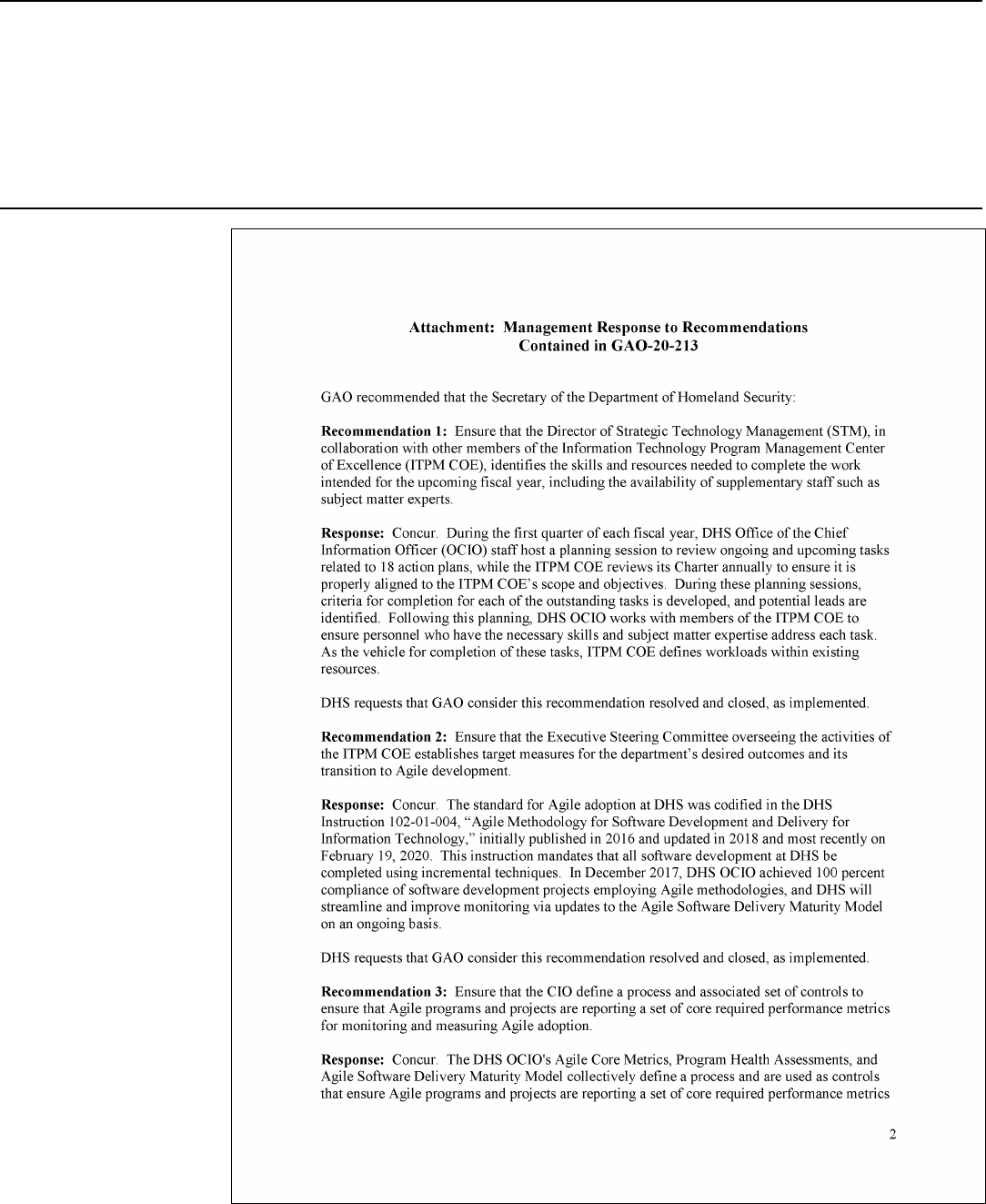
Appendix VI: Comments from the Department
of Homeland Security
Page 104 GAO-20-213 Agile Software Development

Appendix VI: Comments from the Department
of Homeland Security
Page 105 GAO-20-213 Agile Software Development
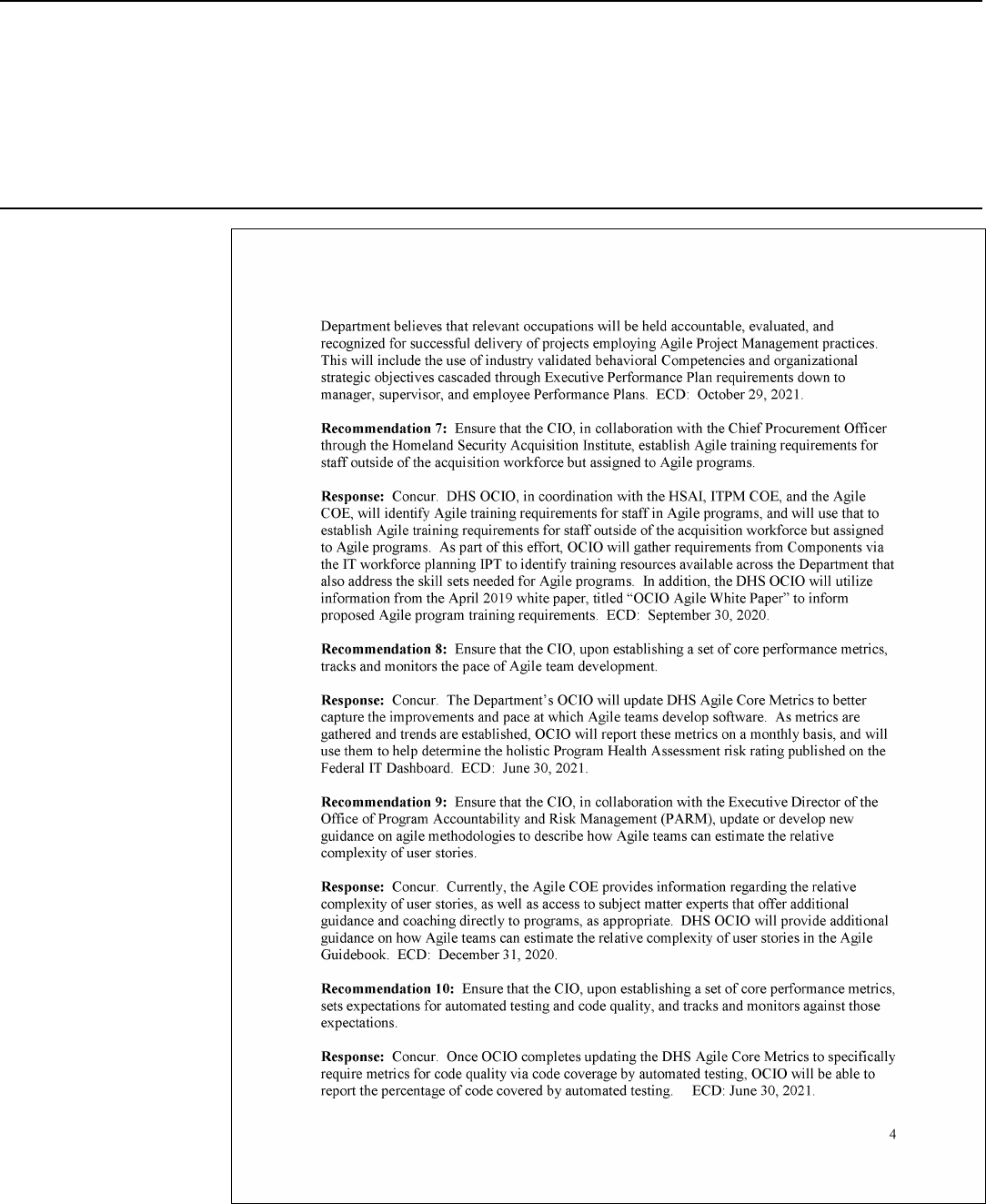
Appendix VI: Comments from the Department
of Homeland Security
Page 106 GAO-20-213 Agile Software Development

Appendix VII: GAO Contact and Staff
Acknowledgments
Page 107 GAO-20-213 Agile Software Development
In addition to the contact named above, the following staff made key
contributions to this report: Michael Holland (assistant director), Mathew
Bader (analyst in charge), Lamis Alabed, Jennifer Beddor, Christina
Bixby, Hannah Brookhart, Chris Businsky, Alan Daigle, Aryn Ehlow,
Nancy Glover, Gina Hoover, Anna Irvine, Hoyt Lacy, Jennifer Leotta,
Alexis Olson, Zsaroq Powe, Martin Skorczynski, Natalie Smith, and
Daniel Spence.
Appendix VII: GAO Contact and Staff
Acknowledgments
GAO Contact
Staff
Acknowledgments
(102504)

The Government Accountability Office, the audit, evaluation, and investigative
arm of Congress, exists to support Congress in meeting its constitutional
responsibilities and to help improve the performance and accountability of the
federal government for the American people. GAO examines the use of public
funds; evaluates federal programs and policies; and provides analyses,
recommendations, and other assistance to help Congress make informed
oversight, policy, and funding decisions. GAO’s commitment to good government
is reflected in its core values of accountability, integrity, and reliability.
The fastest and easiest way to obtain copies of GAO documents at no cost is
through our website. Each weekday afternoon, GAO posts on its website newly
released reports, testimony, and correspondence. You can also subscribe to
GAO’s email updates to receive notification of newly posted products.
The price of each GAO publication reflects GAO’s actual cost of production and
distribution and depends on the number of pages in the publication and whether
the publication is printed in color or black and white. Pricing and ordering
information is posted on GAO’s website, https://www.gao.gov/ordering.htm.
Place orders by calling (202) 512-6000, toll free (866) 801-7077, or
TDD (202) 512-2537.
Orders may be paid for using American Express, Discover Card, MasterCard,
Visa, check, or money order. Call for additional information.
Connect with GAO on Facebook, Flickr, Twitter, and YouTube.
Subscribe to our RSS Feeds or Email Updates. Listen to our Podcasts.
Visit GAO on the web at https://www.gao.gov.
Contact FraudNet:
Website: https://www.gao.gov/fraudnet/fraudnet.htm
Automated answering system: (800) 424-5454 or (202) 512-7700
U.S. Government Accountability Office, 441 G Street NW, Room 7125,
Washington, DC 20548
Chuck Young, Managing Director, young[email protected], (202) 512-4800
U.S. Government Accountability Office, 441 G Street NW, Room 7149
Washington, DC 20548
James-Christian Blockwood, Managing Director, [email protected], (202) 512-4707
U.S. Government Accountability Office, 441 G Street NW, Room 7814,
Washington, DC 20548
GAO’s Mission
Obtaining Copies of
GAO Reports and
Testimony
Order by Phone
Connect with GAO
To Report Fraud,
Waste, and Abuse in
Federal Programs
Congressional
Relations
Public Affairs
Strategic Planning and
External Liaison
Please Print on Recycled Paper.

